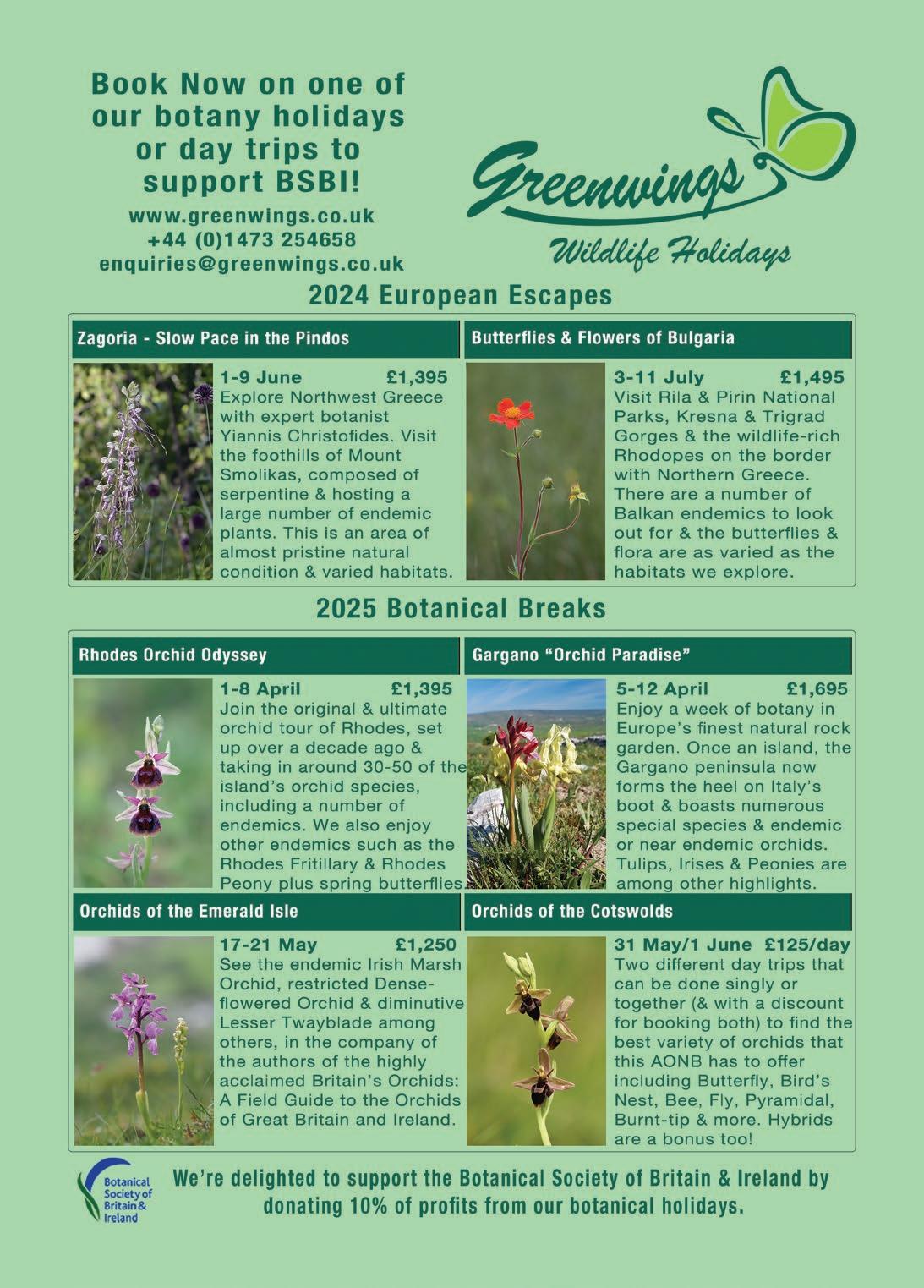NEWS BSBI
April 2024
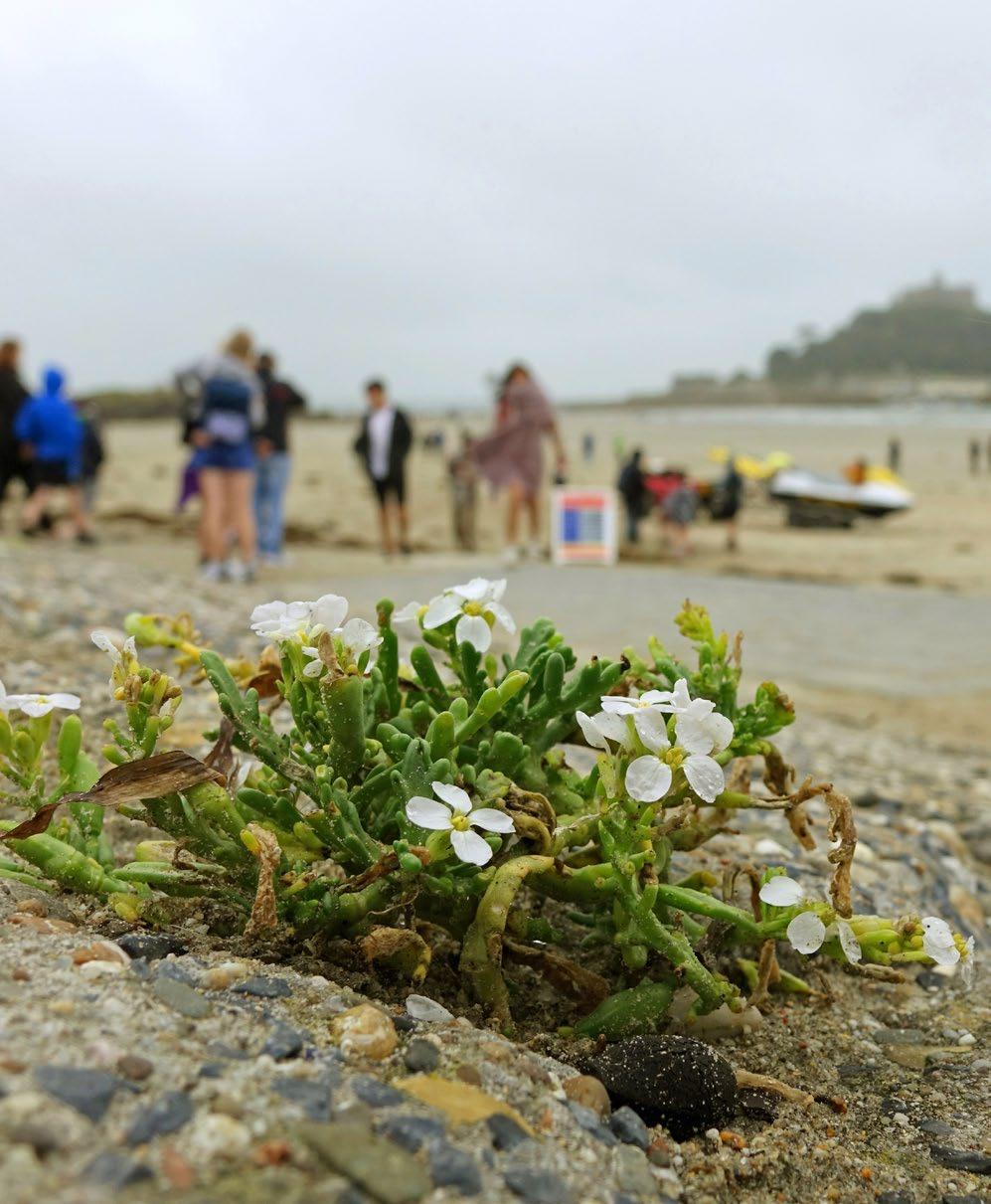
156
BSBI ADMINISTRATION
President
Chair of the Trustees
Hon. General Secretary
BSBI Company Secretary and registered address
Membership Secretary (Payment of subscriptions and changes of address) and BSBI
News distribution
Hon. Field Meetings Secretary (including enquiries about field meetings)
Panel of Referees and Specialists (comments and/or changes of address)
BSBI News – Editor
British & Irish Botany – Editorin-Chief
BSBI Chief Executive
BSBI Finance Manager (all financial matters except Membership)
BSBI Communications Officer (including publicity, outreach and website; British & Irish Botany)
BSBI Fundraising and Engagement Manager (including donations, legacies, grants and organisational support)
BSBI Head of Science
BSBI Scientific Officer (& V.c. Recorders – comments and/ or changes of address)
BSBI England Officer
BSBI Wales Officer
BSBI Scotland Officer
BSBI Ireland Officer
BSBI Countries Manager
BSBI Botanical Skills Officer (Northern Ireland)
BSBI Training Coordinator (FISC and Identiplant)
BSBI Database Officer
BSBI Data Support Officer
BSBI Book Sales Agent
BSBI website: bsbi.org
MICHELINE SHEEHY SKEFFINGTON ‘Seagal’, Ballynacourty, Clarinbridge, Co. Galway, Ireland
CHRIS MILES
Braeside, Boreland, Lockerbie, DG11 2LL
BARRY O’KANE
WMT LLP Chartered Accountants, 4 Beaconsfield Road, St Albans, AL1 3RD
GWYNN ELLIS
41 Marlborough Road, Roath, Cardiff, CF23 5BU Please quote membership number on all correspondence; see address label on post.
JONATHAN SHANKLIN
11 City Road, Cambridge, CB1 1DP
JO PARMENTER
Alpha House, 37 Station Road, Reedham, Norwich, NR13 3TB
JOHN NORTON
215 Forton Road, Gosport, PO12 3HB
STUART DESJARDINS
JULIA HANMER
65 Sotheby Road, London, N5 2UP
JULIE ETHERINGTON
Church Folde, 2 New Street, Mawdesley, Ormskirk, L40 2QP
LOUISE MARSH
SARAH WOODS
23 Bank Parade, Otley, LS21 3DY
KEVIN WALKER
Suite 14, Bridge House, 1–2 Station Bridge, Harrogate, HG1 1SS
PETE STROH
c/o Cambridge University Botanic Garden, 1 Brookside, Cambridge, CB2 1JE
SAM THOMAS
vacant
MATT HARDING
BRIDGET KEEHAN
JAMES HARDING-MORRIS
JEN FARRAR
CHANTAL HELM
TOM HUMPHREY
JAMES DREVER
PAUL O’HARA
Summerfield Books, The Old Coach House, Skirsgill Business Park, Penrith, CA11 0DJ
BSBI News: bsbi.org/bsbi-news
micheline.sheehy@nuigalway.ie
Tel. 00 353 91 790311
chris.miles01@btinternet.com
Tel. 01576 610303
HonGenSec@bsbi.org
Tel. 01727 838255
gwynn.ellis@bsbi.org
Tel. 02920 332338
fieldmeetings@bsbi.org
Tel. 01223 571250
jo.parmenter@tlp.uk.com
Tel. 07710 252468
bsbinews@bsbi.org
Tel. 02392 520828
bib@bsbi.org
Tel. 07725 862957
julia.hanmer@bsbi.org
Tel. 07757 244651
julie.etherington@bsbi.org
Tel. 07944 990399
louise.marsh@bsbi.org
Tel. 07725 862957
sarah.woods@bsbi.org
Tel. 07570 254619
kevin.walker@bsbi.org
Tel. 07807 526856
peter.stroh@bsbi.org
Tel. 01832 720327 or 01223
762054
sam.thomas@bsbi.org
matt.harding@bsbi.org
Tel. 07814 727231
bridget.keehan@bsbi.org
Tel. 00 +353 86 3456228
james.harding-morris@bsbi.org
Tel. 07526 624228
jen.farrar@bsbi.org
Tel. 07395 202879
chantal.helm@bsbi.org
Tel. 07896 310075
tom.humphrey@bsbi.org
james.drever@bsbi.org
info@summerfieldbooks.com
Tel. 01768 210793
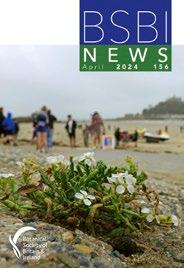
Cover photo: Cakile maritima (Sea Rocket), Cornwall by David Steere; a shortlisted entry in the 2023 Photographic Competition (see p. 79). The Botanical Society of Britain and Ireland (BSBI) is the leading charity promoting the enjoyment, study and conservation of wild plants in Britain and Ireland. BSBI is a company limited by guarantee registered in England and Wales (8553976) and a charity registered in England and Wales (1152954) and in Scotland (SC038675). Registered office: 4 Beaconsfield Road, St Albans, AL1 3RD. All text and illustrations in BSBI News are copyright and no reproduction in any form may be made without written permission from the Editor. The views expressed by contributors to BSBI News are not necessarily those of the Editor, the Trustees of the BSBI or its committees. BSBI ©2024 ISSN 0309-930X FROM THE PRESIDENT 2 ARTICLES Great Seagrass Survey 2024 Katherine Knight 3 New Year Plant Hunt 2024: thousands of participants, many taking their first steps in botanical recording Louise Marsh 5 Local groups and their contribution to BSBI Tony Marshall 8 Flowering periods are getting longer: a 15-year study from a grassland-dominated common on the western border of Surrey Dan Bosence 10 A personal 43 year taxon accumulation curve Andy Amphlett 17 New altitudinal records on Ben Nevis and Ben Macdui Jim McIntosh 23 Observations on Sparganium erectum (Branched Bur-reed) Michael Wilcox 29 Some early botanical exchanges Frank Horsman 31 BEGINNER’S CORNER Chickweeds (Stellaria Part 2) Mike Crewe 35 ADVENTIVES & ALIENS Adventives & Aliens News 32 Compiled by Matthew Berry 38 New naturalisations in coastal woodland of Exmoor (v.c. 5) Graham Lavender 49 A re-appraisal of Wolffia in Britain Richard Lansdown 51 Herniaria glabra (Smooth Rupturewort) as a pavement weed in Surrey … on the 7th floor! Jonty Denton & Molly Crookshank 55 Printed in the UK by Henry Ling Ltd, Dorchester on FSC™ certified paper using ink created with renewable materials. Contributions for future issues should be sent to the Editor, John Norton (bsbinews@bsbi.org) Using Plant Alert as part of a gardener engagement project in North West Wales Tomos Jones, Lisa Toth & Katharina Dehnen-Schmutz 56 NOTICES 59 News, events and updates on the work of the BSBI; including news of new projects and staff; dates for your diary; long-standing members; BSBI Awards 2023; members’ access to the Distribution Database; editor posts wanted; BSBI science strategy; panel of referees and specialists and panel of VCRs. OBITUARIES 66 Compiled by Chris Preston REVIEWS 76 Compiled by Clive Stace BSBI PHOTOGRAPHIC COMPETITION 2023 79 Importing PDF into Indesign Select “Show Import Options” when importing and choose “Crop to: Trim” and tick box for “Transparent Background”. This just includes the white, no arrows etc. The white box denotes the clear space the logo must have around it. Be careful when placing the logo that the white box doesn’t obscure anything. The logo below is at the minimum size allowed so cannot be reduced further but could be enlarged if appropriate, but the white background must be enlarged by the same amount too.
No. 156
CONTENTS Spring 2024
FROM THE PRESIDENT
The foremost reason I felt I had to accept the BSBI presidency is that I am only the third-ever female President. My feminist heritage would not allow me to turn it down! And I’m only the second from the Irish Republic. As I am also the first BSBI president who speaks Irish (albeit not well), I make a point of saying a few words as Gaeilge, where I can. For Plant Atlas 2020, the Welsh provided a Welsh language version of the summary, which inspired me to organise that the Irish summary document be bilingual. Such things are important to minority membership. You can access the Plant Atlas 2020 website, and download all the summaries at plantatlas2020.org
I have now, thanks to Zoom, attended meetings of all four country committees and found them very enjoyable. Each brings a different perspective to BSBI. However, three times I pointed out that the line-up for a forthcoming event was almost, or entirely, male. Our Strategic Plan includes a goal to develop equality and diversity while diversity and inclusion are mentioned over a dozen times in the Governance Handbook, so let’s start to address the issues, which should be at the forefront in all BSBI committee discussions. A good gender balance amongst leaders and speakers is a fundamental start.
I also hope to continue diversity in the presidency and was disappointed that I was not consulted about a presidential successor; I had thought of finding a Welsh speaking nominee! So I’m hoping that BSBI might formalise an alternating presidency between the four countries, with an English president every other
EDITORIAL
I’mglad to see the back of the winter weather which I think for many people was probably record-breaking in terms of the sheer amount of rain and almost complete lack of sunshine. Apart from participating in the New Year Plant Hunt (see article on p. 5) I did very little botanising over the past six months. The wet ground will benefit germination of the spring annuals in which I have a special interest, but these will soon be swamped by the more competitive grasses, which also grow well in damp soil. However, if we have another
year, in recognition of the predominance of English members, and if possible, when appointing a president from outside England, to avoid nominating someone who is in fact English. Thus, we could make one aspect of BSBI diversity even more visible. The four country committees have quite distinct BSBI approaches and priorities, so it would be nice to see this represented across the Society.
The new BSBI award recipients are hugely deserving; it’s very nice to see greater recognition for all the hard work and expertise so many freely give the BSBI. However, next year, we must ensure that some of our outstanding female members receive equal recognition.
James Harding-Morris recently told me that Lady Clermont who first found Clermont’s Spleenwort (Asplenium × clermontae) in Co. Louth (H31), was not in Wikipedia and that he has submitted a biography. Let’s find other female botanists who are not in Wikipedia and develop a site for them too.
The new BSBI recording app is fun, as I learned at the Recorders’ Meeting in Preston Montford. At present I find it useful for one-off records and I’m currently mapping a few single species such as Grey Sedge (Carex divulsa) which behaves oddly for a native to south-east Galway, and some of the ephemeral spring annuals like the Ivy-leaved Speedwell (Veronica hederifolia) subspecies and the Whitlowgrasses (Erophila species).
Micheline Sheehy Skeffington michelinesheehy@gmail.com
hot, dry summer, the grass will parch off and the cycle will begin again.
Among the varied articles in this issue is the second part of Mike Crewe’s Beginner’s Corner on Stellaria – this time covering the chickweeds (p. 35). Country Roundups takes a break but will return for the September issue.
John Norton
john.norton@bsbi.org
2 BSBI NEWS 156 | Spring 2024 FROM THE PRESIDENT
Great Seagrass Survey 2024
KATHERINE KNIGHT
Seagrasses, otherwise known as eelgrasses, are flowering plants living fully within the marine environment. Zostera marina (Eelgrass) which is usually found subtidally, and Zostera noltii (Dwarf Eelgrass) which lives in the intertidal zone, can be found in sheltered bays and estuaries around the UK. Seagrasses may be diminutive plants, often living hidden from view, but by providing a 3-dimensional structure in an otherwise barren marine landscape, they create extremely valuable habitats. According to the Ocean Conservation Trust, a single hectare of seagrass can support 80,000 fish and 100 million small invertebrates1 such as molluscs, shrimps and marine worms.
The benefits don’t stop there. Seagrass pumps oxygen into otherwise anoxic marine sediments, making them ideal for abundant animal life to thrive. Due to their aquatic location, much like peatlands, seagrass beds are highly effective carbon stores2 One hectare of Z. marina may contain up to 380 tonnes of carbon3. Seagrass accounts for 10% of the ocean’s capacity to store carbon, despite occupying only 0.2% of the sea floor. It is thought to be able to capture carbon from the atmosphere up to 35 times faster than tropical rainforests4. As well as this, seagrass meadows dissipate wave energy, aiding coastal protection and absorb nitrogen from the water column.
Like so many ecosystems, seagrass meadows are under threat. It is estimated that since the 1930s, up to 90% of Zostera marina beds have been lost1 The International Union for the Conservation of Nature estimated that seagrasses are declining by 7% a year globally. This estimate makes it the fastest disappearing habitat on the planet5,6
However many of these studies are based on species distribution modelling. Observational records of seagrasses, both historically and current, are very few and far between. It is astounding that a habitat which is so important, exists right here in the UK, but

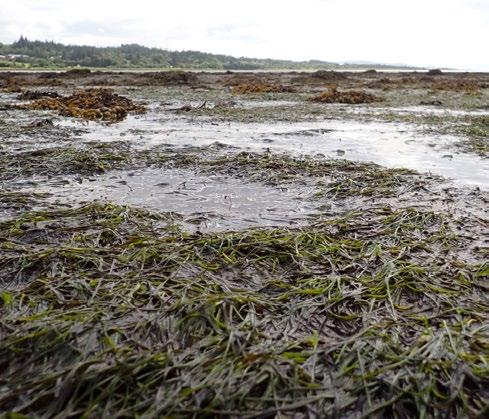
Seagrass (Zostera) exposed at low tide. Seawilding
that we know so little about its location and extent. The BSBI holds some of the most comprehensive records of seagrass in the UK but more information on the current distribution of seagrasses is required to ensure adequate understanding and protection.
To address this lack of data, the marine habitat restoration charity, Seawilding, and the British Sub Aqua Club, (BSAC), have teamed up to create the Great Seagrass Survey. They would like you to visit sheltered areas of coastline and estuaries and record your seagrass findings. The project has a web-based recording form where you have the options to record
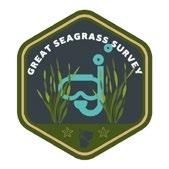
presence and, equally importantly, absence, map the perimeter of the seagrass bed and even undertake health surveys by conducting shoot counts.
BSBI NEWS 156 | Spring 2024 3
Great Seagrass Survey 2024
By knowing where seagrass is currently we can learn more about the threats it is facing as well as what is required to conserve it. All of the data collected are shared with national databases, making it accessible to scientists and policy makers. The project map shows the locations of the seagrass beds mapped by volunteers so far on its interactive map: qgiscloud.com/eric_seawilding/Great_Seagrass_ Survey_2023
There are still many unrecorded seagrass beds out there, along with areas where seagrass has historically been reported but it is unknown if it is still persisting. The Great Seagrass Survey aims to encourage as many people as possible to get involved and help to discover more in 2024.
Although seagrass is a marine plant and the intrepid may wish to undertake their surveys by snorkel, much of it can be seen and recorded from
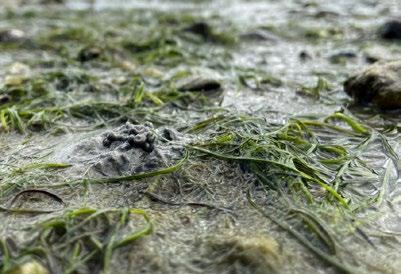
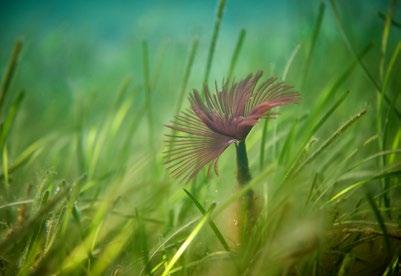
the shore at low tide. All of the information on how to get involved can be found on the project website: seawilding.org/great-seagrass-survey . This includes instructions on how to complete the surveys, a guide to seagrass identification, helpful tips and safety information.

The Great Seagrass Survey is encouraging volunteers to organise seagrass surveys on the May Bank Holiday weekend, 25–27 May 2024. However, seagrass can be recorded outside these times and data submissions to the project are welcome throughout the summer.
References
1 Ocean Conservation Trust (website), Why is Seagrass important?: oceanconservationtrust.org/ocean-habitats/whyseagrass
2 Mishra, A, Apte, D. & Farooq, S.H. 2021. Ecological connectivity of seagrasses with mangroves increases the carbon storage of tropical seagrass meadows of an island ecosystem. Research Square preprint. doi.org/10.21203/ rs.3.rs-839297/v1
3 Seagrass Ocean Rescue (website), Why Seagrass?: projectseagrass.org/why-seagrass
4 UN Environment Programme (website), 2019, Seagrass – secret weapon in the fight against global heating: unep. org/news-and-stories/story/seagrass-secret-weapon-fight-againstglobal-heating
5 Björk, M., Short, F., Mcleod, E. & Beer, S. 2008. Managing Seagrasses for Resilience to Climate Change, International Union for the Conservation of Nature, Gland, Switzerland.
6 Hughes, A.R., Williams, S.L., Duarte, C.M., Heck, K.L. & Waycott, M. 2009. Associations of concern: declining seagrasses and threatened dependent species, Frontiers in Ecology and the Environment 7(5) 242–246.
Katherine Knight
Seawilding
katherine@seawilding.org
4 BSBI NEWS 156 | Spring 2024
A healthy Zostera marina bed (with peacock worm). Seawilding
Great Seagrass Survey 2024
Zostera noltii (Dwarf Eelgrass) at low tide. Seawildling
New
Year Plant
Hunt
2024:
thousands of participants, many taking their first steps in botanical recording
LOUISE MARSH
The BSBI’s thirteenth New Year Plant Hunt (NYPH) took place between Saturday 30 December 2023 and Tuesday 2 January 2024. It attracted a record number of participants – 3,336 volunteers – who used smartphones and an online recording form to submit lists of native and nonnative plants found in bloom in the wild during a three-hour walk at locations throughout Britain and Ireland. In total, 2,205 lists were submitted, comprising 21,096 records of 629 plant species in bloom. This total excludes 40 lists where, despite assiduous searching at altitude and/or in inclement weather, Hunts yielded no records of plants in flower.
Full breakdowns and analyses of results from this and previous years’ Hunts, along with the methodology, press coverage, etc. can be found at bsbi.org/new-year-plant-hunt. You can also visit the NYPH micro-site at nyph.bsbi.org where you will find an interactive map – clicking on a marker will bring up a list of the species recorded at that location. The micro-site also features a Results page where you can see at a glance the Top 20 Longest Lists and Most Frequently Recorded Taxa.
The aim of this article, however, is to look at the differences and similarities between 2024’s results and those of previous years, and to consider what the underlying reasons might be.
Similarities to previous years
In 2024, as in previous years, more species were flowering late (53%) rather than early (27%), as opposed to 20% which would either be expected to flower at New Year or are typical ‘all-year-rounders’. These proportions of species flowering early, late or as expected were broadly similar to previous years, suggesting that the majority of plant species flowering out of season are ‘autumn stragglers’ such as Achillea millefolium (Yarrow), Jacobaea vulgaris
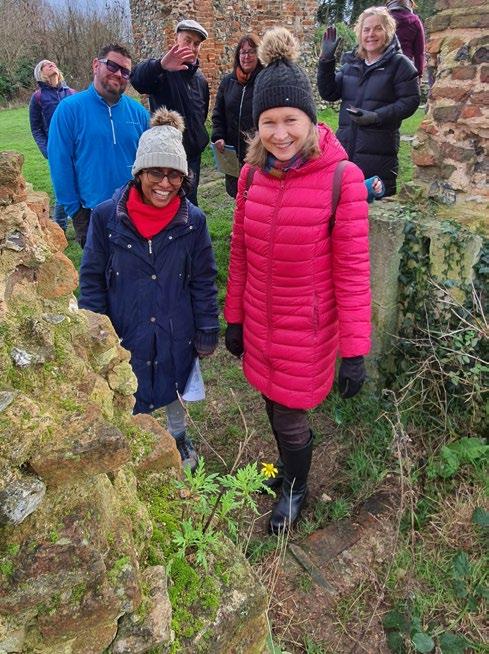
(Common Ragwort) and Lamium album (White Deadnettle), that continue to flower in the winter.
The three most frequently recorded species were also the same as in previous years: Bellis perennis (Daisy), Senecio vulgaris (Groundsel) and Taraxacum spp. (Dandelion).
On examining the Top Twenty Longest Lists on the NYPH website and comparing them against
BSBI NEWS 156 | Spring 2024 5
New Year Plant Hunt 2024
Members of Grow Community, Sopwell, St Albans, with Senecio squalidus (Oxford Ragwort). Image courtesy of Grow Community – Sopwell
Longest Lists from previous years, we find that once again more species were recorded in bloom in the milder southern and coastal areas. The highest totals were logged by seasoned recorders and botanical recording groups, often following the same route as in previous years, e.g. the longest list of 100 species recorded by David Leadbetter in Swanage; 87 species recorded in Caister-on-Sea by the Norfolk Flora Group; 81 species recorded in Taunton by Simon Leach and 78 species recorded in Mevagissey, Cornwall, by the Three Bays Wildlife Group. Urban and suburban habitats also tended, as in previous years, to have more ‘garden escapes’ and other nonnative species in flower than rural areas, as there are more sheltered and disturbed places with warm microclimates where alien plants can thrive: the ‘heat-island’ effect.
What was different this year – and why?
The most striking differences were:
• the much higher number of participants in 2024: 3,336 people took part, a 97% increase compared to last year (1,691 participants) and the highest total in NYPH’s history;
• 2,616 people pre-registered to take part in NYPH 2024 – 1,985 (75%) were non-members who had no previous engagement with the BSBI;
• the higher number of records received: 21,096 records in 2024 compared to 10,199 in 2023, an increase of 107%;
• the higher number of lists received: 2,205 lists in 2024 compared to 1,002 in 2023, an increase of 120%;
• there were more species recorded in bloom: 629 plant species in 2024, a 30% increase compared to last year (482 species) and the third highest total in NYPH’s history.
The decision was taken last autumn to invest more time and effort into advance promotion of NYPH, particularly to new audiences, and to the provision of resources to help support plant-spotters taking part for the first time (and often with very limited plant ID knowledge). A pre-registration
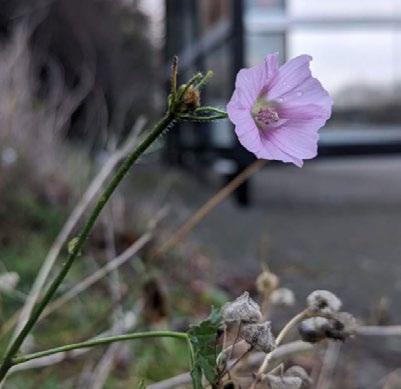
facility was set up on the BSBI website and digital resources including spotter sheets and guidance on how to photograph plants for identification were made available to participants. A dedicated webpage was set up, listing group hunts across Britain and Ireland, and NYPH newcomers were encouraged to consider joining a group hunt.
We also reached out to organisations including the BTO, RSPB, Plantlife and several county Wildlife Trusts, who agreed to advertise NYPH to their members on websites and in eNewsletters. The increased publicity ahead of this year’s event, the new spotter sheets, the resumption of group hunts (now that the threat of Covid has diminished) and the guidance and support on offer in the run-up to and during the Hunt, all helped those taking their first steps in plant identification or citizen science to submit their data and feel reassured that their contributions were valued.
The 30% increase in the number of species recorded in bloom during the 2024 NYPH compared to the 2023 NYPH is likely to be linked to unusually mild and wet weather across much of Britain and Ireland in December 2023 when, according to Met Office data, the temperature was 2.8 degrees above average. This contrasts with the severe frosts experienced in early December 2022, which saw
6 BSBI NEWS 156 | Spring 2024
New Year Plant Hunt 2024
A late-flowering Malva moschata (Musk Mallow) in Newcastle. James Common
the coldest winter since 2010. These temperature anomalies were however taken as averages from the whole of the UK; they don’t include data from the Republic of Ireland and they don’t reflect UK regional differences. Many recorders in Scotland and northern England submitted ‘null record’ lists this year or reported being unable to go out recording due to snow or flooding from Storm Henk.
There were no huge surprises in this year’s Top 20 List of Frequent Plants compared to the 2023 list but there were three new arrivals on the List: Ficaria verna (Lesser Celandine), Jacobaea vulgaris (Common Ragwort) and Crepis capillaris (Smooth Hawk’sbeard), which displaced Sonchus oleraceus (Smooth Sow-thistle), Heracleum sphondylium (Hogweed) and Hedera helix (Ivy).
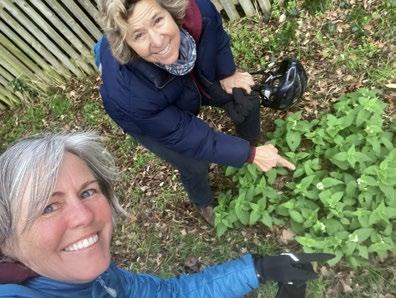
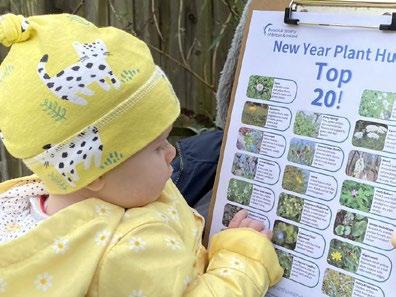
Michael Jones’ 8-month old daughter examines the New Year Plant Hunt spotter sheet. Michael Jones
What next for the NYPH?
We plan to build on the NYPH’s success as the Society’s flagship outreach event, helping participants as they take their first steps in botanical recording and thereby introducing them to BSBI’s resources and activities to help them build up their knowledge, skills and confidence. We are also looking at how to continue to support long-term participants whose data are so crucial in helping us build up a clearer picture of how our wild and naturalised plants are responding to changes in autumn and winter weather patterns.
So, whether you are one of the thousands of people who have contributed to NYPH over the years, or you’re a new member who took part in NYPH and are now keen to continue your botanical journey, we’d like to say a huge thank you to you. We hope that you will all take part in our fourteenth NYPH and we’ve already set the dates: it will run from Sunday 29 December 2024 to Tuesday 1 January 2025. Save the dates now and watch out for more details, and more resources, on the BSBI website: bsbi.org/new-year-plant-hunt
Acknowledgments
BSBI would like to thank everyone who participated in the 2024 New Year Plant Hunt, particularly volunteers Joni Cooke (who has since joined BSBI Events & Communications Committee); Moira O’Donnell and Jo Parmenter (BSBI Science & Data Committee). They worked alongside me and fellow BSBI staff members James Drever, James HardingMorris, Tom Humphrey, Bridget Keehan and Sarah Woods on the Support Team, giving up their time over the New Year holiday to help with plant ID enquiries, enter data, answer emails and engage with plant hunters on social media. Huge thanks to all of them for making this thirteenth New Year Plant Hunt such a huge success.
Louise Marsh
BSBI Communications Officer
louise.marsh@bsbi.org
BSBI NEWS 156 | Spring 2024 7
New Year Plant Hunt 2024
Lucy’s first New Year Plant Hunt. Lucy Jones
Local groups and their contribution to BSBI
TONY MARSHALL
Iwritefrom the perspective of one local group, that of the Central Chilterns of Buckinghamshire (v.c. 24 in part). The group was started in 2021 and it has a programme of fortnightly field meetings through the green summer period and others less frequently in the brown time of year. The original group were all resident in the area west from Great Missenden to Speen, north of High Wycombe. The meetings were led by one or, almost always, two members who could pretend to some knowledge of botany, one as a qualified botanist who teaches introductory courses in the subject (Karen van Oostrum), and the other with long experience (40 years) of surveying plants and their occurrence in the core area (Tony Marshall). Other members have keen interests in botany but with different levels of knowledge. The principal aims of the group are to share knowledge, impart skills, and introduce members to the varied plant life and habitats of the Chilterns, but there were always other aims. While we were there for the enjoyment of exploring with like-minded individuals and sharing discoveries, we also wanted to make a scientific contribution to botanical knowledge, both of the Chilterns and more generally, about which more below. In our second year we were generously allowed space on the BSBI website to publicise our programme for the coming year and to provide reports on the achievements of each field meeting. This has resulted in a doubling of our membership and a widening of our geographical base, although our core area still provides most of the venues for our meetings.
As far as our social aims go, the group provides easily accessible events that minimise the effects of travel on the environment. The marvellous programme of field meetings provided by BSBI nationally is largely inaccessible to members, as very few are in Bucks or anywhere near. Personally I can only make one or two a year. The local group fills
this gap and also allows more in-depth learning of the botany of a particular area and climate. Some events are mainly for enjoyment. Each year, for instance, we now have one event in which members are challenged to find, in a limited area, as many as possible of plants mentioned in a particular poem, starting in 2023 with the famous lines from Oberon’s poem in A Midsummer Night’s Dream beginning ‘I know a bank whereon the wild thyme blows’. (Not only did members find all the flowers mentioned, but they also used their imaginations to find various of the fairies featured in the tale!)
Even in the case of the more general walks (let’s go here and see what there is), we always keep a record, either of the more notable plants found, or more usually a general list of all those that could be identified. In some cases we have set out to record all plants at a particular site. These records are entered in a database that covers the plants and all other orders in the roughly 100 square kilometres of our core area. This database was started in the 1980s by the author and now has over 21,000 plant records generated locally, plus a similar number, mostly of older surveys, from the county environmental records centre, covering 1,379 species. This, coupled with targeted surveys and special studies, has helped me to write ‘The Ecological Flora of the Central Chilterns’1
The database also provides the basis for organising many of the meetings – sites under-recorded or with no records since the last century, old records of rare plants that should be followed up. In this way we are continually updating the records and establishing the current status of all species locally.
Other events are organised around improving our knowledge of particular plants. Our very first event,
1 (available at: dropbox.com/sh/5kkazz7vjhgimpw/ AAB0h_3pMFAIHI_8PBb82U1ta?dl=0)
8 BSBI NEWS 156 | Spring 2024 Local groups and their contribution to BSBI
in fact, jumping in the deep end on April Fool’s Day 2021, was a search for long homostyles of Primula vulgaris (Primrose) at a site where they had last been recorded in 1947 by the botanist J.L. Crosby. While this seemed likely to be indeed a fool’s errand, we did locate the original colony and established its survival, and we were able to examine the frequency of occurrence of different combinations of short and long styles and stamens. We followed this up with visits to other sites with Primrose colonies, but very rarely found any long homostyles. We also discovered that the plants with more frequent short homostyles were almost entirely garden escapes.
We have also searched for all extant colonies of Helleborus viridis (Green Hellebore), trying to elucidate why they had such a limited distribution in our area while being abundant at the sites where they did occur. It soon became evident that the primary needs of the plant were shade (hence it is a woodland species) and high levels of calcium in the soil. The latter provided the key to understanding the strange distribution. Most woodlands in the area are on the clays, their lower margins occurring along the narrow line of the geological strata known as ‘chalk rock’, below which the land had usually been cleared for agriculture. All our local colonies occurred, without exception, where ancient woodland extended unusually below the chalk rock layer, where the pH was very high, but trees provided the necessary shade. As this seldom happened it explained the small number of hellebore colonies and their apparently random distribution. (It has also been noted that Helianthemum nummularium (Common Rock-rose) in our area only occurs along the line of the chalk rock or just below, wherever a grass margin has always been left at the top of the field.) The importance of observing the position of the chalk rock stratum as it winds around the Chiltern Hills has seldom been noted heretofore.
We have also been concerned to improve our abilities as a group to distinguish some critical species. A study of wild apples Malus domestica (Apple) and M. sylvestris (Crab Apple) determined that very few specimens were the latter and that earlier records have often over-recorded it. We have also
Local groups and their contribution to BSBI
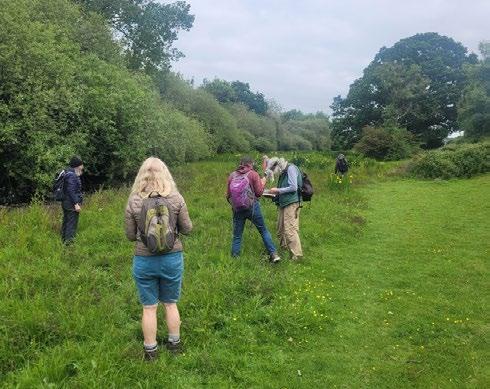
conducted surveys of wild roses Rosa spp. using the latest key (one hedgerow containing 8 different taxa); examined colonies of Hypericum spp. (St John’s-worts) with particular reference to the hybrid H. × desetangsii and concluded that all previous local records for Polygala calcarea (Chalk Milkwort) were probably erroneous, having searched all relevant sites and finding only P. vulgaris (Common Milkwort), even though the habitats had not deteriorated. We sadly found that all previous colonies of native Alchemilla (Lady’s-mantles), of which at least A. xanthochlora (Intermediate Lady’s-mantle) had survived until very recently, were sadly now extinct due to a combination of habitat desiccation and destruction, a double whammy.
This mix of enjoyable browsing and scientific work will continue in the 2024 programme and new members are welcome, even if they can only join us for one or two events (e-mail below). Members receive regular updates on the programme and reports on events. Registration for field meetings is necessary to keep numbers to a reasonable number, but has not yet meant anyone has been turned away.
Tony Marshall Member of Central Chilterns Botany Group ecorocker@gmail.com
BSBI NEWS 156 | Spring 2024 9
A group meeting at Cock Marsh, Buckinghamshire. Clare Padmore
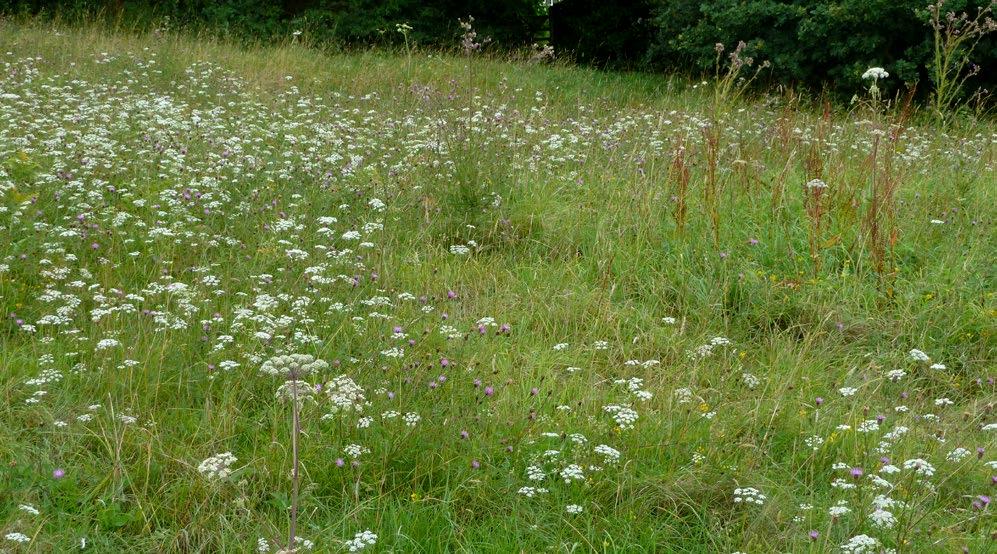
Flowering periods are getting longer: a 15-year study from a grassland-dominated common on the western border of Surrey
DAN BOSENCE
This article describes the results of 15 years of weekly recording of flowering times on Bealeswood Common in western Surrey (v.c. 17). Just under 200 species have been recorded as first flowering dates, last flowering dates and flowering periods over the 52 weeks of the year. The total numbers of species in bloom for each week of the year shows the expected trend of increasing numbers through the late winter and spring to a mid summer maximum of between 40–80 species. The length of this midsummer peak flowering ties in with weather records and is cut short in the recent hot and dry summers. Numbers then tail off to the early winter low.
A more detailed analysis of 100 frequently recorded species shows that the most common pattern of flowering times is of inter-annual variability, frequent non-flowering years but no overall trends. However, one quarter of these species show, on average, a trend of increasing flowering periods over the past 15 years. This is accounted
Dry grassland community at Bealeswood Common, Surrey (v.c. 17) including Conopodium majus (Pignut) and Centaurea nigra (Common Knapweed).
Dan Bosence
for by progressively later last flowering dates over the study period, rather than the more commonly cited trend of earlier flowering dates recorded in the literature. Longer-term studies throughout the UK (e.g. Büntgen et al., 2022) report first flowering dates are one month earlier than in the 1950s and that this correlates with late winter to spring maximum temperatures.
It is hoped that this study will lead to comparisons with other similar collections of records that may lead to an understanding of the underlying causes of such trends and patterns in flowering.
Bealeswood Common
Bealeswood Common is an approximately 4-hectare (just under 10 acres) site on the western fringe of Surrey, noted for its ancient grasslands. It is elongate
10 BSBI NEWS 156 | Spring 2024
Flowering periods are getting longer
in an east-west direction on a south-facing slope surrounded by the village of Dockenfield (Figure 1). The underlying strata comprise the Gault Clay Formation of late Cretaceous age with the higher ground (around Batt’s Corner) being capped with Quaternary river terrace deposits and drift with a mix of gravels, sands and clay.
This small site includes a range of habitats: ancient grassland, woodland, scrub, marsh, ditches, verges and a pond. It has a diverse fauna and flora, as recorded by the Bealeswood Wildlife Recording Group (BWRG) that is available at dockenfieldpc.org. uk/wildlife. The Common is a county wildlife site (SNCI), has a Green Flag Award and is located within the Surrey Hills Area of Great Landscape Value (AGLV). Access is by local lanes, bridlepath and footpaths and the site has no designated parking. Management is by Waverley Borough Council and Dockenfield Parish Council and mainly entails a late summer grassland cut, scrub clearance, and periodic pond dredging.
Methods
The herbaceous flowering plants have been recorded for this work on a weekly basis, continuously from 2009 to 2023. The records do not include shrubs, trees or any non-flowering plants. Grasses, sedges and rushes have only recently been recorded (2021 onwards). In total, just under 200 species of flowering herbs have been identified. Because of the proximity of the site to surrounding gardens, there are a number of non-native species which are also recorded. These are classified as archaeophytes (8%), neophytes (7%) or ‘recents’ (5%), i.e. known arrivals from adjacent gardens within last 40 years, giving a total of 20% non-natives. This compares favourably with the over 50% of non-natives reported as a national figure in Stroh et al. (2020) and may reflect the Common’s long history as nondisturbed grassland and woodland.
The recordings are presences or absences of flowering, thus giving a first flowering date (FFD, for the week in which the first flower is observed,
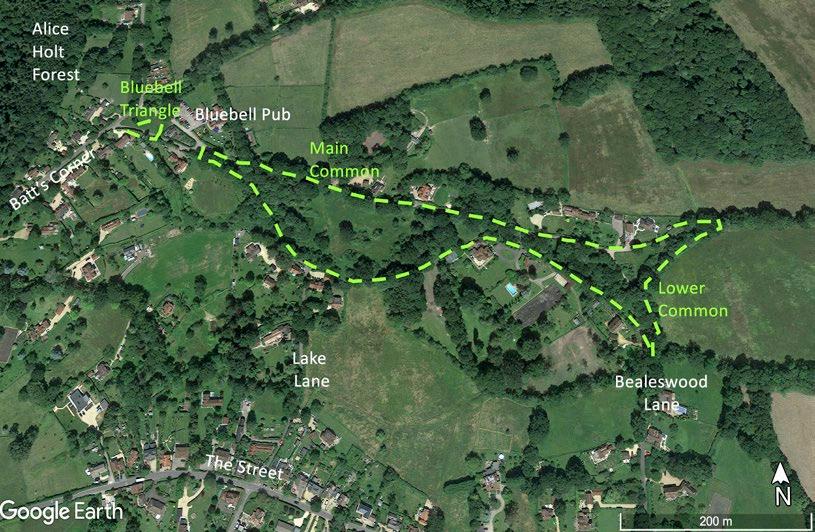
BSBI NEWS 156 | Spring 2024 11
Figure 1. Bealeswood Common lies near the centre of the village of Dockenfield. It is fringed by houses, gardens, fields and is accessible from The Street, Batt’s Corner, Bealeswood and Lake lanes. © Google, 2024.
Flowering periods are getting longer
fully open), a last flowering date (LFD, for the week when petals have fallen from the last observed flower) and a flowering period (FP; LFD week minus FFD week). Where two flowering periods are recorded in the same year they are treated as one FFD and one LFD. No attempt is made to assess and record abundance or location of flowers but all fall within two OS 1 km grid squares (SU8240 and SU8241).
Because of the large dataset the number of species included in this article is analysed in two different ways. Initial observations and comments are based on the entire floral record (<200 species over 15 years). Subsequent analysis is based on 100 selected species from 31 families. The species removed for this analysis are those that: (a) occur very infrequently, (b) are recents, or (c) have not been recorded for the entire 15 years (grasses, sedges and rushes). For each week (1–52) of each year (2009–2023) the FFD, LFD and FP for these 100 species has been recorded. A portion of the spreadsheet for 20 species from the first eight families is given in Figure 2 for the years 2009 to 2012 as an example. These data are assessed to see if there are any trends in FFDs and FPs over the 15 years. A trend is arbitrarily assigned if a linear regression
line for any species changes in FFD, LFD or FP by 2 weeks or more over the 15 years. For clarity the regression lines are not shown on the graphs.
Results
Entire floral record (<200 species) for 2009–2023
An overview of the annual flowering on the Common is obtained by plotting the number of flowers in bloom for each week of the year for these 15 years (Figure 3). The graph’s lines overlap, are messy and it is clear that they are very variable from year to year and this overview is just presented to show the pattern of flowering on the Common through the seasons. The overall trend is, as expected, showing an increase in flowering from winter through to midspring with little inter-annual variation, increasing to a maximum species flowering through the summer and then a decrease, as they set seed and die off, through the autumn and into the winter. These endof-season flowering records are more variable than those from early in the year. Despite the noise in this graph, the time of the year when most species can be seen flowering on the Common is late June
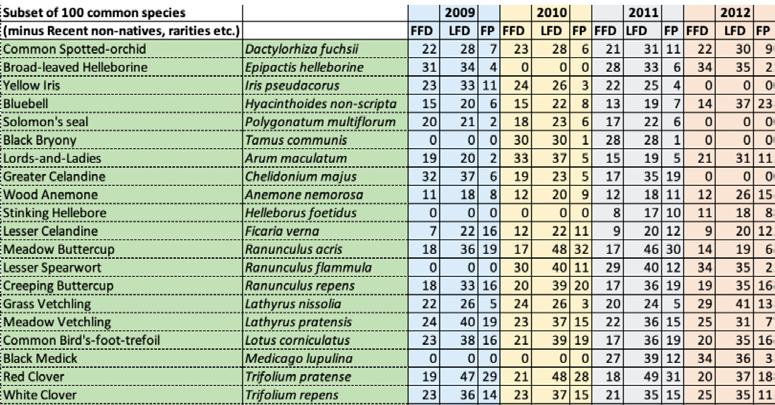
Figure 2. Portion of dataset to illustrate 20 of the selected 100 species recorded on a weekly basis (0 = not recorded flowering, 4 = recorded flowering in week 4 of year, etc.) for years 2009–2012 (FFD= First Flowering Date, LFD = Last Flowering Date, FP = Flowering period).
12 BSBI NEWS 156 | Spring 2024
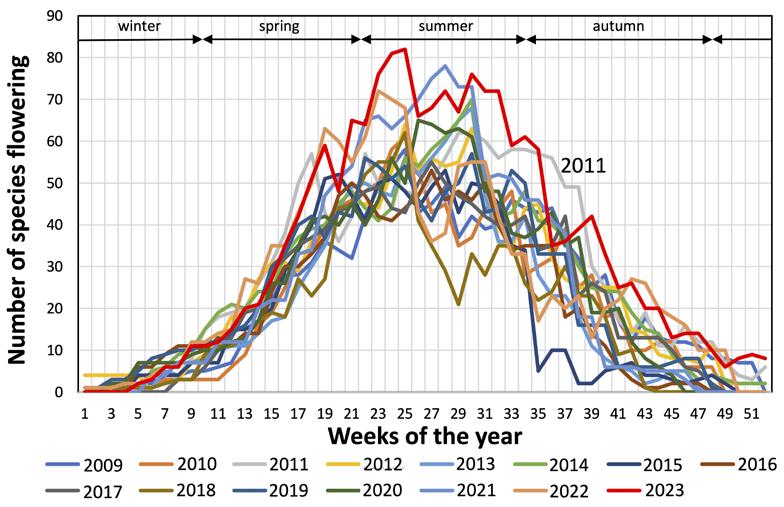
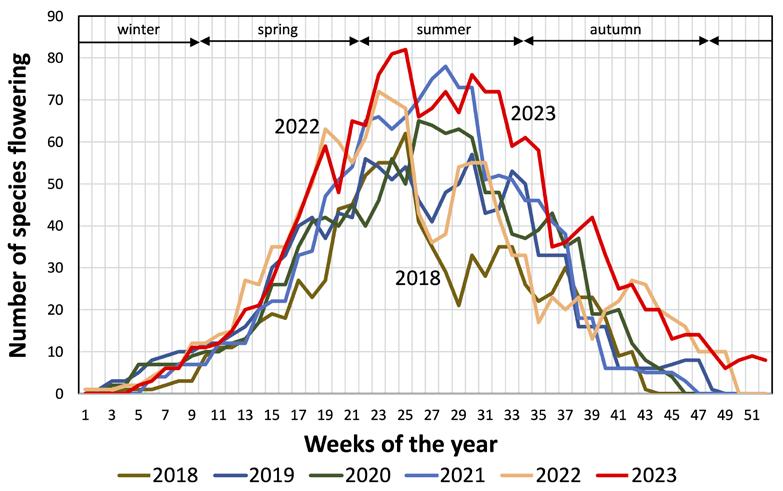
Figure 4. Numbers of species in bloom for each week of the year (1–52) from 2018 to 2023. The hot dry summers of 2018 and 2022 show a rapid drop off in numbers of flowers in bloom, whereas the hot, but wetter, summer of 2023 shows an extension of flowering periods through to the autumn.
BSBI NEWS 156 | Spring 2024 13
periods are getting longer
Flowering
Figure 3. Numbers of species in bloom for each week of the year (1–52) from 2009 to 2023. Although messy the graph illustrates the pattern of flowering on the Common through the seasons.
Flowering periods are getting longer
to early July and the peak is often found to be week 25, the week of Midsummer’s Day.
The causes behind the variability shown in the 15 years of recording become apparent if the results from a smaller number of years are displayed (2018–2023, Figure 4). Three of these years stand out and are worthy of comment. With record breaking temperatures in the summer of 2022, the normal vibrant summer flowers on the Common turned brown. Indeed, the annual late summer cut of the Common grasslands was brought forward because of a perceived fire risk from the pervading crisp brown foliage. This is reflected in the fall off in the number of flowers in bloom in the orange line for 2022 between weeks 24 to 27 (late June–mid July). However, when the late winter and spring flowers of 2023 (red line) were recorded all the usual species not only came into bloom but flowered at about the same time as the previous years’ average first flowering dates. A similar drop in the number of species flowering in mid summer was recorded after the hot and dry summer of 2018 (brown line) with just half the normal numbers of flowering herbs recorded for late in that July.
The summer of 2023 also broke temperature records, but these were interspersed with periods of rainfall. The red line on the graph for 2023 stands out from all the previous 14 years’ records with unusually high numbers of flowers blooming through June, July and August. Flowers died off during September and October in trend with the previous years but this mild winter (with only minor frosts through to year’s end) is reflected in a record number of nine species in flower in the last week of the year: Cardamine flexuosa (Wavy Bittercress), Ranunculus flammula (Lesser Spearwort), Vinca minor (Lesser Periwinkle), Taraxacum agg. (Dandelion), Jacobaea vulgaris (Common Ragwort), Achillea millefolium (Yarrow), Lapsana communis (Nipplewort), Ficaria verna (Lesser Celandine) and Lamium album (White Dead-nettle. The Ficaria verna record is the earliest date for this species in the 15 years of recording, with previous first flowering dates frequently in the first or second week of February. This early date was also reflected in a very early flowering date of late
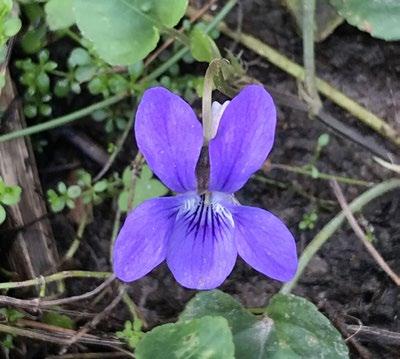
Viola riviniana (Common Dog-violet), flowering on 24 October 2023. Dan Bosence
October (2023) for a single Viola riviniana (Common Dog-violet) on the Common (see photo).
Selected floral record (100 species) for 2009–2023
For the 100 species selected for more detailed analysis the first flowering dates (FFDs), last flowering dates (LFDs) and flowering periods (FPs) have been studied over the last 15 years. Two main patterns or trends have been identified:
1. Inter-annual variability but no long-term trends. The commonest pattern of flowering is considerable inter-annual variability in both FFD and FP. This is shown, for example, for species recorded from the Iridaceae, Asparagaceae, Dioscoreaceae, Araceae and Papaveraceae (Figure 5A, 5B). Although these year-by-year records are variable, with the exception of Chelidonium majus (Greater Celandine), they do not show any noticeable trends of change over the 15 years. FFDs and FPs frequently vary by up to 20 weeks from year to year and occasionally species are not recorded flowering. For example, in 2012 Iris pseudacorus (Yellow Iris), Chelidonium majus and Tamus communis (Black Bryony) were not recorded flowering on the Common and hence scored zero for FFD and FP (Figure 5A, 5B). Similarly, other species also show reduced or zero flowering weeks in 2012 (Figure 5C). This followed
14 BSBI NEWS 156 | Spring 2024
Flowering periods are getting longer
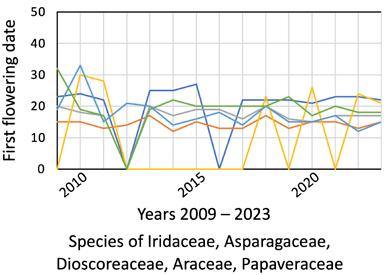
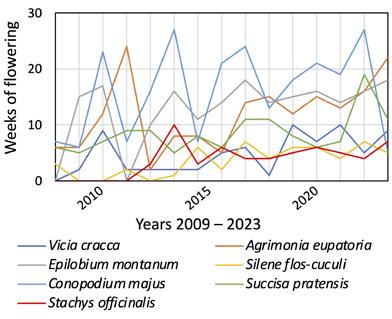
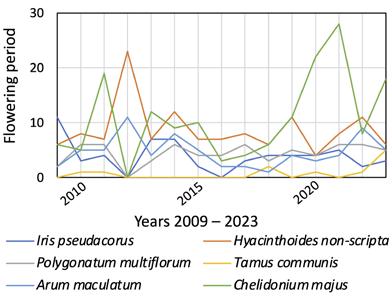
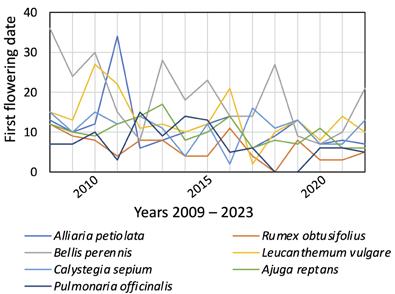
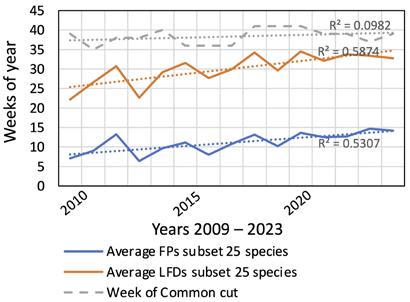
Figure 5. (A) First flowering dates (FFD, in weeks of the year) of selected species of the Iridaceae, Asparagaceae, Dioscoreaceae, Araceae and Papaveraceae through the years 2009–2023 showing interannual variability but no longer term trend of increasing or decreasing FFD. (B) Flowering periods (FP) for same species as (A), showing similar large variability including some years with no flowering as in 2012 as discussed in text. (C) Examples of species showing an increase in the period of flowering (FP) in weeks against 15 years of recording for seven named species. (D) Examples of FFDs for seven selected species that show progressively earlier flowering dates through 2009–2023. (E) Graph to show noticeable increases in both FPs and LFDs of subset of 25 species (see text) over the 15 years of study (note; these increases do not correlate with timing of annual grass cut on common).
BSBI NEWS 156 | Spring 2024 15
A C D E B
Flowering periods are getting longer
an unusual pattern of flowering in the previous year (2011) when the maximum flowering season was particularly long, extending from late spring to early autumn (Figure 3) and continued with higher than average numbers of flowers in bloom through later weeks into autumn and late winter. The reduced flowering in 2012 was possibly a knock-on effect of the extended flowering of 2011; a year recorded as the second warmest on record and the warmest-ever October day at that time for the UK.
2. Trends of increased flowering periods and earlier and later flowering dates. As well as showing the pervasive pattern of inter-annual variability, one-quarter (25 out of the 100 selected species) show evidence of a long-term trend over the 15 years of study. This is expressed as an increase in the number of weeks flowering (Figure 5C), with some species flowering 10–20 weeks longer over the period of study. Encouraging in these data are the increase in FPs of two red-listed species; Silene floscuculi (Ragged-robin) and Succisa pratensis (Devil’s-bit Scabious). The increase in FP can be accounted for by some species that have earlier flowering dates (FFDs). Examples are given in figure 5D; notably Bellis perennis (Daisy), Leucanthemum vulgare (Oxeye Daisy) and Rumex obtusifolius (Broad-leaved Dock). However, if the averaged FPs and LFDs of all the 25 species are plotted for each year it is seen that the year-on-year increase in the average FP is accounted for by later and later LFDs over the study period (Figure 5E), but these do not correlate with later timings of cutting of the Common.
Conclusions
This study, is based on a large dataset (52 weekly records of just under 200 species over 15 years), but is relatively short for phenological studies; however, the data shows patterns and trends in variability of flowering times that are not frequently reported and are summarised below.
• The total numbers of species in bloom for each week of the year shows the expected trend of increasing numbers through the late winter and spring to a mid summer maximum and then a tail off to the early winter low. The length of
this mid summer peak flowering ties in with weather records and, specifically, has been cut short in the recent hot and dry summers. Conversely, warm and wet summers and mild winters extend the mid summer peak and result in more winter flowering.
• A subset of 100 selected species (excluding grasses/sedges/rushes, infrequently flowering herbs and recent garden escapes) indicates that the commonest pattern of flowering is interannual variability of First Flowering Dates (FFDs), Last Flowering Dates (LFDs) and Flowering Periods (FPs) but with no overall trends. This includes years when the species do not flower and, in years that follow a year with long FPs, species have reduced FPs or do not flower.
• Twenty-five of these selected 100 species indicate a trend of increasing numbers of weeks of flowering (FPs) over the 15 years and whilst, in some cases, this is tied to earlier FFDs, the average LFDs of these species indicate that this increase in flowering period is the result of progressively later last flowering dates. These results are at variance with the national figures of progressively earlier FFDs reported in the literature (Büntgen et al., 2022).
• Over the 15 years of recording most species of plants flowering on Bealeswood Common show considerable interannual variability of flowering dates. However, 25% of species show a trend of increasing flowering period that correlates with later and later last flowering dates.
References
Büntgen, U., Piemattei, A., Krusic, P.J., Ester, J. Sparks, T. & Crivellaro, A. 2022. Plants in the UK flower a month earlier under recent warming. Proceedings of the Royal Society B 289.
Stroh, P.A., Walker, K.J., Humphrey, T.A., Pescott, O.L. & Burkmar, R.J. (eds) 2023. Plant Atlas 2020: Mapping Changes in the Distribution of the British and Irish Flora. Princeton University Press. plantatlas2020.org
Dan Bosence
dwjbosence@btinternet.com
16 BSBI NEWS 156 | Spring 2024
A personal 43 year taxon accumulation curve
ANDY AMPHLETT
Iwas born in 1958, and until age 11 lived in Upton upon Severn in south Worcestershire (v.c. 37), sharing a name (but no immediate family links) with John Amphlett of Clent, who co-wrote the Botany of Worcestershire (Amphlett & Rea, 1909). On local walks I can recall being familiar with Anthriscus sylvestris (Cow Parsley) and Cardamine pratensis (Cuckooflower), but that was about as far as my botanical knowledge extended at that time. One regular walk was to the Upper Ham at Upton, entirely unaware that this flood-plain meadow held one of the largest populations of Oenanthe silaifolia (Narrow-leaved Water-dropwort) in England (Maskew, 2014), a species I did not identify there until 1982. When I was seven I was given a copy of Looking at Nature (Proctor, 1965), a book combining ‘Nature Study and Natural Science’, as a Christmas present; an extraordinarily advanced book for a seven year old, but evidence of my early interest in wildlife and the environment.
In my early teens, my natural history interests were wide ranging, and favourite books included A Guide to Watching Wildlife (Stephen, 1963), Life of the Wayside & Woodland (Southwood, 1963), and Mammals of Britain, their Tracks Trails and Signs (Lawrence & Brown, 1967). It may have been on my 13th birthday that I was bought my first pair of binoculars, and birdwatching (rather than ‘birding’) became a regular activity. Living in Worcester, I ranged as far as I could cycle on a heavy 3-speed bicycle, often to Pirton Pool where I was thrilled to see a passage Osprey on 11 September 1972, when they were still a very rare breeding bird in Scotland. At university in Sheffield in the late 1970s my natural history activities waned; however I did regularly head out to the Peak District, birdwatching in Padley Gorge and the nearby gritstone edges.
I began recording my natural history sightings in notebooks in 1981. That year I was definitely more of a birder, than a birdwatcher, cycling to what
is now called ‘The Christopher Cadbury Wetland Reserve’ at Upton Warren on 16 days. Moving back to Upton upon Severn in August of that year, meant a 40-mile round trip, thankfully on a much lighter and speedier bicycle.
On 2 September 1981 I was at Upton Warren again. My notebook includes entries saying ‘Male bullfinch feeding on seeds of tall, dandelion/thistle type plant (?) Sowthistle (?)’; ‘V. few birds about’; ‘Spotted Crake seen here last night’. I have a clear memory of sitting in a hide, looking across a pool and seeing no sight or sound of a Spotted Crake, and thinking to myself that it was slightly ridiculous that I had no idea what the plant species were that I was staring at. I had previously made tentative and unsuccessful attempts to identify a few plants using one of Marjorie Blamey’s illustrated guides (Fitter, Fitter & Blamey, 1978), but I lacked confidence in my identifications. I remember trying and failing to identify a Myosotis (Forget-me-not), probably not the easiest genus to start on! On 26 March 1982 I bought a copy of Francis Rose’s recently published The Wild Flower Key (Rose, 1981) and everything changed.
Subsequently my notebook entries for 1982, though still mainly of birds, suddenly have frequent plant identifications. On 4 April I was ‘trying to identify to species a Stellaria’ which I now know (from the date) was obviously Stellaria holostea (Greater Stitchwort). On 13 May I had ‘problems trying to identify vetches’ and I noted an apparent error in the key in Rose’s book. On 16 May on a visit to Tiddesley Wood (v.c. 37) I was shown a host of plants by Bert Reid, including Geranium rotundifolium (Round-leaved Crane’s-bill) on a road verge where it had been recorded a century before.
At the start of June 1982 I moved to west Wales for a 10-month post with RSPB, funded through the Manpower Services Commission (a UK government scheme), which led to a 33-year career in nature conservation. During the period 1982–1988 my
BSBI NEWS 156 | Spring 2024 17
A personal 43 year taxon accumulation curve
A personal 43 year taxon accumulation curve
work took me from Wales to Orkney, Devon, Norfolk, Dorset, Cambridgeshire, Hampshire, back to Devon, and finally to the north of Scotland. While I was often working alone, at other times my colleagues and line managers were supportive of wider natural history pursuits beyond just birds, and so somewhat haphazardly my botanical apprenticeship continued.
Having been using ‘Rose’ as a field guide since 1982, by 1984 I had added the 3rd edition of the Excursion Flora of the British Isles (Clapham et al., 1981). Using this abbreviated version of ‘CTW’ I quickly came to realise that its more detailed descriptions provided additional criteria to distinguish species. Hence I was on the slippery slope of buying an ever lengthening list of specialist botanical titles. Soon after, I bought a second-hand copy of the Atlas of the British Flora (Perring and Walters, 1962) and would pore over the maps for hours. In 1987 I
met John Hayward, while working in Devon, and soon acquired his recently published A New Key to Wild Flowers (Hayward, 1987). This latter work had an excellent illustrated key, but as it always gave an answer, but lacked descriptions, determinations had to be cross-referenced with ‘Rose’, ‘CTW’ and other works.
Parallel to, and at times taking precedence over vascular plants, was an interest in bryophytes. After tentative beginnings in 1994, from 1996 to 2012, I devoted a lot of time to collecting and identifying bryophytes. Perhaps most notably I re-found the thought to be extinct (in GB) Nyholmiella gymnostoma (Orthotrichum gymnostomum) (Aspen Bristle-moss) in 2003. I devoted a lot of time to getting to grips with the identification of Sphagnum species, and with Sandy Payne co-wrote the key and text for the genus in the British Bryological Society’s Field

18 BSBI NEWS 156 | Spring 2024
Figure 1. Example page from one of my notebooks, Big Burn area, south of Inverness, 14 June 2023. Taxon names crossed off when entered into MapMate database. Note the use of a mix of scientific and common names. * indicates notable species. ** indicates an exceptional occurrence.
Guide (Atherton et al., 2010). Ultimately though, bryophytes defeated me. They required too much collecting for later identification under a microscope, while what I really wanted to be able to do was to identify as much as possible in the field.
I first joined BSBI in 1984 (until 1988), and rejoined in 1994, and have been a vice-county recorder since 2001, initially for Banffshire (v.c. 94), and more recently for East Inverness-shire (v.c. 96).
Methodology
I am a confirmed notebook user (Figure 1), and only very rarely have I used a recording card in the field.
I am now on my 68th notebook, and recently I went through each of them to make sure that all plant records with adequate details had been uploaded to the BSBI’s Distribution Database (DDb). By 14 January 2024 that amounted to 135,742 records (excluding any duplicates).
To calculate my personal taxon accumulation curve (Figure 3) the earliest year with a record was calculated for each taxon. I then reviewed all taxa recorded, applying the following rules:
• Duplicate taxa were removed.
• Where a taxon was first recorded at species level, and subsequently at infra-specific rank, and where the infraspecific taxon was unambiguously the same as the earlier record, the later record of the infra-specific taxon was removed. For example, my earliest record of Hypericum maculatum (Imperforate St John’swort) was in 1982, and my earliest record of H. maculatum subsp. obtusiusculum was in 2004.
I have only ever seen subsp. obtusiusculum , therefore the 2004 record was removed.
• Where an aggregate taxon or species rank record was recorded first, and subsequently more than one component or infra specific taxon was recorded, all the entries were retained. For example, I first recorded Hedera helix agg. (Ivy) in 1982, H. helix s.s. (Common Ivy) in 2014 and H. hibernica (Atlantic Ivy) in 2016. All taxa in the final edited list (1607 taxa) were categorised by taxon rank and national status, the latter mainly based on Atlas 2020. Where a taxon
had an uncertain status (native or alien) it is here treated as native.
Until 1995, I kept a running-score of species seen in my increasingly battered copy of Rose (1981), (Figure 2). I also ‘ticked off’ other species in the Collins Guide to Grasses, Sedges, Rushes and Ferns (Fitter & Fitter, 1984), but only have a cumulative total for 1995. There are an additional 42 species underlined in ‘Rose’ and one in ‘Fitter’, for which there is no record on the DDb. I can recall seeing most of them, but with insufficient precision to enter as a formal record, and reviewing them now, I think only one is an out and out identification error.
Results
Cumulative taxon totals and number of records per year (excluding duplicates) are shown in Figure 3. Annual cumulative totals from ‘Rose’ and ‘Fitter’ are shown as points for the nine available years in the period 1983–1995.
The R2 value for the log (ln) number of records, monads, tetrads and hectads vs cumulative taxon total were very similar (mean 0.984, range 0.981–0.988), indicating a very high goodness of fit. The cumulative taxon total vs. cumulative number of tetrads with records is shown in Figure 4.
The percentage taxa by taxon rank first recorded pre-2000 and 2000–2023 are shown in Table 1, and the percentage taxa by native/alien status first recorded pre-2000 and 2000–2023 in Table 2. A
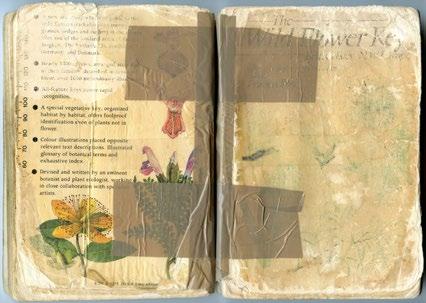
BSBI NEWS 156 | Spring 2024 19
Figure 2. My well used copy of Francis Rose’s The Wild Flower Key.
personal 43 year taxon accumulation curve
A personal 43 year taxon accumulation curve
DDb records per year
DDb (cumulative taxa)
Rose (cumulative taxa, including Fitter et al., 1995 data point)
Discussion
The number of records per year (Figure 3) and the number of surveyed days (a measure of recording effort, here defined as days when ≥ 40 taxa were recorded) are closely correlated (rs = 0.96, p ≪0.001, n = 43). However, less than 3% of my records are from the period before 2000, even though by 1999 I had recorded 51% of all the taxa recorded up to 2023. For 87 taxa (5.4%) the most recent record of mine on the DDb is pre-1988, the year I moved to Scotland. In addition, there are a further c. 40 taxa recorded pre-1988 for which full details are lacking.
The total number of records collected and taxa identified, while large, are not exceptional. From records on the DDb, at least 50 individuals have a greater number of records to their name, with several having collected more than half a million records, and at least 80 recorders have recorded more taxa, with at least 10 individuals having recorded more than 2000 taxa.
As Figure 3 shows my recording activity post1999 has fluctuated widely, and surprisingly, from 2000–2023, the accumulated taxon total follows a rising linear trend (R2 = 0.978), with no indication of the total approaching an asymptote (levelling
off). Annual means of records and grid squares with records over the period 2000–2023 (Table 3) give an overview of the recording effort that sustained the year on year increase in accumulated taxa.
20 BSBI NEWS 156 | Spring 2024
Figure 3. Cumulative taxa and records (excluding duplicates) per year.
Taxon Rank Pre-2000 2000–2023 Species % 93.8 75.9 Infraspecific taxon % 3.8 12.3 Hybrid % 1.3 11.0 Genus % 1.1 0.8 Total taxa 818 789
Table 1. Percentage taxa by taxon rank first recorded pre-2000 and 2000–2023.
National status Pre-2000 2000–2023 Total taxa Native % 84.4 48.4 1072 Archaeophyte % 6.7 6.5 106 Neophyte % 8.9 45.1 429 Natives + archaeophytes % 91.1 54.9 1178 Neophytes % 8.9 45.1 429 Total taxa 818 789 1607
Table 2. Percentage taxa by national status first recorded pre-2000 and 2000–2023.
0 2,000 4,000 6,000 8,000 10,000 12,000 14,000 16,000 0 200 400 600 800 1,000 1,200 1,400 1,600 1,800 1981 1983 1985 1987 1989 1991 1993 1995 1997 1999 2001 2003 2005 2007 2009 2011 2013 2015 2017 2019 2021 2023 Records per year Cumulative
Year
taxa
Figure 5 plots the annual frequency distribution of 755 taxa that were first recorded post-1999, and had grid references at monad precision or better. Of these 50.2% were from monads where I had recorded in one or more previous years. The remainder (49.8%) were from monads not previously recorded. On average over that 24 year period, 43.6% of monads had been recorded in previously, and 56.4% were new monads. So re-visiting monads previously (partially) surveyed actually produced slightly more new taxa than going to an un-surveyed monad. However both approaches to recording were productive in terms of finding new taxa.
Although I can date my interest in field botany back to 1981/1982, it was not until 1995 that I first sent records to BSBI vice-county recorders (as a contribution to the Atlas 2000 project), and not until 2000 that I began to develop a sustained recording practice. Several developments were central to this change.
A personal 43 year taxon accumulation curve
In 1995 I had a month long sabbatical undertaking fieldwork for BSBI’s Atlas 2000 project in north Scotland and Worcestershire. Two later sabbaticals, in 2006 and 2013 were focused on recording in Banffshire and the Cairngorms National Park.
Second, being asked (in 2001) if I would consider taking on the role of Banffshire (v.c. 94) Vice-county Recorder. Once I had agreed, this really kick-started my recording.
Third, after initially using spreadsheets to store my field records, I asked Alex Lockton (then the BSBI Co-ordinator) for any suggestions for recording software. He mentioned that there was a new package called ‘MapMate’ which some people liked, so why not try it? I bought a copy in 2002, and have used it ever since. Being able to view my records on maps, share and receive records, and supply records electronically to BSBI was transformative. Today I mainly use it as an efficient way to enter and import records and to then upload them to the DDb, tasks it still performs admirably, with few glitches.
Fourth, BSBI’s development of the DDb. As a VCR, having access to this shared resource which pools records from a multitude of sources into one online database, being able to interrogate the records, and being able to upload a new batch of records and have them incorporated into the database within five minutes or so is fantastic. I upload new records after every data entry session.
Since 2000, I have recorded on a mean of 77 days per year (range 16–137) with a mean of 47 taxa recorded per ‘recording day’. On 20% of recording days I have recorded more than 100 taxa, but on 35% of days have recorded five or fewer taxa, and on 16% of days only a single taxon. My approach to
BSBI NEWS 156 | Spring 2024 21
Annual mean 2000–2023 New grid squares per year Records 5500 Hectads 35 9 Tetrads 118 52 Monads 196 111
Table 3. Annual mean recording summary, 2000–2023.
Figure 4. Cumulative taxa vs cumulative number of tetrads with records, 1982–2023.
0 200 400 600 800 1000 1200 1400 1600 1800 0 200 400 600 800 1000 1200 1400 1600 Cumulative taxa Cumulative number of tetrads y = 332.95 ln(x) −894.26 R² = 0.988
In monads not previously recorded In monads recorded in previous years
recording is semi-structured and varies from casual to as comprehensive as I am able.
Comparing the two time periods pre-2000 vs. 2000–2023, newly recorded infraspecific taxa and hybrids increased from 5% to 23% (Table 1), and of neophytes from 9% to 45% (Table 2). Even within v.c. 96, there is still considerable scope to further increase my accumulated taxon total. Genera which I have largely ignored to date or which I have underrecorded include (in order of number of potential taxa) Hieracium, Taraxacum, Rosa, Salix (hybrids), charophytes, Potamogeton, Cotoneaster, Rubus, Euphrasia and Mentha (hybrids).
References
Amphlett, J. & Rea, C. 1909. The Botany of Worcestershire: An Account of the Flowering Plants, Ferns, Mosses, Hepatics, Lichens, Fungi and Fresh-water Algae, which Grow or have Grown Spontaneously in the County of Worcester: with an Introduction and a Map. EP Publishing Limited (facsimile edition), Wakefield.
Atherton, I., Bosanquet, S. & Lawley, M. 2010. Mosses and Liverworts of Britain and Ireland – a Field Guide. British Bryological Society, Plymouth.
Clapham, A.R., Tutin, T.G. & Warburg, E.F. 1981. Excursion Flora of the British Isles (3rd edn). Cambridge University Press, Cambridge.
Fitter, R. & Fitter, A. 1984. Collins Guide to the Grasses, Sedges, Rushes and Ferns of Britain and Northern Europe. Collins, London.
Fitter, R., Fitter, A. & Blamey, M. 1978. The Wild Flowers of Britain and Northern Europe. Collins, London.
Hayward, J. 1987. A New Key to Wild Flowers. Cambridge University Press, Cambridge.
Lawrence, M.J. & Brown, R.W. 1967. Mammals of Britain, their Tracks, Trails and Signs. Blandford Press, London.
Maskew, R. 2014. The Flora of Worcestershire. Privately published, Tenbury Wells.
Perring, F.H. & Walters, S.M. 1962. Atlas of the British Flora. Thomas Nelson, London.
Proctor, E. 1965. Looking at Nature. Adam & Charles Black, London.
Rose, F. 1981. The Wild Flower Key. Warne, London.
Southwood, T.R.E. 1963. Life of the Wayside & Woodland. A descriptive Seasonal Guide. Warne, London.
Stephen, D. 1963. A Guide to Watching Wildlife. Collins, London & Glasgow.
Andy Amphlett
Joint VCR for Easterness (v.c. 96)
amphlett1958@gmail.com
22 BSBI NEWS 156 | Spring 2024
A personal 43 year taxon accumulation curve
Figure 5. Taxa first recorded per year, 2000–2023, in monads recorded in previous years and in monads not previously recorded.
0 10 20 30 40 50 60 70 80 2000 2001 2002 2003 2004 2005 2006 2007 2008 2009 2010 2011 2012 2013 2014 2015 2016 2017 2018 2019 2020 2021 2022 2023
Number of taxa first recorded in year Year
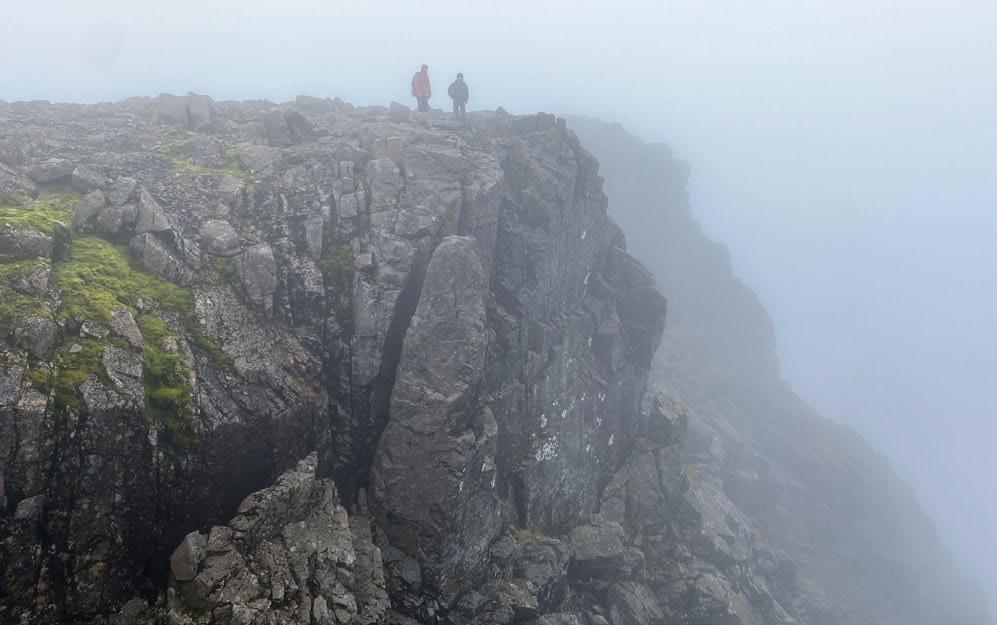
New altitudinal records on Ben Nevis and Ben Macdui
JIM MCINTOSH
There have been several visits to our highest summits to gather altitudinal records of vascular plants. Ben Nevis (1345 m), the highest mountain in the British Isles, for example, has previously been visited in 2002 by Gordon Rothero, in 2014–2016 by a team of North Face Survey botanists led by Ian Strachan (Skyring, 2017; Strachan 2017), and by the author in 2008. The summit flora of Ben Macdui (1309 m), the second highest mountain in the British Isles, was systematically recorded in 2010 by a BSBI party that I was part of (Table 1).
According to the most recent Altitudes spreadsheet (Pearman, 2023), Ben Macdui holds 23 altitudinal records and Ben Nevis has 26. Given that 42 hectares of Ben Nevis’s summit plateau are higher than the summit of Ben Macdui, one might expect many more taxa to be at their altitudinal limit on Ben Nevis than on Ben Macdui, even allowing for Ben Nevis’ more sparsely vegetated summit. So, I decided to investigate.
Dan Watson and Lewis Donaghy measuring the altitude of Alchemilla alpina (Alpine Lady’s-mantle) with a weighted length of string, Ben Nevis, September 2023. Sarah Watts
Method
I visited the Ben Nevis summit plateau, via the Càrn Mòr Dearg Arete, on 14 August 2022 and 8 September 2023 and searched systematically for vegetation above 1300 m. I chose days with exceptionally good weather, as conditions can make surveying at extreme altitudes particularly unpleasant and consequently unproductive. Much of the plateau is indeed devoid of vegetation; however, I discovered sparse vegetation at the top of the north face gullies and cliffs, around the Ben Nevis summit and its subsidiary summits, and along the Càrn Mòr Dearg Arete; and there were isolated patches of vegetation amongst boulders high above Coire Leis.
BSBI NEWS 156 | Spring 2024 23
*For the purposes of this study, Ben Nevis includes Ben Nevis and all its immediate neighbours such as Càrn Mòr Dearg but not more distant ones such as Aonach Mòr and Aonach Beag.
I recorded populations most likely to be at their altitudinal limit using a Garmin eTrex 10 Global Navigation Satellite System (GNSS) receiver1 (see photo). A subsequent visit was then made on 29 September 2023 with Sarah Watts, Dan Watson and Lewis Donaghy, equipped with a Geode GNS2 GNSS receiver. This device claims to give grid references that are within one metre accuracy. A visit was also made to the summit plateau of Ben Macdui on 13 July 2023 with Sarah Watts and Andrew Painting to systematically record altitudinal limits there using the Geode GNS2. In all cases, full grid references and altitudes were noted. Plants were carefully inspected and signs of fertility such as flowers, fruits, vivipary or spore production were recorded.
At its highest locality on Ben Nevis, Alchemilla alpina (common names are given in the tables), occupied an inaccessible ledge in Tower Gully. To measure its altitude correctly we obtained an accurate grid reference at the edge of the plateau immediately above the ledge, lowered a weighted string until it reached the population, then calculated its altitude by subtracting the string’s length.
Findings
We found 46 vascular plant taxa at new altitudinal records, of which 36 were on Ben Nevis and 11 on Ben Macdui. Fourteen taxa were recorded above
1 GNSS is an umbrella term that encompasses all global satellite positioning systems, like the American GPS system, the Russian GLONASS system and the European Galileo system. The Garmin eTrex 10 was set to use both GPS & GLONASS and the WAAS/EGNOS error correction system was enabled.
their altitudinal record in Pearman (2023), on both Ben Nevis and Ben Macdui and are marked with asterisks in the tables below. Three records superseded altitudinal records made over 150 years ago: Alchemilla alpina, Blechnum spicant and Omalotheca supina, and a further four superseded records made over 100 years ago. Three of the taxa are Nationally Scarce: Athyrium distentifolium, Poa alpina and Sibbaldia procumbens and two are Nationally Rare: Luzula arcuata and Saxifraga rivularis. Ten of the Ben Nevis altitudinal records superseded records on Ben Nevis and three Ben Macdui altitudinal records superseded records on Ben Macdui.
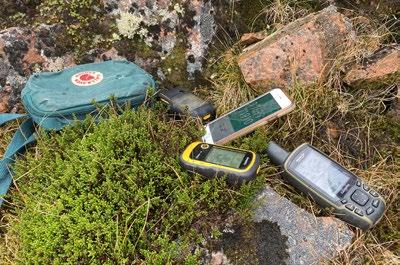

24 BSBI NEWS 156 | Spring 2024
Site Recorder Year No. of altitude records No. that has not been superseded in Pearman (2023) Ben Nevis* Gordon Rothero 2002 10 2 Ben Nevis Jim McIntosh 2008 10 6 Ben Macdui BSBI party 2010 11 11 Ben Nevis North Face Survey 2014–2016 17 17
Table 1. Past survey visits to Ben Nevis and Ben Macdui, with number of altitudinal records and number of those still standing.
GPS devices used to measure altitude. Jim McIntosh
New altitudinal records on Ben Nevis and Ben Macdui
Remarkably, 15 altitudinal records were more than 100 m higher than those made previously (Table 2).
In general, it is not known whether these species have recently colonised higher ground but it seems more likely that these populations have gone unnoticed or at least unrecorded – though see the paragraph on Poa annua below. However, it may be that some are casual occurrences at remarkable altitudes and it will be interesting to see whether they persist. Leaves of Rumex acetosa were, for example, recorded in 2022 on the summit of Ben Nevis, 109 m higher than any previous record; however, it did not become established and there were no signs of them in 2023.
Chamaenerion angustifolium is a great coloniser of bare areas, and is occasionally seen on montane ledges. It was recorded in two completely different places on the Ben Nevis plateau (at 1343 m and 1309 m altitude) and the lower population has survived at least one winter. Neither population was flowering but the plants can spread and presumably over-winter by rhizomes, so it may be in the process of colonising.

There were 22 altitudinal records of taxa between 10–100 m higher than previous altitudinal records (Table 3) and 11 taxa were recorded within ten metres of their previous altitudinal records (Table 4). All but two of these 11 records confirm previous altitudinal records in the same area using more accurate equipment and methodology. The only exceptions are Omalotheca supina and Luzula spicata, both of which have new altitudinal records on Ben
BSBI NEWS 156 | Spring 2024 25
Taxon Location Altitude (m) Previous record (m) Difference (m) Salix cinerea (Grey Willow) Ben Nevis, Càrn Dearg, NW 1219 845 374 Rubus idaeus (Raspberry) Ben Nevis, Càrn Mòr Dearg Arete 1060 765 295 Chamaenerion angustifolium (Rosebay Willowherb) Ben Nevis summit 1343 1100 243 Carex canescens (White Sedge) Ben Macdui summit 1309 1100 209 Betula pubescens (Downy Birch) Ben Nevis, Càrn Dearg NW 1207 1026 181 Betula pendula (Silver Birch) Ben Macdui, Sròn Riach 821 665 156 Poa annua (Annual Meadow-grass) Ben Nevis summit 1346 1214 132 Blechnum spicant* (Hard-fern) Ben Nevis, above Little Brenva face 1314 1185 129 Calluna vulgaris* (Heather) Ben Macdui summit 1252 1128 124 Cerastium fontanum (Common Mouse-ear) Ben Nevis summit 1343 1220 123 Ranunculus acris (Meadow Buttercup) Ben Nevis, above point Five Gully 1342 1220 122 Deschampsia cespitosa subsp. alpina* (Alpine Hair-grass) Ben Nevis summit 1346 1234 112 Diphasiastrum alpinum* (Alpine Clubmoss) Ben Nevis above Observatory Ridge 1332 1220 112 Rumex acetosa (Common Sorrel) Ben Nevis summit 1344 1235 109 Dryopteris dilatata* (Broad Buckler-fern) Ben Macdui, E of 1237 1130 107
Table 2. Altitudinal records of taxa from the 2022/23 survey exceeding previous records by >100 m.
New altitudinal records on Ben Nevis and Ben Macdui
Chamaenerion angustifolium (Rosebay Willowherb) at 1343 m on Ben Nevis summit. Sarah Watts
26 BSBI NEWS 156 | Spring 2024
Taxon Location Altitude (m) Previous record (m) Difference (m) Athyrium distentifolium (Alpine Ladyfern) Ben Nevis, above Gardyloo Gully 1327 1230 97 Molinia caerulea (Purple Moor-grass) Ben Macdui, Sròn Riach 1093 1000 93 Empetrum nigrum* (Crowberry) Ben Nevis, above Observatory Ridge 1329 1250 79 Viola palustris* (Marsh Violet) Ben Nevis, above Little Brenva face 1309 1234 75 Oreopteris limbosperma* (Lemonscented Fern) Ben Nevis, above Little Brenva face 1307 1233 74 Poa annua (Annual Meadow-grass) Ben Nevis summit 1346 1275 71 Luzula sylvatica (Great Wood-rush) Ben Nevis, Càrn Mòr Dearg Arete 1108 1040 68 Potentilla erecta (Tormentil) Ben Macdui, SE of 1156 1109 47 Trichophorum germanicum agg. (Deergrass) Ben Macdui, E of 1234 1190 44 Alchemilla alpina (Alpine Lady’s-mantle) Ben Nevis, above Tower Gully 1313 1270 43 Cochlearia pyrenaica subsp. alpina Pyrenean Scurvygrass Ben Nevis, top of No. 2 Gully 1276 1240 36 Vaccinium myrtillus* (Blaeberry) Ben Nevis, above Tower Gully 1336 1300 36 Nardus stricta* (Mat-grass) Ben Nevis, above Gardyloo Gully 1337 1305 32 Silene acaulis* (Moss Campion) Ben Nevis, above Gardyloo Gully 1335 1305 30 Huperzia selago* (Fir Clubmoss) Ben Nevis, above Tower Gully 1334 1305 29 Oxyria digyna (Mountain Sorrel) Ben Nevis, top of No. 2 Gully 1276 1160 27 Carex bigelowii* (Stiff Sedge) Ben Nevis, above Observatory Ridge 1332 1305 27 Erica tetralix (Cross-leaved Heath) Ben Macdui, Sròn Riach 901 880 21 Salix herbacea (Dwarf Willow) Ben Nevis, above Tower Gully 1327 1310 17 Phegopteris connectilis (Beech Fern) Ben Nevis, Càrn Mòr Dearg 1215 1200 15 Vaccinium vitis-idaea (Cowberry) Ben Nevis, Càrn Mòr Dearg Arete 1109 1095 14 Hieracium agg. sub-section Alpina (a Hawkweed) Ben Macdui, Sròn Riach 1234 1220 14 Galium saxatile (Heath Bedstraw) Ben Macdui 1230 1220 10
Table 3. Altitudinal records of taxa from the 2022/23 survey exceeding previous records by 10–100 m.
Taxon Location Altitude (m) Previous record (m) Difference (m) Festuca vivipara (Viviparous Sheep’sfescue) Ben Nevis summit 1344 1335 9 Saxifraga rivularis (Brook Saxifrage) Ben Nevis, top of No. 2 Gully 1263 1256 7 Omalotheca supina (Dwarf Cudweed) Ben Nevis, above Little Brenva face 1311 1305 6 Luzula spicata* (Spiked Wood-Rush) Ben Nevis, above Little Brenva face 1311 1305 6 Micranthes stellaris (Starry Saxifrage) Ben Nevis summit 1344 1340 4 Luzula arcuata (Curved Wood-rush) Ben Macdui summit 1309 1305 4 Poa alpina (Alpine Meadow-grass) Ben Nevis, top of No. 2 Gully 1276 1275 1 Sibbaldia procumbens (Sibbaldia) Ben Nevis, above Little Brenva face 1311 1310 1 Avenella flexuosa (Wavy Hair-grass) Ben Macdui summit 1305 1305 0 Pinus sylvestris (Scots Pine) Ben Macdui, SE of 1159 1160 −1 Eriophorum angustifolium (Common Cottongrass) Ben Macdui, SE of 1229 1230 −1
Table 4. Taxa recorded within ten metres of their previous altitudinal records during 2022/23 survey.
New altitudinal records on Ben Nevis and Ben Macdui
*No previous altitude limit given for this taxon.
Nevis, whereas their previous altitudinal records were on Ben Macdui.
In addition, two subspecies were recorded that have no previous altitudinal record listed in Pearman (2023) (Table 5). The species are listed but it is unknown to which subspecies the altitudinal records refer.
The ten highest (extent) occurring taxa in Britain, following this survey, are shown in Table 6. The very highest vascular plant in the British Isles is Poa annua, closely followed by Deschampsia cespitosa subsp. alpina. They both occur at 1346 m – at least one metre above the 1345 m height of Ben Nevis now given on Ordnance Survey maps. This is because the actual height of the naturally occurring summit of Ben Nevis is 1344.53 m2 and the trig point is on a 10 foot high stone plinth on which they grow. Poa annua must be a very recent addition to the summit flora, as it was not recorded in the 2008 survey nor noted in several subsequent visits to the summit of Ben Nevis. It was noticed for the first time in
2 Ordnance Survey website blog, March 2016. Great Britain’s tallest mountain is taller: www.ordnancesurvey.co.uk/blog/britainstallest-mountain-is-taller
2022 when a small flowering and fruiting patch was noted around the base of the trig point plinth. In 2023 the patch had become bigger and there were scattered plants in the vicinity, including one on the steps up to the trig point. Almost certainly seed has been carried up to the summit on hillwalkers’ boots (it is thought that over 100,000 people climb Ben Nevis annually).
Fertility
As a general rule montane species were apparently fertile (i.e. flowering, fruiting, viviparous or producing spores) at their altitudinal limit – such as Alchemilla alpina, Athryrium distentifolium, Carex bigelowii, Cryptogramma crispa, Deschampsia cespitosa subsp. alpina, Festuca vivipara, Huperzia selago, Luzula spicata, Luzula arcuata, Omalotheca supina, Poa alpina, Salix herbacea, Silene acaulis and Vaccinium uliginosum. By contrast, lowland or upland species growing at their altitudinal limit were not fertile – such as Blechnum spicant, Calluna vulgaris, Cerastium fontanum, Chamaenerion angustifolium, Dryopteris dilatata, Luzula sylvestris, Oreopteris limbosperma, Rubus idaeus, Veronica serpyllifolia subsp. serpyllifolia and all the tree species.
BSBI NEWS 156 | Spring 2024 27
Taxon Location Altitude (m) Deschampsia cespitosa subsp. cespitosa (Tufted Hair-grass) Ben Nevis summit 1343 Veronica serpyllifolia subsp. serpyllifolia (Thyme-leaved Speedwell) Càrn Dearg, NW, top of No. 4 Gully 1189
Table 5. Altitudinal records of two subspecies from 2023/23 survey.
Taxon Location Altitude (m) Previous record (m) Difference (m) Poa annua Ben Nevis summit 1346 1275 71 Deschampsia cespitosa subsp. alpina Ben Nevis summit 1346 1234 112 Festuca vivipara Ben Nevis summit 1344 1335 9 Micranthes stellaris Ben Nevis summit 1344 1340 4 Chamaenerion angustifolium Ben Nevis summit 1343 1100 243 Cerastium fontanum Ben Nevis summit 1343 1220 123 Deschampsia cespitosa subsp. cespitosa Ben Nevis summit 1343 * –Ranunculus acris Ben Nevis, above point Five Gully 1342 1220 122 Cryptogramma crispa (Parsley Fern) Ben Nevis, above Gardyloo Gully 1341 1330 11 Nardus stricta Ben Nevis, above Gardyloo Gully 1337 1305 32
Table 6. The ten highest vascular plant taxa in Britain, following the 2022/23 survey.
New altitudinal records on Ben Nevis and Ben Macdui
Macdui
However, there were many exceptions. These species, normally considered to be lowland or upland, but not montane, were recorded as fertile at their altitudinal limits: Avenella flexuosa, Carex canescens, Deschampsia cespitosa subsp. cespitosa, Erica tetralix, Eriophorum angustifolium, Galium saxatile, Molinia caerulea, Nardus stricta, Phegopteris connectilis, Poa annua, Potentilla erecta, Ranunculus acris, Trichophorum germanicum agg and Viola palustris.
A few montane species were never recorded as fertile at their altitudinal limits: Diphasiastrum alpinum, Empetrum nigrum, Micranthes stellaris, Vaccinium myrtillus and Vaccinium vitis-idaea. The growing season is very short on the summits of Ben Nevis and Ben Macdui. Snow often does not melt until June or July and early frosts can occur in August or September. It may be that in a particular good summer these montane species might be able to flower and fruit, but usually the short growing season prevents that, at least at their highest occurrences where there is extreme exposure or very late-lying snow. Athyrium distentifolium for example occurs in an area of latelying snow at the top of Gardyloo Gully, and was just developing sori by August 2022 after a very warm sunny summer, but the same plants showed no signs of fertility in late summer 2023.
Technical findings
The apparent accuracy of different methods of obtaining altitudes was investigated during the course of the fieldwork. The methods were (i) using the Geode GNS2 and Garmin eTrex 10 altitude readouts directly; (ii) plotting the grid references from these devices on an electronic OS 1:25,000 map in Memory Map and using its readout or by interpolating its contours; and (iii) plotting the GNSS grid references in the OS Maps website (explore. osmaps.com).
While the Garmin eTrex 10 rarely gave altitudes that were higher than known spot heights (such as a trig points), it often read a few metres low and was poor at providing consistent readings at the same spot. Disappointingly the Geode often read a few metres high at spot heights. Memory Map often gave incorrect readouts near cliffs but interpolating
contours in Memory Map gave surprisingly good results, apparently, but was difficult to do on very flat or very steep ground. The best method – and that used for this report – was plotting the Geode derived grid references in the OS Maps website.
Conclusion
After this work we believe that there are now a total of 49 altitudinal records on Ben Nevis (up from 26 prior to this work) and 21 on Ben Macdui (down two from 23). The records have been entered into the BSBI Database and will be included in the 2024 edition of the Altitudes spreadsheet. Together they form a great baseline for future monitoring of the effects of climate change. I would encourage anyone who encounters vascular plant species at unusually high altitudes on these summits, or indeed anywhere else, to make detailed records and check them against the latest Altitudinal Limits spreadsheet.
References
Pearman, D.A. 2023. Altitudes spreadsheet. Available at: bsbi.org/altitudes
Skyring, I. (ed). 2017. The North Face Survey: Discovering the hidden side of Ben Nevis, The Nevis Partnership, Fort William. Strachan, I.M. 2017. Ben Nevis North Face Survey 2014–16, final botanical report. Available at: bsbi.org/westerness
Jim McIntosh
JMcIntosh@rbge.org.uk
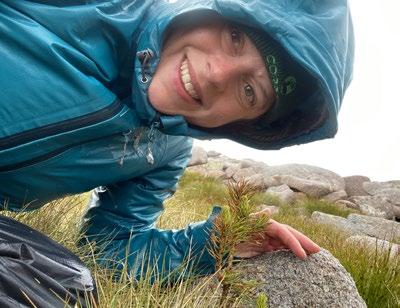
28 BSBI NEWS 156 | Spring 2024
New altitudinal records on Ben Nevis and Ben
Sarah Watts with Pinus sylvestris (Scots Pine) at 1159 m on Ben Macdui. Jim McIntosh
Observations on Sparganium erectum (Branched Bur-reed)
MICHAEL WILCOX
Some years ago, around 2010, I got interested in the species, Sparganium erectum (Branched Bur-reed) and its subspecies. The four subspecies, subspp. erectum, microcarpum, neglectum and oocarpum, have variously been considered at different ranks over time. I noticed that some plants appeared to have ‘variably intermediate’ fruits. Subsp. oocarpum, seemed rare and as in the literature, it appears to be a hybrid (Rich & Jermy, 1998; Stace, 2019; Stace et al., 2015).
Initially my idea with these taxa was that subsp. erectum and subsp. neglectum (the two extremes) may have started out (evolved) as two good species. Later and or over a long time, they hybridised to form (subsp.) oocarpum, which seems to be a good hybrid as it has many more sterile fruits than the few fertile ones. It may also be that (subsp.) microcarpum was formed from the same (perhaps reciprocal) cross, as it has characters of both, but became a more or less stable (species) fertile plant. The S. erectum taxa have good plants with the right fruiting characters but I noticed they appeared to have putative hybrids between them. All this was speculation.
The fruits in the three main subspecies develop characteristic shapes as does subsp. oocarpum, but many fruits of that are often largely sterile and it is considered a hybrid (Stace, 2019). However, I have seen plants that are variably intermediate in various combinations of these taxa, suggesting hybridisation does occur or has occurred in the past. The term ‘variably intermediate’ is used here for the putative hybrids as they can have a combination of fruits that look sterile, partially and fully developed in the same head, but showing characters of two (or more?) of the taxa in question. Though sterility maybe due to lack of pollination in some, it may also be due to crossing.
Over the next seven years or so, I started to see more ‘variably intermediate’ fruits (in the same head). In the North West (near where I lived at the time, v.c. 59) I noticed plants of what appeared to be ‘intermediates’ of subsp. erectum and subsp. microcarpum . Predominantly, where I live now, (v.cc. 63/64) the local canal seems to have only subsp. microcarpum in the short stretches where S. erectum s.l. occurs. I have seen subsp. neglectum in the east of Yorkshire (e.g. Pocklington), and it occurs on the Wirral, with subsp. erectum. On the Isle of Man subsp. erectum was seen and at least one plant of what appeared to have variably intermediate fruits with subsp. microcarpum. Other variably intermediate plants and the subspecies have been seen in other locations. However, at Pocklington, one plant appeared to be intermediate with subsp. oocarpum and subsp. neglectum. This seems to be effectively a backcross! Paul Kirby sent me some material from Lincolnshire which had subsp. microcarpum and subsp. neglectum, but one plant (fruits) was variably intermediate between these two, and I (at least to my eye) considered this to be a hybrid between them (see below*).
I attempted to grow one plant of S. erectum so that if I encountered other subspecies over time, I may have been able to use the male flowers to cross them with the female parts of the one in cultivation. This would have taken years and I was told if I got any seeds they were difficult to grow (Prof. Dirk Albach, pers. comm.). After two or three years, the pot-bound plant became small and did not fruit well on its own and I had no space to grow them in larger pots. However, I did attempt to grow some from ‘seed’. Mature achenes collected from one of the subspecies (neglectum) were pared down (removing the outer spongy material) to the harder outer body enclosing the seed. This hard outer casing was scored
BSBI NEWS 156 | Spring 2024 29
Observations on Sparganium erectum (Branched Bur-reed)
with a razor and as much as possible was removed, and the opening at one end was cut down slightly (but so as not to damage the tip of the seed) and these were placed in water. After a few days, small tips could be seen coming out. The water was changed regularly and these grew longer. They were placed on damp gravelly soil in a large pot (that held water) and then the water was filled over them slowly so as not to disturb them (trapped between the gravel as much as possible so as not to float). One or two plants grew and reached two years without fruiting. After this it was just not feasible to grow such large plants in my small garden. However, it showed that they could be grown from ‘seed’.
In 2021, I came across a paper by Píšová & Fér (2020). This used genetic techniques looking at S. erectum in the Czech Republic. They stated that it confirmed the hybrid status of subsp. oocarpum, being of the previously known speculative hybrid combination. However, they also stated that they confirmed the other subspecies and (as I had thought) hybrids between the subspecies. I contacted Soňa Píšová about some here in Britain. *Having discussed them, I sent an image of the putative Lincolnshire ‘microcarpum × neglectum’ and she agreed that it was similar to what they had encountered for that hybrid (Soňa Píšová, pers. comm.).
Schou et al. (2023), have recently produced a new guide to aquatic plants covering Northern and Central Europe, including Britain and Ireland. They treat the subspecies more or less at species level, with subsp. oocarpum being treated as a hybrid. They also report, at the species level, hybrids (unconfirmed) between them, thus similar to Píšová & Fér’s (2020) subspecies, which seems to confirm such hybrids, but this publication is not mentioned by the authors. However, there is no mention of putative hybrid combinations between the taxa in S. erectum in Britain. I have discussed such combinations with various people over the years.
In my limited opinion, combinations of putative hybrids between the subspecies (or species) of S. erectum s.l. do occur in Britain, (and could occur in Ireland as well) including (back-) crosses involving (subsp.) oocarpum. Like Schou et al. (2023), maybe we should treat three of the subspecies as species and ‘oocarpum’ as a hybrid. These taxa can in turn each cross (or have crossed in the past) with at least one of the other subspecies, (or species and hybrid), depending on your taxonomic view. However, these hybrids may be difficult to detect. Schou et al. (2023), also report other hybrid combinations in and between sections, but like Píšová & Fér (2020), genetic, and detailed morphological work (on the fruits) needs to be carried out for those plants and on plants in Britain and Ireland, at least for Sparganium erectum s.l. and probably other taxa in the genus.
Acknowledgements
Thanks to Paul Kirby (and others) and to Soňa Píšová.
References
Píšová, S. & Fér, T. 2020. Intraspecific differentiation of Sparganium erectum in the Czech Republic: molecular, genome size and morphometric analysis. Preslia 92: 137–165.
Rich, T.C.G. & Jermy, J. 1998. Plant Crib. BSBI, London.
Schou, J.C., Moeslund, B., Weyer, K. van de., Lansdown, R.V., Wiegleb, G., Holm, P., Baastrup-Spohr, L. & SandJensen, K. 2023. Aquatic Plants of Northern and Central Europe including Britain and Ireland. Princeton University Press.
Stace, C.A. 2019. New Flora of the British Isles (4th edn). C & M Floristics, Middlewood Green, Suffolk.
Stace, C.A., Preston, C.D. & Pearman, D.A. 2015. Hybrid Flora of the British Isles. pp. 398–427. Botanical Society of Britain & Ireland, Bristol.
Michael Wilcox
43 Roundwood Glen, Greengates, Bradford, BD10 0HW
michaelpw22@hotmail.com
30 BSBI NEWS 156 | Spring 2024
Observations on Sparganium erectum (Branched Bur-reed)
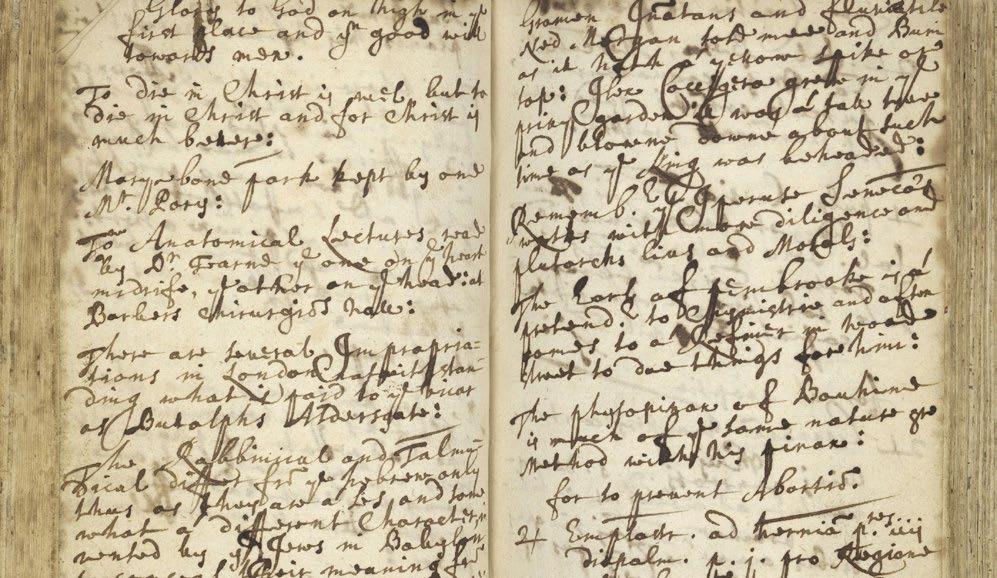
Some early botanical exchanges
FRANK HORSMAN
Edward Morgan (c. 1615–1689) (Horsman, 2023) was the botanist at the Westminster Physic Garden (henceforth WPG) from 1650, when it opened, until 1678. He instructed Edward Lhwyd (?1660–1709) in field botany. The polymath Lhwyd was to become a celebrated British botanist. Morgan himself was influenced by Robert Morison (1620–1683) who became the first professor of Botany at Oxford University. Morison thought very highly of Morgan as a botanist and encouraged him. He remarked [in translation] “… committed to the earth by [that] diligent & intelligent gardener very skilled in Botany, Edward Morgan, in [his] little suburban garden behind Westminster Abbey …” (Morison, 1680 2: 375). Morgan became a Freeman of the Society of Gardeners in 16501, by redemption, that is, he did not have to serve an apprenticeship. Morgan knew Thomas Johnson (1600 or 1604–1644) well. Johnson was the editor of the second edition of Gerard’s Herbal, 1633. He was Welsh and was the interpreter on Johnson’s excursion to Snowdon in 1639. Morgan may have (already)
1 Register of admissions, Society of Gardeners, London.
Figure 1. An extract from John Ward diaries, Vol. 9, part of the Folger Manuscript Transcriptions Collection held at the Folger Shakespeare Library, Washington, DC (https://luna.folger.edu). Creative Common Attribution-ShareAlike 4.0 International Licence. Digital image file name 44071, Source Call Number: V.a. 292.
discovered some of Snowdon’s rare plants. There is evidence that he trained as a gardener with the Tradescants (Elder [c. 1570–1638], Younger [1608–1662]) and the Bobarts (Elder [c. 1599–1680], Younger [1641–1719]) (Horsman, 2023). He witnessed Tradescant the Elder’s will and attended his funeral (Potter, 2006: 252–3). He was held in high regard as a botanist in London by virtue of the visitors to his garden, the WPG, and the references to him in the botanical literature of the day. He is largely unknown today because he never published anything, because he couldn’t afford it, and he had such a common name, although there has been a recent resurgence of interest in him as a botanist thus: Jeffers (1953), Burnby (1994), Oswald (2022), Gregory (2023) and Horsman (2023). His birth
BSBI NEWS 156 | Spring 2024 31
Some early botanical exchanges
details and his origins are unknown. He is believed to have come from North Wales.
In 1661 John Ward (1629?–1681) started visiting Morgan at the WPG. In 1661/62 he visited possibly eleven times (Jeffers, 1953: 112). Ward studied at Oxford until 1660 when he moved to London to pursue interests in plant simples (medicinal plants) and botany. He was friendly with Bobart the Younger and he knew Morison. Ward also knew Richard Tuggy (1626–1670), the son of the late, celebrated early florist Ralph Tuggy (?–1633). I have recently determined that the Tuggy nursery was near the WPG in Westminster.2 Morgan and Ward became friends. Ward kept a total of 17 diaries during his lifetime. He moved from London to Stratford upon Avon in 1662 to become a clergyman. In his diaries he recorded anecdotes about Shakespeare3. The diaries are now with the Folger Shakespeare Library in Washington DC, where they have been digitally archived and transcribed (Figure 1).
The diaries are a primary source for Edward Morgan. Each time he visited the WPG Ward would make a note in his diary of the plants Morgan had shown him and any botanical gossip he had picked up from Morgan. The pattern of these diary entries is: ‘Ned Morgan told me …’. The gossip included talk of contemporary British botanists and was a measure of the respect with which Morgan was held. The diaries provide an interesting insight into the botanical world in London in the latter half of the 17th century. D’Arcy Power (1919) has published some of the entries but he was not a botanist and some of the botanists mentioned were unknown to him. Gunther (1922) also makes references to D’Arcy Power (1919). There is a degree of repetition here but the author feels justified in bringing these particular quotes together for the attention of
2 The Hearth Tax Return for Westminster 1664, St. Margaret’s, Westminster, Peter Street South, shows Richard Tuggy had 9 hearths, a prosperous household. I am in no doubt that this was the site of Ralph Tuggy’s nursery, not previously correctly ascertained. It closed on Richard’s death in 1670 (Leapman, 2000:53).
3 The diaries contain “very few references to Shakespeare.” They sold for £10,000 in 1928 (Frank, 1974).
modern botanists. The selected diary entries are quoted below.
John Ward Diaries (Vol. 8) (V.a. 291)
4v–5r
“Narcissus albus flore muliplici att Ned Morgans in Westminster.”
22v–24r
“Mr. [Thomas] Ihonson [sic], Mr. [John] Goodyer [1592–1664], Dr. [George] Bowles[1604–1672], and Mr. [Walter] Stonehouse [1597–1655] were anciently esteemed the very best Simplers in England but not so now. Ned Morgan tels mee next Dr. Modesy [Morison]4, Dr. [John?] Dale, Dr. [Christopher] Merret [1614–1695] and Mr. [John] Goodyer the last 3 were about a new Phytologia 3 or 4 years agoe but Dr. Modesy coming to town Ned Morgan thinks they left off.”
25v–26r
“Sycamore Dr. Modesy says is Acer majus, as appears by the seed: he judges of all plants what tribe they are of by the seeds: a god [sic] way indeed … Remember that tomorrow morning I carrie those plants to Ned Morgan which came in Barrels with Oysters to know what they are, remember to inquire and see Mr. Ihonston [sic] the Apothecaries shop …” [This is Thomas Johnson’s old shop.]
26v–27r
“Ned Morgan tels mee that those which Jacob [Bobart the Elder] used to call Ranunculus aqu. saniculae foliis is Apium risus that he had once the gout in his foot and hee took but that herb and bruised itt and laid itt too and itt drew blisters and eased him presently, … Fabius Columnus [1567–1640] Dr. Modesy does much to commend. March the 20th. I saw Theatrum Botanicum [1658] of Caspar Bauhin [1560–1624] which did comprehend
4 “Modesy” approximates to “Morison” in French. Modesy is easier of pronunciation by the French tongue (Power, 1919). Morison spent a long time working in France.
32 BSBI NEWS 156 | Spring 2024
Some early botanical exchanges
grasses and frumenta as wheat and barley and the like …”
John Ward Diaries (Vol. 9) (V.a. 292)
27v–28r
“I saw [Thomas] Ihonstons [sic] Mercurius botanicus [1641] att his house [Morgan’s?] itt is much like Dr. Hows Phytologia this is an account of a voyage into Wales …”
“[Caspar] Bauhin’s Prodromus [1620] is only of such plants as hee first found or first gave names to.”
“Dr. How hath put out a piece showing what plants [John] Parkinson [1567–1650] stole out of a Manuscript of L’Obels, which never was put out but came by chance to Dr. Modesy hands …”
“Ned Morgan was wel aquainted with [Thomas] Iohnston [sic], hee much commends him.” [Thomas Johnson died in 1644. He was with Morgan in 1639 on Snowdon.]
31v–32r
“[Caspar] Bauhin styles his dried plants his hortus siccus …”
“[Caspar] Bauhin in the Pinax [1623] asserts nay he said that some [holly] trees have prickly att the bottome and smooth ones att the top.” [Morgan had a particular interest in trees.]
32v–33r
“Gramen innatans and fluviatile Ned Morgan told me and Burri [?Burre grass] as itt hath a yellow spike on top: Ilex coccigera grew in the Privy Garden [Whitehall] itt was a tall tree and blowne down about such time as the King [Charles I, 1649] was beheaded.”
“The Phytopinax of Bauhin [1596] is much of the same nature & method with his Pinax [1623] …” [It is interesting to note the use of Bauhin in England cf. Ray.]
40v–40r
“Dr. Modesy says he never studied grasses and Mosses.”
41v–42r
“… I saw a Medlar tree att Ned Morgans hee had also had the Physic nut but itt was gone and the yellow Spanish jessemine but dead: he had male and female peony, the male had somewhat bigger leaves than the female: 2 sorts of Platanus 5 one with leaves more dissected the other lesse. Hart cherrie so called because the fruit resembles the heart: we have no true Sycamore in England, itt is only Acer majus goes under that name: Quercus Ilex and suber. All species of Oakes as Parkinson saies: Millefolium aquaticum, Ranunculi flore et capitulo: A greater sort of Gramen an junceum which is in Parkinson: Lybica poplar is rounder than the black leaf. All 3 seen at Ned Morgans: Lilium bulbosum by the Martagon Gladiolus Narbonensis: The humble plant [Mimosa] shrinks and fails, the sensible only shrinks up: … fraxinella bears a brave large spiked flower, which smels much like parsly rosted in a pidgeons belly …” [The trees would, presumably, be growing in Morgan’s arbour.]
91v–92r
“Mr. Goodyer is good att Insects as wel as plants: hee livs at Petersfield towards Portsmouth …” [Did Morgan &/or Ward ever meet Goodyer?]
“… when a man goes a Simpling itt is very Convenient that he be a lymner [a drawer/artist] or else have one with him: as Mr. Goodyer:”
“Dr. Modesy told Ned Morgan that the Duke of Orleans set out 4 persons with 4 men and horses to seek out strange plants and they went towards the Alps and Italy and in all their journey they found
5 Edward Morgan’s herbarium at the Bodleian, folio 146r bears 2 leaves, one labelled ‘Platanus orientalis’ with jagged leaves and the other ‘Platanus occidentalis aut Virginiensis.’ Also on the sheet are some fruits of Platanus orientalis. P. orientalis × P. occidentalis = P. × acerifolia, the London Plane tree. Tradescant the Younger introduced P. occidentalis into England from Virginia. That Morgan had both parents growing in his garden, the WPG, is confirmed by Lawson’s notebook (p. 240). Lawson notes his entry for P. occidentalis: “ye more cutt”, clearly referring to the leaves. He’s got this the wrong way round: P. orientalis has jagged leaves. This mirrors the situation in the Tradescants’ South Lambeth garden where, it is said, this hybrid first arose.
BSBI NEWS 156 | Spring 2024 33
Some early botanical exchanges
but 3 very strange plants. And that voyage cost them more that is the Duke, Dr. Modesy thought than all the Garden did besids: whether there is a small Alchemilla or not, or whether the same with the greater; some call Percepier Anglorum an Alchemilla minor or minima …”
“Mr. Wray [1627–1705] put out the Cambridge Catalogue. Mr. Goodyer commends him for a very prety[?] man …” [It would seem that Ward had met Goodyer.]
“[Conrad] Gesner [1516–1565] hath a Catalogue of Books alphabetically for names, and draughts and I have seen them both.”
92v–93r
“I was with … Dr. Modesie att the King’s garden [The Royal Physic Garden in St. James’s Park in London] (Horsman, in prep.) who showed us [Ward + Morgan] some of his very rare plants as Marum Syriacum, Crithmum spinosum, and Barba jovis with others. Ned Morgan did affirme to me that some Holly trees have prickly branches at the bottome and smooth ones at the top. That there is not a difference betwixt smooth and prickly holly in kind Ned Morgan did affirme to me but only in age when young prickly when old smooth and this Bauhine asserts. Nay he said that some trees have prickly branches… Hee commends Ned Morgan for the best Collection of plants in England. He [Morison] seems to be a morose man.”
157v–158r
“Dr. Mod[esie?] How [William How(e): 1620–1656] had the greatest Librarie of physick Books that ever was seen, hee had all that Bauhin his Pinax mentions except 6. as hee told Ned Morgan before his death … Mr. [Thomas] Ihonston [sic] livd on Snow hil there is one of his name an Apothecarie lives there still. Dr. [John?] Dale [d.1662] and another had a design to amend the Phytologia Britannica to adde somewhat & take out somewhat, but Dr. Modesy coming to Towne itts thought hinderd itt. Dr. How had 2 Apothecaries that helped him in his Phytologia as Ned Morgan told mee as also their names but I
have forgot them.” 6 [How died in 1656. Confirms Morgan’s relationship with How.]
John Ward Diaries (Vol. 11) (V.a. 294)
28r
“[Ward] To simple all day tomorrow and then bring the plants to ?Iacob [Jacob Bobart the Younger] on Tuesday morning and begg a few seeds of Indian Cresse and Manuel.”
Acknowledgements
My thanks are due to Abbie Weinberg and Sarah Schliep both of the Folger Shakespeare Library, Washington DC, USA, and Miten Mistry of the Wellcome Collection, London, all for help with the transcriptions of John Ward’s diaries.
References
Burnby, J.G.L. 1994 Some early London Physic Gardens. Pharmaceutical Historian 24: 4.
Frank Jnr., R.G. 1974 The John Ward Diaries: mirror of seventeenth century science & medicine. Journal of the History of Medicine & Allied Science 29: 2.
Gregory, S. 2023 Edward Morgan and the Westminster Physic Garden. Garden History. 51(1): 54–66.
Gunther, R.T. 1922. Early British Botanists and their Gardens. Oxford.
Horsman, F. 2023. Edward Morgan (c. 1615–1689) and his botanical pupil Edward Lhwyd (c. 1660–1709). British & Irish Botany 5(3): 276–294.
Jeffers, R.H. 1953 Edward Morgan and the Westminster Physic Garden. Proceedings of the Linnean Society 164: 102–133.
Morison, R. 1680 Plantarum historiae universalis Oxoniensis 2: 375.
Oswald, P.H. 2022. Edward Morgan (c. 1619–c. 1689) and his hortus siccus: an early record of Welsh plants. Archives of Natural History 49(1): 27–40.
Power, D. 1919. The Oxford Physic Garden. Annals of Medical History 2: 109–25.
Potter, J. 2006. Strange Blooms: The Curious Lives and Adventures of the John Tradescants. London.
Frank Horsman frankhorsman306@gmail.com
6 Webster, 1967, states that the two helpers were Sir Thomas Browne and George Joyliffe (1621–1658). Gunther (1922: 278) speculates that one of them may have been a Mr Hunnibon.
34 BSBI NEWS 156 | Spring 2024
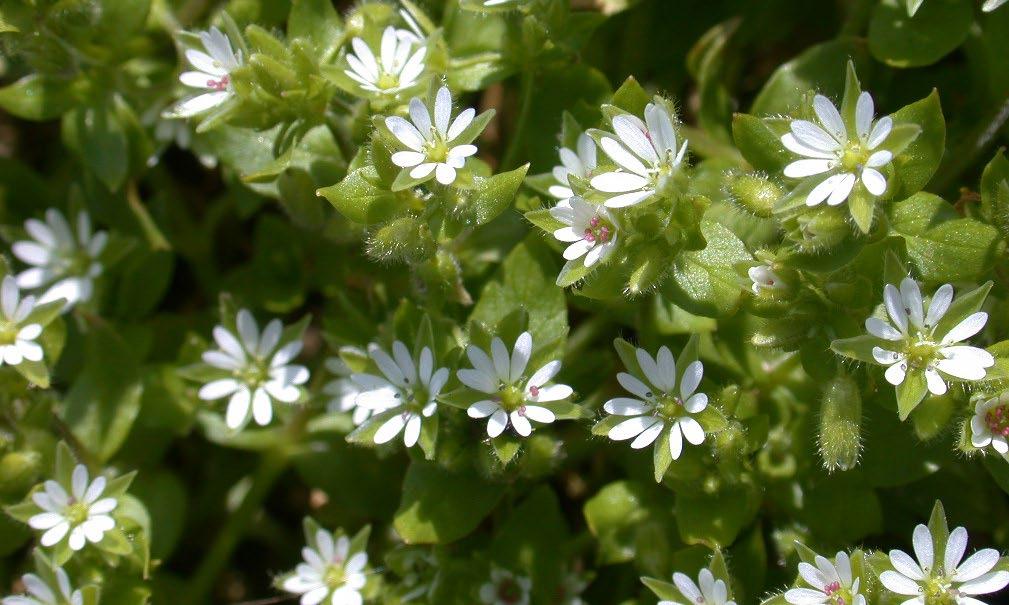
BEGINNER’S CORNER Chickweeds (Stellaria Part 2)
MIKE CREWE
Inthe previous issue of BSBI News, we looked at some of the species within the genus Stellaria, in the Campion family (Caryophyllaceae). The species covered were largely those with typically rather narrow, non-petiolate (unstalked) leaves which are known as ‘stitchworts’. Here, I shall cover the remaining members of Stellaria – those with broader, petiolate leaves, known as ‘chickweeds’.
The four chickweeds
The four species of Stellaria considered here are a mix of annuals and perennials, so that can be a useful starting point. Check for the possible presence of tough perennial stems towards the base of the plant. Other features to check mostly involve the details of the flowers, so non-flowering plants are best left for another day while you are still learning.
The chickweeds occur in a range of habitat types, which can often be a further clue to help with identification. For example, Common Chickweed is one of the most ubiquitous of plants throughout
Common Chickweed (Stellaria media), a ubiquitous species in Britain and Ireland. Mike Crewe
the UK, occurring in a wide range of humaninfluenced habitats as well as in more natural woodland, heathland and wetlands. In contrast, Water Chickweed is more strongly tied to wet ground, while Greater Chickweed is a plant of woodlands and shady places.
It’s fair to say that this group can at times be a little tricky, particularly as they can be quite variable in appearance, according to growing conditions –plants in open, dry ground, can be rather small, even stunted, while individuals in the shade may be more lush and healthier-looking. With this in mind, we need to pay careful attention to the finer details of the flowers to be certain of an identification –prepare to need a hand lens!
Mike Crewe mikedcrewe@gmail.com
BSBI NEWS 156 | Spring 2024 35
BEGINNER’S CORNER: Chickweeds (Stellaria Part 2)
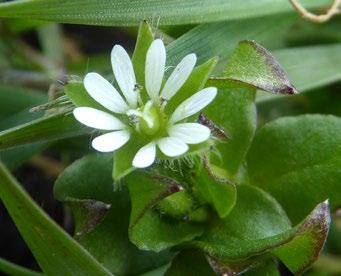
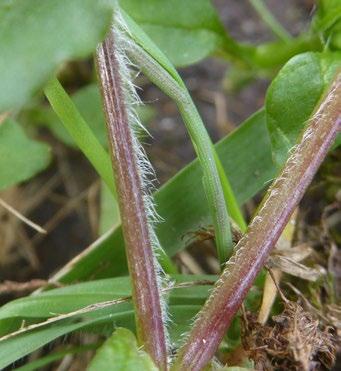
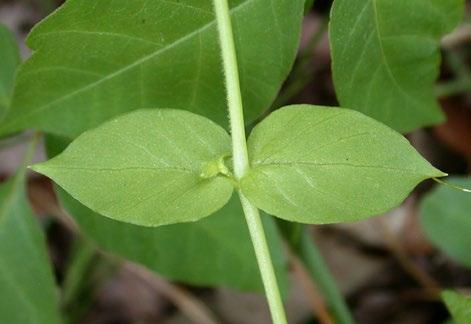
Common Chickweed (Stellaria media). This is your yardstick chickweed, an abundant, annual species found in almost every part of Britain and Ireland. A highly variable species, but always with the single line of hairs along the stems, between the leaf nodes, that typifies most members of this group. Leaves ovate to heart-shaped, typically with distinct petioles (though sometime short, as in the photo above). Close inspection of the five-petalled flowers should reveal 3–8 stamens and three styles at the centre, with sepals measuring less than 5 mm. Although considered an annual, this species can be found in flower in any month of the year and often overwinters in urban habitats.
Crewe
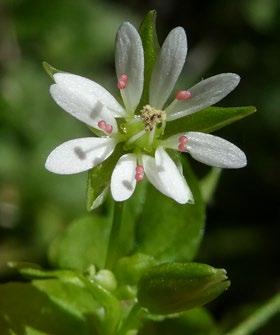
Greater Chickweed (Stellaria neglecta). An annual or short-lived perennial of shady places, usually in open woodland or damp hedge bottoms, or along the margins of streams and ditches; flowering from April to July. Most common in western England and Wales and in East Anglia, with scattered populations elsewhere in lowland England; rarely in Scotland. Very much like a grand version of Common Chickweed and the two are easily confused as the leaves and stems are very similar. With flowers present, you should be able to count three styles and 10 stamens (the latter often releasing their pollen in groups of five at a time), while the sepals typically measure more than 5 mm.
Mike Crewe
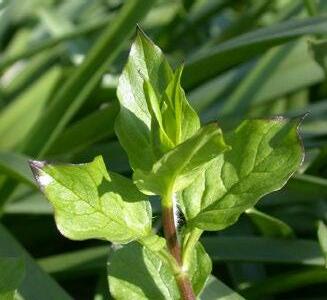
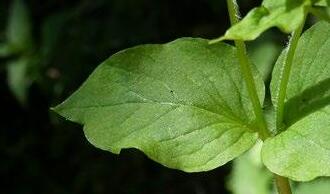
36 BSBI NEWS 156 | Spring 2024
Mike
BEGINNER’S CORNER: Chickweeds (Stellaria Part 2)
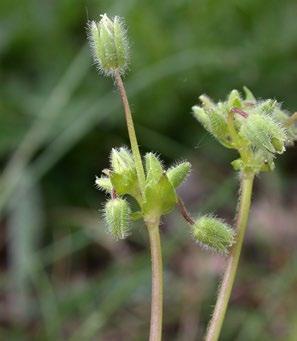
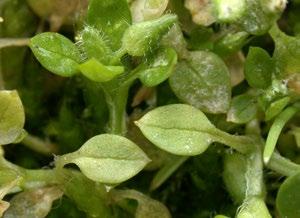
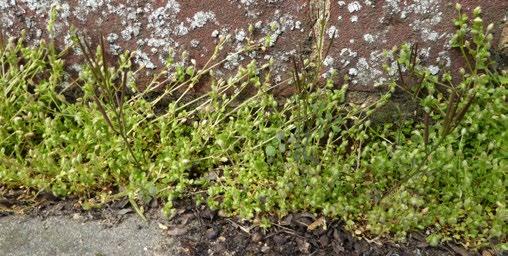
Lesser Chickweed (Stellaria pallida). A low and often inconspicuous plant, found most frequently in open, dry places on sandy, acidic soils or – increasingly in recent years – as a weed of pavements and mown road verges in urban areas. To those learning their plants, this might seem a peculiar species, typically having flowers with no petals (or at the most petals less than 1 mm long) and which often barely open and probably self-pollinate. A hand lens is most certainly required to investigate these flowers, which have just 1–3 stamens and sepals less than 3 mm long. This is a strict annual – plants flower early in the year, in February to April, and soon shrivel after setting seed – so can easily be missed after early spring. The whole plant is often a seemingly sickly, yellow-green colour, which often first draws the trained eye to their presence. Mike Crewe (top left and right); John Norton (bottom left).
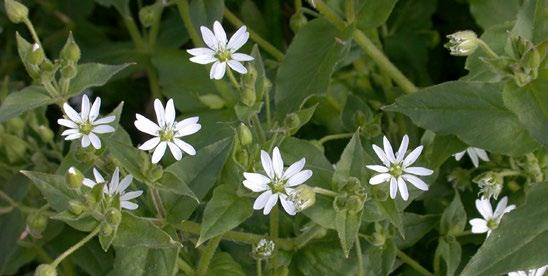
Water Chickweed (Stellaria aquatica; previously Myosoton aquaticum). In the same way that Wood Stitchwort is the odd one out amongst the stitchworts (due to its hairy stems and broad, petiolate leaves), this is the odd one out amongst the chickweeds as it is the only species in this group that has five (rather than three) styles; it also lacks the single line of hairs on the stems; instead having an even scattering of hairs towards the top of the plant. The flowers are rather large for this group, so counting the styles is usually quite straightforward. The leaves are large, broadly ovate, with strongly wavy margins. Water Chickweed is a perennial of wet places in damp woodland and along watercourses throughout most of lowland England and in coastal areas of North and South Wales. Small, introduced populations exist in Ireland and Scotland. It starts to flower late in the year (from July onwards) and often grows by scrambling over other vegetation. Mike Crewe
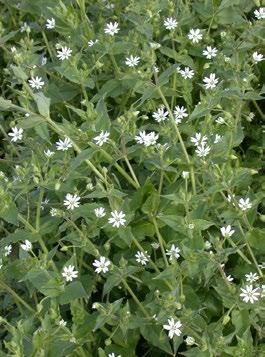
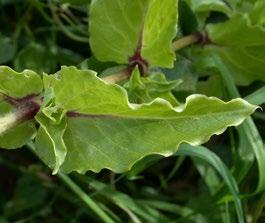
BSBI NEWS 156 | Spring 2024 37
ADVENTIVES & ALIENS
Adventives & Aliens News 32
Compiled by Matthew Berry
Flat 2, Lascelles Mansions, 8–10 Lascelles Terrace, Eastbourne, BN21 4BJ m.berry15100@btinternet.com
Iwould like to thank everyone who has submitted records, either their own or on the behalf of others, and will have done them justice if members find the following compilation as interesting to read as I did to put together.
V.c. 4 (N. Devon)
Clerodendrum trichotomum Thunb. (Harlequin Glorybower). Dolton (SS58031203), 15/8/2023, R.I. Kirby & R. Hodgson (conf. M. Duffell): young plants all over less well tended corner of churchyard, with an additional plant on adjacent roadside verge. It is presumed to have spread by suckering from a planted specimen by the church gate. Mark Duffell strongly suspected var. fargesii (Dode) Rehder (the most commonly in cultivation) but var. trichotomum could not be totally discounted. Adventives & Aliens News 22, v.c. 9. See v.c. 24.
Ligularia fischeri (Ledeb.) Turcz. (Fischer’s Leopardplant). Iddlecott (SS56891261), 15/8/2023, R.I. Kirby & R. Hodgson (conf. M.J. Crawley): single clump, c. 2 m × 1 m, in dampish spot on south-facing verge of partially shaded green lane. A perennial east Asian herb (Asteraceae) that is a rare garden plant in Britain and Ireland. In Korea, and perhaps elsewhere, it is grown as a vegetable with, for example, the leaves being used as edible ‘wraps’. It quite closely resembles L. stenocephala (see Adventives & Aliens News 30, v.c. 9) but in L. fischeri the basal leaves are more regularly toothed and their basal lobes rounded and not divergent (vs sharply triangular and divergent); there are 5–9 ligules per capitulum (vs 1–4); the outer surface of the involucre is shortly brown-hairy (vs glabrous); and the achenes are somewhat larger (6–8 mm vs 5–7 mm).
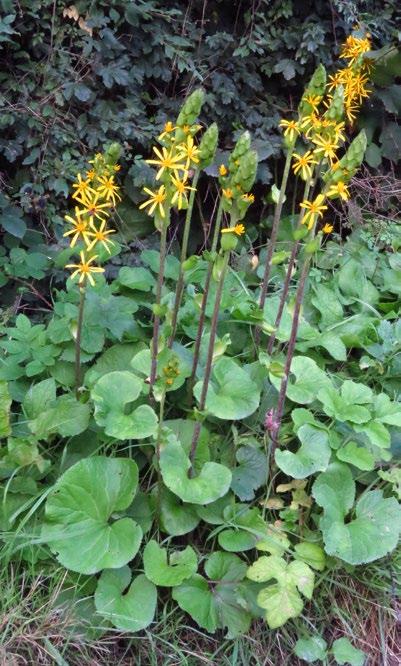
Cosmos sulphureus Cav. (Yellow Cosmea). Barnstaple (SS55973242), 28/8/2023, R.I. Kirby (conf. M. Berry): one plant on large soil heap behind newly constructed tennis centre; seen in flower on 11/9/2023. New to v.c. 4, indeed there are no other records in the DDb. An annual composite native
38 BSBI NEWS 156 | Spring 2024
ADVENTIVES & ALIENS: Adventives & Aliens News 32
Ligularia fischeri, Iddlecott, North Devon (v.c. 4). Bob Kirby
to Mexico, grown as a half- or fully hardy garden plant. It differs from Cosmos bipinnatus (Mexican Aster) in having orange-yellow ligules (vs pinkishpurple or white) and broader, less linear-filiform leaf segments. Cosmos atrosanguineus (Hook.) Voss is also available for cultivation; it is a perennial with dark red-purple ligules and leaves even more coarsely divided – there are three apparently casual records for v.c. 22, all 1999.
Lemna valdiviana Phil. (Valdivia Duckweed). Marwood (SS54513753), 30/8/2023, R.I. Kirby (conf. R. Lansdown): weed in a garden pond of an ornamental garden. New to v.c. 4. A free-floating, perennial, aquatic neophyte (Araceae), native of more humid parts of America with relatively oceanic climate. It resembles shade forms of L. minuta (Least Duckweed) in having flat, one-veined, translucent fronds that are never reddish and always without turions; differing in the mid-vein reaching threequarters of distance between node and frond apex (vs reaching apex), fronds often just submerged (vs always floating), often joined in clusters of c. 2–7 (vs single), ovate-lanceolate (vs elliptic) and pale green (vs dark olive-green). Adventives & Aliens News 30, v.c. 4.
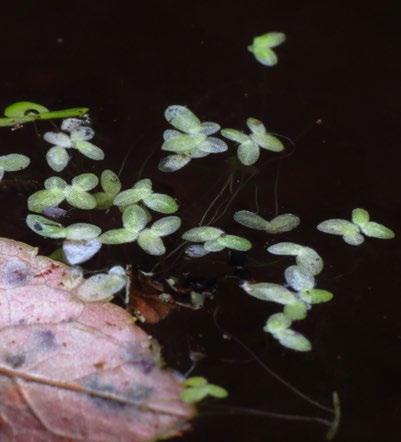
× Phyllosasa tranquillans (Koidz.) Demoly ‘Shiroshima’ (Shiroshima Bamboo). Saunton (SS451376), 7/2/2023, R.I. Kirby & S. Kirby (conf. M. Bell): naturalised alongside a footpath from a probable nearby introduction. Bob Kirby also found it naturalised in Combe Martin at SS591457 (also v.c. 4), where it had spread under a fence into a green lane and was spreading across the roadside embankment. There are at present no other records in the DDb. Mike Bell noted that there is no other taxon in cultivation currently with such large size and bold variations. A vigorously spreading densely clumping bamboo with slender, yellow-green canes and dark green leaves streaked creamy white. It is the intergeneric hybrid of one very tall Chinese taxon, Phyllostachys nigra var. henonis, with lanceolate leaf blades (8–11 cm × 1.0–1.6 cm) and the much shorter Japanese species, Sasa veitchii, with oblong leaf blades (20–25 cm × 4.0–5.0 cm).
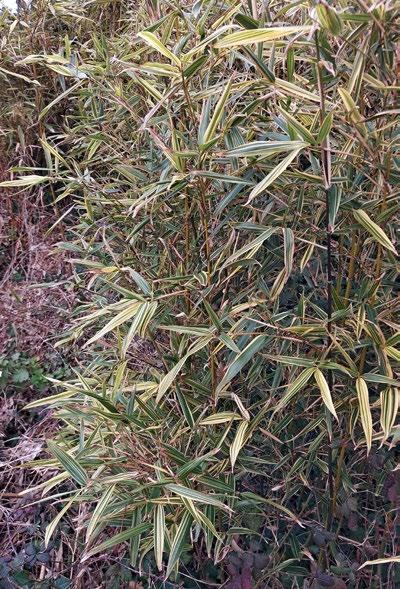
x Phyllosasa tranquillans ‘Shiroshima’, Saunton, North Devon (v.c. 4). Bob Kirby
BSBI NEWS 156 | Spring 2024 39 ADVENTIVES & ALIENS: Adventives & Aliens News 32
Lemna valdiviana, Marwood, North Devon (v.c. 4). Bob Kirby
V.c. 5 (S. Somerset)
Lagenaria siceraria (Molina) Standl. (White-flowered Gourd). Lopen Head (ST42221513), 15/9/2022, F. Rumsey: climbing up a dead elm tree at the edge of the overflow parking area behind local curry house. New to v.c. 5. The only other record I could find out about was for North Oxford tip (v.c. 23) in 1978 and again in 1979. A monoecious, (usually) annual climber or trailer (Cucurbitaceae) of pantropical distribution. The leaves are ovate-reniform, unlobed or shortly 3–7(9)-lobed. The solitary white flowers open in the evening, the male flowers on longer stalks (7.5–31 cm vs 6–7 cm) and with larger petals (2.7–4.5 cm × 1.8–3.7 cm vs 3 × 2.4 cm) than the female ones; the petals in both cases obovate-apiculate, free or just united at the very base. The fleshy, greenhairy, usually bottle-shaped (lageniform) fruits can be as much as c. 100 cm × 20 cm. The seeds are slightly tapered, slightly horned towards the broader end and with flat facial ridges, 12–22 mm long. The tendrils are 2-branched and there is a pair of small conical glands at the apex of each petiole. It is probably grown as a garden curiosity, although the fruits are edible, and most likely to be found outside gardens as a throwout, when its ability to root at the nodes might come into play.
Primula pulverulenta (Red Cowslip). Crowcombe Bridge (ST137365), 9/5/2022, M. Wilson: in a field where previous undergrazing might have rendered the plants invisible from the nearby footpath; the vegetation was otherwise natural-seeming. The first v.c. 5 record. A perennial garden escape (Primulaceae) to 100 cm, native to China. The deep red or less often white flowers, 20–30 mm across, are in tiered whorls and the rugose, obovateoblanceolate leaves have marginal teeth and white to yellowish mealy undersides, 10–30 cm × 8–10 cm.
Adventives & Aliens News 19, v.c. 64.
V.c. 9 (Dorset)
Pinus strobus (Weymouth Pine). Brownsea Island (SZ02008808), 14/10/2023, D. Leadbetter (comm. D. Leadbetter): c. 11 seedlings from mature tree, south side of West Lake. An evergreen N. American conifer (Pinaceae) to c. 40 m, planted mainly as an
ornamental in Britain and only occasional seedlings found. There are two other v.c. 9 records, both for Brownsea Island (here ‘Weymouth’ refers to Lord Weymouth and not to the town in Dorset). The blue-green leaves being grouped in fives alone separates it from many of the other pines likely to be encountered. A relatively fast-growing, frost-resistant tree, its timber was once exploited for box making among other things. Its commercial promise was adversely affected by a susceptibility to blister-rust, an ultimately fatal fungal infection that attacks the upper stem. Stace (2019): 48.
Sorbus mougeotii (Mougeot’s Whitebeam). Brownsea Island (SZ02438830), 23/10/2023, D. Leadbetter (det. T.C.G. Rich/comm. D. Leadbetter): one mature, probably bird-sown tree, St. George’s Hill. New to v.c. 9. A deciduous southern and central European tree (Rosaceae) to c. 20 m, part of the S. intermedia aggregate and planted occasionally in parks and gardens. It has barely lobed, ovate-elliptic leaves, obtuse at tips and cuneate at bases with 7–11 pairs of lateral veins, 3.5–7 mm petals, and scarlet berries with few small to medium lenticels. Stace (2019): 219.
Chlorophytum comosum (Thunb.) Jacques ‘Variegatum’ (Spider Plant). Brownsea Island (SZ02748746), 2023, D. Leadbetter: two plants coming up in compost heap, castle grounds. New to v.c. 9. An evergreen rosette-forming perennial (Asparagaceae) native to much of Africa with short rhizomes and spongy often tuberous roots. The racemose inflorescence is lax or rather dense flowered, simple or little branched. Small plantlets may develop from its bracts. The 6-merous flowers have exserted stamens with yellow anthers and whitish three-veined tepals, 5–7 mm long. It has dark green strap shaped or lanceolate leaves (8–40 cm × 0.5–4 cm), edged with white stripes in this cultivar. It is an easily grown house plant and also sometimes seen planted out in borders, etc., most likely to be recorded by botanists as a garden reject. In 1984 it was recorded on waste ground at Wisley (Leslie, 1987).
40 BSBI NEWS 156 | Spring 2024 ADVENTIVES & ALIENS: Adventives & Aliens News 32
V.c. 10 (Isle of Wight)
Polypogon fugax Nees ex Steud. (Fleeting Beard-grass). Newport (SZ497896), 8/2023, P.D. Stanley (det. E.J. Clement): c. 300 plants in gutters and bases of walls, Heytesbury Road. An annual grass native to north east Africa and Asia which has occurred as a wool casual (Ryves et al., 1996). It is distinctive in having awns that are shorter than or up to 1.5× as long as glume body (vs 2.5–4× as long as glume body in P. monspeliensis and P. maritimus). There is an 1858 record for v.c. H20 in Ryves et al. (1996), although the given location of seashore near Kiloughter might not be reliable, (Reynolds, 2002). It was also recorded in wall-pavement angles in Trowbridge (v.c. 8) in 2006 (det. T.B. Ryves), still present 2023. Ryves et al. (1996), Fig. 29.
V.c. 11 (S. Hants)
Rumex thyrsiflorus Fingerh. (Thyrse Sorrel). Ashurst (SU33721191), 19/5/2023, M. Rowe (det. & comm. E.J. Clement): one male, 95 cm tall plant on roadside, Fleetwood Lane. A tall, dioecious perennial (Polygonaceae) native to central and eastern Europe. It differs from R. acetosa subsp. acetosa in the more highly branched inflorescence and shorter tepals (2.4–3.5 mm vs 3.3–5.2 mm), and from R. acetosa subsp. ambiguus in the later flowering time (JulyAugust vs May-June) and the greater length:width ratio of the leaves (4–10× vs 2–3×). It seems to be in the process of spreading in mainland Europe. New to v.c. 11, there are also records for v.cc. 113 (pre-1930 unconfirmed), 77 (2014) and 17 (2020 – two female plants, one c. 45 cm tall). BSBI News 148, pp. 45–46.
12 (N. Hants)
Bunias orientalis Warty-cabbage). Crondall (SU79034850), 30/8/2023, P. Sterry (comm. A.R.G. Mundell): fruiting plants on a grassy verge. Known here since 1955. A rather robust biennial/ perennial (Brassicaceae), with origins in Eurasia, and associations with commercial grain, bird-seed and railway ballast. Up to 120 cm tall, there is a mixed indumentum of branched and unbranched hairs and there are stalked glands present on the
stem; the lower leaves petiolate and variously lobed, the upper lanceolate and sessile/slightly clasping; the flowers on long pedicels (erecto-patent in fruit), the petals sulphur yellow (4–8 mm long) and the spreading sepals half their length; the fruit is shiny, asymmetrical, warty-ovoid and indehiscent, pointed at the tip, 5–8 mm long, plus a 0.5–2 mm style. It seems to somewhat favour calcareous substrates and to be rarer than formerly. Stace (2019): 447.
Digitaria ischaemum (Smooth Finger-grass). Hogmoor Inclosure (SU78913498), 29/8/2023, A.R.G. Mundell, H. Boyce & D. Pearson: over 20 plants on damp sand with Illecebrum verticillatum (Coral-necklace). A single plant was also seen by the same recorders at The Slab, Bordon (SU78303602, 27/9/2023). Once considered to be a possibly extinct Hampshire native, in 2005 Tony Mundell found it in huge quantity on pure damp sand in a military training area near Bordon, where it is extant (see above). Since then it has been found in
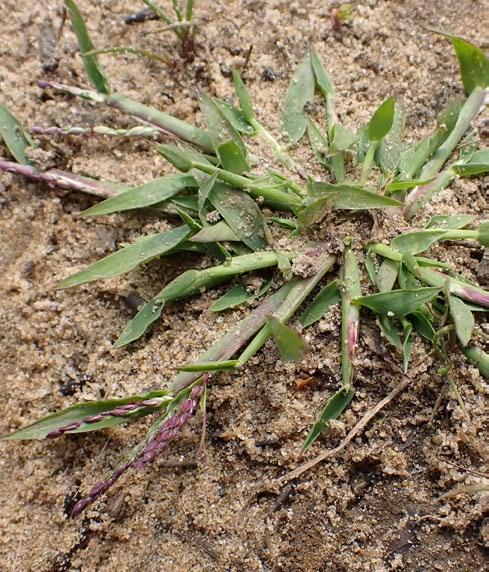
Digitaria ischaemum, Hogmoor Inclosure, North Hampshire (v.c. 12). Tony Mundell
BSBI NEWS 156 | Spring 2024 41 ADVENTIVES & ALIENS: Adventives & Aliens News 32
many other places in this general area, but always on sand (Tony Mundell pers. comm.). Although not in full flower until September/October, Tony Mundell remarks that the accustomed eye can pick out the broad-leaved seedlings from May onwards. Stace (2019): 1105. See v.c. 35.
V.c. 14 (E. Sussex)
Lotus maritimus (Dragon’s-teeth). Willingdon (TQ60040298), 1/7/2023, M. Berry (conf. E.J. Clement): one self-sown plant between kerbstones, Magnolia Drive. The first Sussex record. The flower border opposite was remarkable for the number of far from run-of-the-mill garden plants growing in it, L. maritimus among them. A decumbent, potentially mat-forming perennial (Fabaceae) that has large solitary pale yellow flowers, c. 3 cm long, and fruits up to 6 cm long with their four angles winged. It was of course formerly Tetragonolobus maritimus. Its established British populations tend to be on chalk or gravel and often near the sea, and their origins are somewhat of a mystery. Stace (2019): 164.
Lupinus albus (White Lupin). Sherman Bridge Area (TQ53050508), 26/7/2023, M. Berry & J. Linsell (conf. E.J. Clement): one small plant in open area between new cycle path and A27. The second Sussex record. An erect, appressed hairy annual, often no more than 50 cm tall. There is a few-flowered inflorescence, the corollas white and usually blue-tipped. There are 5–7 oblanceolate leaflets per leaf and these are glabrous above. It has flattened white seeds. A native of the eastern Mediterranean region and sometimes grown as a crop in southern England and elsewhere. The only other Sussex record, for west of Chiltington (also v.c. 14) in 2007, was as a crop relic (SBRS, 2018). Stace (2019): 191.
Galactites tomentosus (Mediterranean Thistle). Seaford (TV48149917), 15/11/2023, M. Berry & J. Linsell (det. M. Berry/conf. E.J. Clement): c. a dozen seedlings, at verge edge and one in road gutter, along same side of A259 as railway line, escaped from garden on opposite side of road. A tallish, slender, thistle-like Mediterranean annual or biennial that has usually purplish flowers and
spiny, deeply cut leaves. The ‘milky venation’ of the latter in non-flowering plants gives more than a passing resemblance to Silybum marianum (Milk Thistle), but all the leaves are narrower, less shiny and densely white-hairy below. It has a pappus of long feathery hairs. Records indicate that it is increasing. Adventives & Aliens News 21, v.c. 9. Stace (2019): 732.
Scabiosa ochroleuca L. (Yellow Scabious). Hastings Old Town (TQ82420955), 1/1/2024, J. Clark & J. Rose (conf. M. Berry/comm. J. Clark): one plant at base of house outer wall adjacent to footpath, Exmouth Place. New to Sussex. A central and southeastern European biennial (Dipsacaceae) with yellow corollas in a capitulum c. 2 cm across. It is a rare garden escape in Britain. Adventives & Aliens News 23, v.c. 9.
V.c. 16 (W. Kent)
Eurybia divaricata (L.) G.L. Nesom (White Woodaster). Woolwich (TQ43517934), 1/9/2023, G. Hall: two plants self-sown by the Thames Path, apparently escaped from planted border c. 10 m away. The first v.c. 16 record and perhaps also for Britain and Ireland. A dark-stemmed N. American perennial herb (Asteraceae) with ovate leaves (long-petiolate and cordate below) to c. 60 cm tall. Eurybia are distinguished from the Aster species now in Symphyotrichum by the corymbose inflorescence (vs paniculate), and the outer phyllaries being less than 2.5× longer than wide and having rounded/ obtuse tips (vs greater than 2.5× longer than wide and acute). Another N. American garden plant, E. schreberi (Nees) Nees, is illustrated on p. 316 of Clement et al. (2005), as Aster schreberi. It differs in having more teeth per leaf margin (15–30 vs 6–15) and non-flowering rosettes on short rhizomes (Kent Botany 2023, p. 25).
V.c. 24 (Bucks)
Clerodendrum bungei Steud. (Gloryflower). Prestwood (SP88050010), 12/10/2023, T.F. Marshall: under a roadside hedge just outside a garden. It has relatively inconspicuous red calyces (vs conspicuous green calyces that turn red in C. trichotomum). New to v.c. 24.
42 BSBI NEWS 156 | Spring 2024 ADVENTIVES & ALIENS: Adventives & Aliens News 32
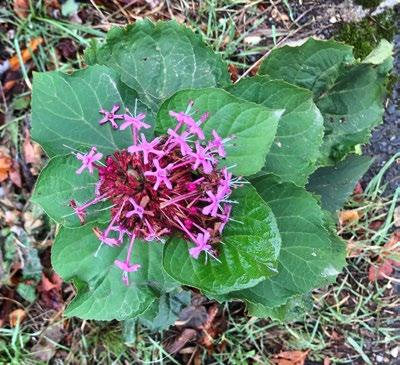
Clerodendrum bungei, Prestwood, Buckinghamshire (v.c. 24). Tony Marshall
Adventives & Aliens News 18, v.c. 17. Adventives & Aliens News 22, v.c. 9. Adventives & Aliens News 26, v.c. 28.
Salvia glutinosa (Sticky Clary). Prestwood (SU866992), 17/8/2023, T.F. Marshall: small group of plants in Prestwood Local Nature Reserve, well away from gardens, although the reserve itself does border some. New to v.c. 24. A very glandular upright perennial herb (Lamiaceae) from southern Europe, the strong-smelling ovate leaves with usually hastate bases, the 3–4 cm pale yellow corollas streaked red on the lower lip and in whorls of 2–6. As a native it is a species of shaded places on mountains. As a garden escape it is restricted to central/south-east England and a very small area of central Scotland. There are no records for Wales or Ireland in the DDb. Stace (2019): 676.
V.c. 27 (E. Norfolk)
Acaena anserinifolia (Bronze Pirri-pirri-bur). Norwich (TG23140823), 8/2/2023 & 8/8/2023, J.M. Parmenter & R.M. Leaney (conf. M. Crewe): c. 3 m × 3 m patch in frequently mown grass of St. John’s churchyard, Timberhill. The first confirmed record for v.c. 27 and Norfolk. A mat-forming perennial (Rosaceae) from New Zealand, differing from A. novae-zelandiae (Pirri-pirri-bur) mainly in the matt green leaflets (vs glossy green) and the smaller
length:breadth ratio of the apical leaflet pair (1.2–2× vs 1.8–2.5×). The leaflets are also often bronzetinged but that was not so in this case, the Timberhill plants having dark green leaves. A wool alien and garden escape (Clement & Foster, 1994). Clement et al. (2005), p. 157. Stace (2019): 279.
Amaranthus blitum subsp. oleraceus (L.) Costea (Guernsey Pigweed). Caister-on-Sea (TG52091219), 25/11/2023, J.M. Parmenter & R.M. Leaney (det. F. Verloove/comm. J. Parmenter): one plant growing on cobbled area beside road. The first record of the species for v.c. 27 and second for Norfolk. A subglabrous, procumbent to ascending annual (Amaranthaceae) from Eurasia and the Tropics, which has terminal and axillary inflorescences, three tepals per flower, non-inflated indehiscent fruits, and obovate usually retuse leaves. Plants with deeply notched leaf tips are separable as subsp. emarginatus
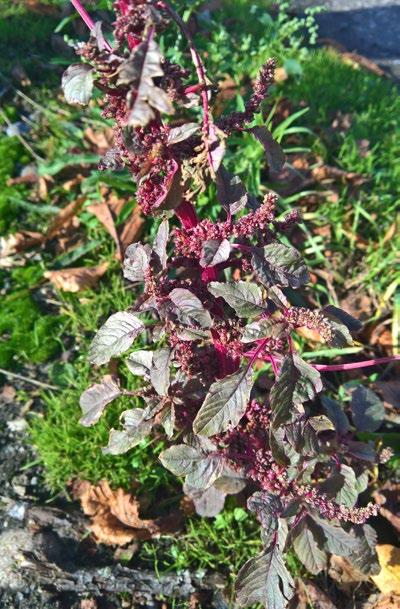
Amaranthus blitum subsp. oleraceus, Caister-on-Sea, East Norfolk (v.c. 27). Jo Parmenter
BSBI NEWS 156 | Spring 2024 43 ADVENTIVES & ALIENS: Adventives & Aliens News 32
Plants with larger (up to 9 cm long), less obviously notched leaves, broader fruits (1.8–3.0 mm vs 1.2–1.8 mm) and larger, smooth seeds (1.1–1.8 mm vs 0.8–1.1 mm) with rounded edges are separable as subsp. oleraceus (Manual of the Alien Plants of Belgium website). The nominate subspecies has sculptured seeds with acute edges but is otherwise closest to subsp. oleraceus As befits its larger leaves, subsp. oleraceus is sometimes cultivated as a spinach substitute. The beetroot red stem and dusky leaves of the Caister plant might indicate value as an ornamental and a possible origin in nearby planters. It might also have come from bird-seed. A. blitum in a more general sense has also been associated with wool and coir-fibre (Clement & Foster, 1994).
Coreopsis tinctoria (Golden Tickseed). Norwich (TG25280957), 2/10/2023, Norfolk Flora Group (det. M. Crewe/comm. J. Parmenter): one plant growing in a gutter in a residential area off Heartsease Lane, the probable parent plants in the adjacent garden. The second record for v.c. 27 and Norfolk as a whole. An erect sparsely hairy to more or less glabrous annual composite, growing up to c. 1 m tall and native to the central and southern US. It has usually opposite pinnately divided leaves and radiate capitula up to c. 5 cm across, the disc usually reddish, the apically toothed ligules reddish-brown or more typically yellow with a reddish-brown basal
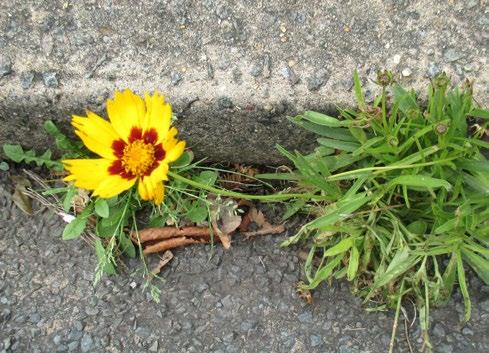
Coreopsis tinctoria, Norwich, East Norfolk (v.c. 27). Suki Pryce
blotch. The often brownish membranous phyllaries are in two rows (the outer less than half as long as the inner). C. grandiflora is a tufted perennial which has larger capitula, broader leaf segments, narrower phyllaries (the outer greater than half as long as the inner) and winged achenes (vs unwinged). C. tinctoria could be vegetatively mistaken for Cosmos bipinnatus (Mexican Aster) but the ultimate segments of at least the lower leaves are broader, more elliptic (vs all linear filiform). As well as being a garden plant it was also a wool casual and seems to be a part of certain sown ‘wildflower’ seed mixes. It was once placed in the now obsolete genus Calliopsis. Stace (2019): 819. It was also recorded for the second time in Sussex in 2023 (TQ50M & S, M. Berry & J. Linsell). See v.c. 64.
V.c. 28 (W. Norfolk)
Euphorbia myrsinites (Glaucous Spurge). Blo’ Norton (TM019799), 28/10/2023, M. Abdulla (det. M. Crewe): self-sown plants in gravelly bed close to planted parents and one in adjacent grass, near entrance to Dutch Barn Coffee Shop, north side of The Street. It seems to be new to Norfolk. A procumbent glabrous perennial (Euphorbiaceae) that has crowded, fleshy, glaucous, obovate-apiculate leaves, and terminal inflorescences on the second year stems; a native of the Mediterranean region and commonly planted in rockeries and public flower beds, etc. Euphorbia rigida M. Bieb., a rock/ gravel garden plant from Eurasia, has similarly fleshy glaucous leaves arranged in rows but lanceolate and is of a more erect habit. There are no records for it as yet in the DDb. BSBI News 85, p. 1. Stace (2019): 359.
V.c. 29 (Cambs)
Rothia indica (L.) Druce (Indian Rothia). Cottenham (TL43756625), 7/2019, J.L. Sharman (det. A.C. Leslie, 2023): single plants as weeds in two separate pots, Monksilver Nursery, Oakington Road (CGE). It is believed to have come in with the coir element of the commercial potting compost supplied to the nursery. There are no other records in the DDb. A small, appressed hairy annual (Fabaceae) – the leaves with three narrowly obovate leaflets; the solitary,
44 BSBI NEWS 156 | Spring 2024 ADVENTIVES & ALIENS: Adventives & Aliens News 32
yellow, subsessile flowers c. 8 mm long; the calyx 5.5–6.0 mm long (the teeth more or less equal to the tube); the standard somewhat longer than keel and wings and maybe slightly flushed orange; the fruits long, thin and densely appressed hairy (never fully matured). (After Alan Leslie’s description of the Cottenham plants.) It is thought to be subsp. indica, which would fit with the Indian/Sri Lankan origin of the other suspected coir aliens at the nursery. The Australian subsp. australis seems to be much more densely hairy (Alan Leslie pers. comm.). Rothia indica belongs in the tribe Crotalarieae, members of which include the genus Crotalaria (the rattlepods). In the past it was placed in Lotus and Trigonella among other genera (in tribes Loteae and Trifolieae, respectively). The ten stamens with small rounded anthers and the calyx with subequal teeth are important characters for distinguishing Rothia from Pearsonia and Robynsiophyton, also members of Crotalarieae. The genus contains one other species, R. hirsuta (Guill. & Perr.) Baker.
V.c.
35 (Mons)
Digitaria ischaemum (Smooth Finger-grass). Usk (SO3700), 27/8/2023, E. Wood & S. Tyler (comm. S. Tyler): edge of pavement in town. The second recent v.c. 35 record. A largely glabrous southern European annual that has spikelets that are somewhat smaller than in D. sanguinalis (Hairy Finger-grass) and D. ciliaris (Tropical Finger-grass), and arranged in threes (vs paired). As a neophyte associated with bird-seed, soya bean waste, wool and cotton. In some places, e.g. certain sandy fields in Surrey and Sussex, it could be native. Stace (2019): 1105.
V.c. 59 (S. Lancs)
Dracocephalum moldavica L. (Moldavian Dragonhead). Formby (SD28380683), 17/7/2023, P.H. Smith (det. J. Mason); Formby (SD29570917), 12/8/2017, P.H. Smith (det. J. Mason): with other exotics on disturbed sandy ground – in the first case where trees blown down by storm ‘Arwen’ and in the second case by ditch excavation at Freshfield Dune Heath Nature Reserve. The source in both cases might be deliberately scattered ‘wildflower seed’. These could
be the first modern records for Britain and Ireland. A central Asian annual (Lamiaceae), branched above, with narrowly ovate to oblong-elliptic serrate leaves, and a few large blue or white flowers per whorl in a long raceme. Dracocephalum have fifteen-veined, two-lipped calyces and two-lipped corollas with four stamens, the outer pair being shorter than the inner pair. D. moldavica differs from D. parviflorum and D. thymiflorum in its larger corollas (20–25 mm long vs 12–20 mm long), which much exceed the calyx, and its nearly glabrous leaves (vs more or less hairy).
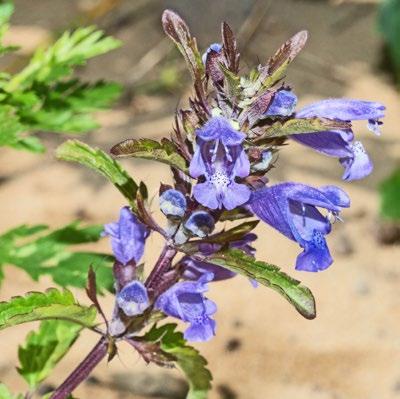
Dracocephalum moldavica, Formby, South Lancashire (v.c. 59). Philip Smith
V.c. 63 (S.W. Yorks)
Buddleja × weyeriana (Weyer’s Butterfly-bush). Leeds (SE28583324), 24/8/2023, D. Broughton (comm. D. Broughton): one apparent seedling by railway, self-sown from a roadside planting, New Wortley. A typical yellow-flowered form very like the supposed planted parent shrub, while second generation seedlings should be more like B. davidii (D. Broughton pers. comm.). The garden hybrid between the Chinese B. davidii (Butterfly-bush) and S. American B. globosa (Orange-ball-tree) (Scrophulariaceae), and more or less intermediate in characters; surviving from planted or as here occasionally self-seeding. The earliest Irish record in the DDb is for 2006 (H16). Stace (2019): 645.
BSBI NEWS 156 | Spring 2024 45 ADVENTIVES & ALIENS: Adventives & Aliens News 32
Bidens connata (London Bur-marigold). Gargrave (SD93385450), 9/9/2023, D. Broughton (comm. D. Broughton): along canal which forms the v.c. boundary at this site, with some plants also present on the other side in v.c. 64. See below for more general comment.
V.c. 64 (M.W. Yorks)
Crataegus rhipidophylla (Large-sepalled Hawthorn). Leeds (SE384279), 23/9/2023, D. Broughton: first vice-county find of clearly self-established bush, St. Aidan’s Nature Reserve. A spiny deciduous tree (Rosaceae), native to central and eastern Europe and an introduction in Britain. It has more incised leaves and larger darker fruits than C. monogyna (Hawthorn). The sepals are triangular-subulate to long-acuminate (vs triangular-lanceolate in C. monogyna) and always upright in fruit. Two subspecies are recognised. Stace (2019): 256.
Galium parisiense (Wall Bedstraw). Kirkstall (SE26023610), 24/8/2023, D. Broughton: locally abundant on gravel at base of wall. New to v.c. 64. A branching very fine-stemmed annual (Rubiaceae) with tiny greenish-white flowers. A widespread native of mainland Europe and possibly also in a few places in southern England. It is still increasing as a casual or more or less naturalised introduction elsewhere, often on waste ground or brownfield sites that can be developed or otherwise altered at short notice with consequent loss or endangerment of populations, e.g. in v.cc. 14 and 15. Stace (2019): 574. Bidens connata (London Bur-marigold). Thorlby Bridge (SD96115272), 9/9/2023, D.Leadbetter: one of a number of scattered locations associated with block stonework of locks and swing bridges of the Leeds & Liverpool Canal. A N. American annual (Asteraceae) found as a casual or naturalised along canals, etc., particularly in the London area, much like B. frondosa (Beggarticks). Differs from the latter in its unlobed leaves and from unlobed-leaved forms of B.tripartita (Trifid Bur-marigold) in the warty faces of its achenes. David Broughton remarked on the presence of backward-directed barbs on the achene bristles, contrary to the view of some older references but not the Flora of North America. Stace (2019): 819.
Coreopsis tinctoria (Golden Tickseed). Kirkstall (SE25973558), 24/8/2023, D. Broughton: colony on eroded bank of River Aire. The first v.c. 64 record.
V.c. 66 (Co. Durham)
Centaurea × gerstlaueri (Hybrid Knapweed). Port Clarence (NZ52012184), 17/8/2023, D. Broughton (comm. D. Broughton): one plant in herbage. The third v.c. 66 record and the first since 2002. The cross between the Eurasian Centaurea jacea (Brown Knapweed), with its distinctive shiny pale brown phyllaries, and native C. nigra (Common Knapweed)/C. debeauxii (Chalk Knapweed) and hybrid. David Broughton commented that this had the appearance of a clear cut primary hybrid with a strong C. jacea influence based on phyllary morphology, while flowering time, capitula size and pedicel characters seemed to favour C. debeauxii as the other parent. Against this, the observed presence of C. nigra × C debeauxii in the wider area. Stace (2019): 737. See v.c. 83.
V.c. 73 (Kirkcudbrights)
Trachystemon orientalis (Abraham-Isaac-Jacob). Arbigland (NX99065753), 24/5/2023, D. Davidson (comm. S. White): growing on a trackside with Darmera peltata (Indian-rhubarb). New to v.c. 73. A blue-flowered, hispid, rhizomatous herb (Boraginaceae), a native of Bulgaria, Turkey and the Caucasus, and a garden plant in Britain since c. 1752. Borago officinalis (Borage) is rather similar but an annual with glabrous filaments (vs hairy) that are shorter than the anthers (vs longer than anthers). The earliest reliable Irish record is for 1981 (Reynolds, 2002). Clement et al. (2005), p. 235. Stace (2019): 594.
V.c. 75 (Ayrs)
Leonurus cardiaca (Motherwort). Prestwick (NS35012625), 16/10/2023, A. Rutherford (det. A. Rutherford & M. Philip/comm. D. Lang): dense stand for several metres in Prestwick Park Station car park. New to v.c. 75. There have only been 32 records for Scotland as a whole. A shortly rhizomatous Eurasian herb (Lamiaceae) to c. 1.2 m
46 BSBI NEWS 156 | Spring 2024 ADVENTIVES & ALIENS: Adventives & Aliens News 32
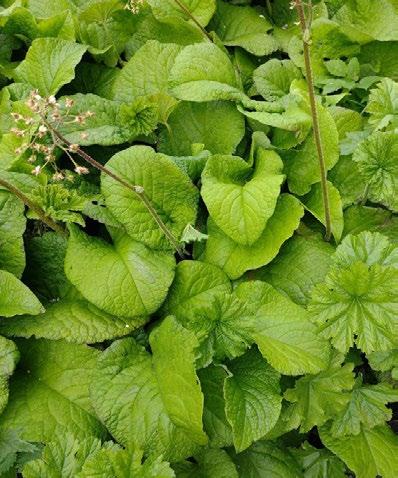
Trachystemon orientalis (with Darmera peltata), Arbigland, Kirkcudbrightshire (v.c. 73). Drew Davidson
that has deeply 3- to 7-lobed leaves and hairy pale pink or pink-spotted white corollas. It is a rather rare, unpredictable garden escape in Britain and Ireland. In the past it was also cultivated as a medicinal herb that was thought to ease birth pains and the symptoms of heart conditions. It has not been as persistent an herbal relic as Aristolochia clematitis (Birthwort), which has similar associations. It has also been a grain alien (Clement & Foster, 1994). Stace (2019): 658.
V.c. 83 (Midlothian)
Centaurea × gerstlaueri (Hybrid Knapweed). Edinburgh (NT2772), 4/8/2023, J. Harding-Morris & M. Harding (comm. M. Harding): on the way to Arthur’s Seat. The first v.c. 83 record since 1886. Discovered while checking for C. debeauxii, itself only recorded in v.c. 83 for the first time in 2023; it stood out because the apical portion of the phyllaries was ‘jacea-like’, being flattened, translucent and with little of the regular toothing of typical C. nigra Juncus anthelatus (Lax-flowered Rush). Barnton (NT1976), 10/10/2023, S. Jury & D. McKean (conf. M.P. Wilcox): some six clumps in damp grassland,
Bruntsfield Golf Course. The first record for Scotland. A densely tufted N. American perennial (Juncaceae), very like J. tenuis (Slender Rush), differing in longer inflorescence, taller stature and the smaller capsules not reaching as far up the tepals. There are now records for v.cc. 9, 11, 13, 24 (1955, earliest), 58, 59 and 63, equating to some nine sites. An origin in imported American hay has been suggested for J. tenuis s.l. but the precise means of arrival for the segregates is uncertain. Adventives & Aliens News 12, v.c. 9. Stace (2019): 982.
V.c. 86 (Stirlings)
Polystichum munitum (Western Sword-fern). Milton of Buchanan (NS44409032), 14/4/2023, M. Harding: one large clump in a hedgerow at the roadside edge. New to v.c. 86. A tufted, evergreen, one-pinnate fern from N. America and a garden plant in Britain and Ireland. P. acrostichoides (Michaux) Schott (Christmas Fern), also from N. America, is very similar but in that species the fertile upper pinnae are much contracted (vs fertile and sterile pinnae not differing markedly). Adventives & Aliens News 14, v.c. 14. Stace (2019): 35.
Trifolium aureum (Large Trefoil). Mugdock Castle (NS54977718), 23/7/2023, BSBI Field Meeting (det. M. Harding): one large plant growing out of the foundations of an outbuilding. The second v.c. 86 record. A spring and autumn germinating annual (Fabaceae) native to much of central and eastern Europe and mainly a casual of waste/marginal places in Britain and Ireland, rarely naturalising and much less common than formerly. Like T. campestre (Hop Trefoil) but more erect, with darker yellow flowers, leaves with a shorter stalk to the apical leaflet (<0.5 mm vs >0.5 mm) and linear-oblong stipules (vs ovate). Stace (2019): 185.
Potentilla norvegica (Ternate-leaved Cinquefoil). Stanley Brig (NS54757586), 19/7/2023, S. Longrigg (comm. M. Harding): two flowering fruiting plants in Allander Park. The second v.c. 86 record. An annual to short-lived perennial herb (Rosaceae), native to northern, central and eastern Europe; a casual or naturalised garden escape, grain, bird-seed and iron ore alien of road sides and other waste places in
BSBI NEWS 156 | Spring 2024 47 ADVENTIVES & ALIENS: Adventives & Aliens News 32
Britain and Ireland. P. rivalis, from N. America, is also ternate-leaved but it has smaller petals (1–2 mm long vs 4–5 mm long), c. half as long as sepals (vs c. threequarters as long as sepals), fewer stamens (5–10 vs c. 20) and smooth mature achenes (vs ridged). Stace (2019): 271.
V.c. 104 (N. Ebudes)
Muscari armeniacum (Garden Grape-hyacinth). Portnalong (NG35203479), 28/4/2023, S. Bungard, N. Roberts & W. Macruary (comm. S. Bungard): naturalising slowly from planted. The first v.c. record. A bulbous perennial neophyte (Asparagaceae) native to south-eastern Europe, it has linear channelled leaves and bright blue urn-shaped corollas in a condensed terminal raceme. A very popular garden plant often becoming established as an escape, it is also planted or deliberately sown in places where confusions over status might arise. Clement et al. (2005), p. 419. Stace (2019): 967.
V.c. 108 (W. Sutherland)
Podocarpus macrophyllus (Thunb.) Sweet (Buddhist Pine). Nedd (NC137319), 2/2024, I.M. Evans (det. C. Crook): appeared spontaneously and present for several years in the middle of a shrubbery in a garden, now overtopping other species. It might have been bird-sown from a distant source as it is known to not be present in the nearest large gardens, a few km away (Ian Evans pers. comm). There are no other records in the DDb. An evergreen, dioecious tree (Podocarpaceae) to c. 20 m. A native of parts of China and Japan, it has alternate, spirally arranged
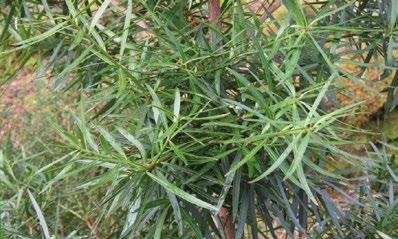
Podocarpus macrophyllus, Nedd, West Sutherland (v.c. 108). Ian Evans
lanceolate-linear leaves, c. 8–12 cm × 7–12 mm. The mature bark is reddish grey brown, peeling in long shaggy flakes. The mature fruits are carried on short stalks and consist of a fleshy, reddish-purple, berrylike aril bearing one or two apical seeds.
V.c. H21 (Co Dublin)
Eryngium amethystinum (Italian Eryngo). Swords (O18664525), 31/1/2024, A. FitzGerald (conf. P.R. Green): three erect plants in short mown grass of roadside verge by a roundabout just south-east of Airside Business Park, seemingly self-sown. The second Irish record (based on DDb data) and second for Co. Dublin. Also seen by Alexis FitzGerald on another road verge by a roundabout at O17724413 (2/3/2024). A glabrous, perennial herb (Apiaceae) to c. 60 cm. It has spiny pinnate basal leaves, deeply lobed spiny upper stem leaves, small ovoid capitula (1.3–2.0 cm across) in branched terminal clusters and an involucre of 6 to 8 spiny, narrow-linear bracts. All of the upper parts of the plant are a vivid bluish-violet. A garden escape from central and south-eastern Europe. It was established on dunes in v.c. 49 from 1963 (Clement & Foster, 1994), the last formal records for 1980 and the 1987–1999 date class. Stace (2019): 851.
References
Clement, E.J. & Foster, M.C. 1994. Alien Plants of the British Isles. Botanical Society of the British Isles, London.
Clement, E.J., Smith, D.P.J. & Thirlwell, I.R. 2005. Illustrations of Alien Plants of the British Isles. Botanical Society of the British Isles, London.
Leslie, A.C. 1987. Flora of Surrey, Supplement and Checklist. A.C. & P. Leslie, Guildford.
Poland, J. & Clement, E.J. 2020. The Vegetative Key to the British Flora (2nd edn). John Poland, Southampton.
Reynolds, S.C.P. 2002. A Catalogue of Alien Plants in Ireland. National Botanic Gardens, Glasnevin.
Ryves, T.B., Clement, E.J. & Foster, M.C. 1996. Alien Grasses of the British Isles. BSBI, London.
Stace, C.A. 2019. New Flora of the British Isles (4th edn). C & M Floristics, Middlewood Green, Suffolk.
Sussex Botanical Recording Society. 2018. The Flora of Sussex. Pisces Publications, Newbury.
48 BSBI NEWS 156 | Spring 2024 ADVENTIVES & ALIENS: Adventives & Aliens News 32
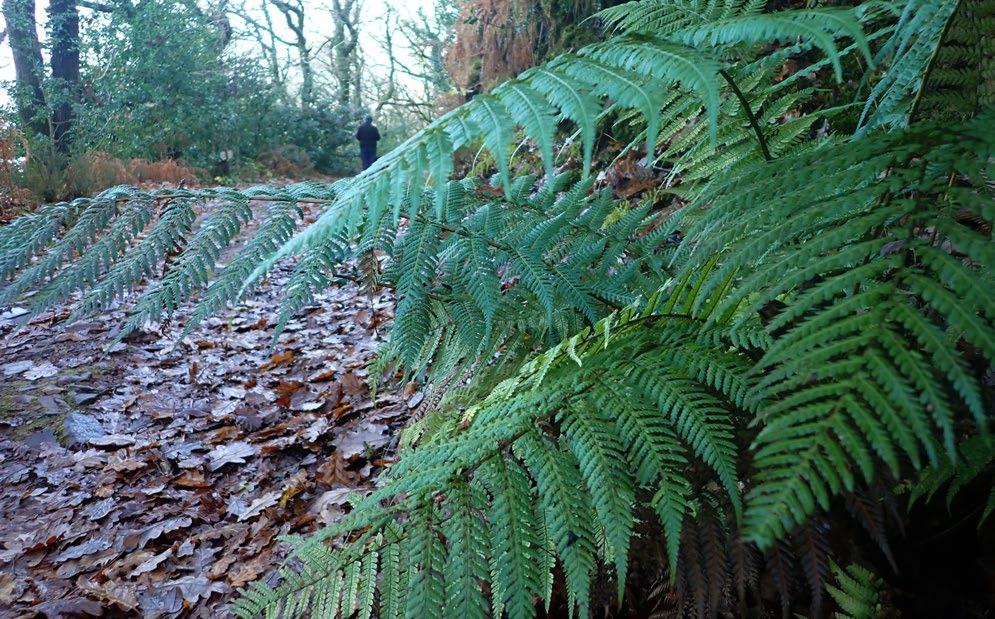
New naturalisations in coastal woodland of Exmoor (v.c. 5)
GRAHAM LAVENDER
Exmoor National Park (v.c. 5) has an almost unbroken strip of coastal temperate oak woodland from the Devon/Somerset boundary in the west to Porlock in the east, stretching a distance of more than 9 km. Although much is north-facing, the steepness of the wooded strip and the proximity to the sea, create a microclimate which has little or no frosts. This article is to draw attention to four naturalisations within the coastal woodland noted over the past few years, all of which seem to be flourishing.
Dicksonia antarctica (Australian Tree-fern) was recorded in 2021 as 12 plants to 2 m in height on the edge of woodland in one location. It has probably spread by spores from the nearest garden where large specimens are visible. In 2023 a total of 59 plants were recorded, but this time they had spread well beyond the original location to the edges of paths throughout the woodland. The tallest are now in the region of 2.5 m. The DDb has a
Dicksonia antarctica (Australian Tree-fern), December 2022. Photographs by the author
scattering of D. antarctica throughout the UK and Ireland, but the only concentration of records is in the southernmost tip of Cornwall1. Given the numbers and variation in size of plants in v.c. 5 it is possible we are seeing Dicksonia antarctica establishing as part of the flora in this part of Somerset.
Hoheria sexstylosa (Long-leaved Lacebark) seems to be established in the oak woodland above West Porlock where there are 17 trees, all between 2 m and 3 m tall with a few small saplings. This species is also likely to have spread from nearby gardens, but the abundant fruits on the trees in the autumn of 2023 suggests that this is likely to have become a spreading population. The DDb has six dots scattered around the UK and three from Ireland
1 BSBI Distribution Database: database.bsbi.org [accessed 12/09/2023]
BSBI NEWS 156 | Spring 2024 49
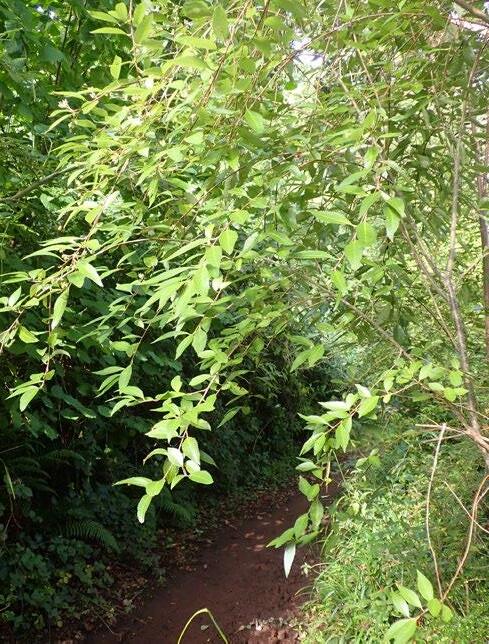
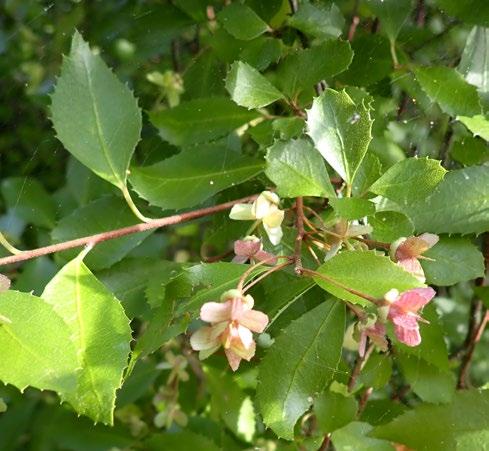
Hoheria sexstylosa (Long-leaved Lacebark), September 2023.
suggesting that H. stylosa is a casual throughout UK, but the number of trees and range of sizes in v.c. 5 suggests naturalisation.
A Neillia (probably thibetica or sinensis) has formed a small thicket of some eight plants on the edge of a small stream above Porlock Weir within the coastal oak woodland. It is a little hard to determine exact numbers, as they are all multi-stemmed. A further 13 plants have been found beside a second small stream a short distance away. Unfortunately the 2–2.5 m plants did not flower in 2023 so it is not possible to separate the two taxa without confirming essential floral characteristics. It again seems possible this Neillia sp. is now naturalised, especially since the colonies along the two separate streams suggest a degree of spread from whichever is the primary site.
The fourth possible naturalisation is of Photinia (Stranvaesia) davidiana (Stranvaesia), which was probably originally planted but has now spread over an area of some 12 m × 6 m beside a small stream. More than ten plants have become established. Ian Green recorded a single specimen in the hectad in 1993, which is in the Atlas Flora of Somerset (Green et al., 1997 ). J. R. Palmer suggested Photinia davidiana may become a future member of the British flora (Palmer, 1984); from the scattered records around the UK and established plants in v.c. 5, it is possible he was correct.
V.c. 5 was well recorded between 1989 and 1997 for the Atlas Flora of Somerset and with the exception of the Photinia davidiana none of the other three taxa were recorded in the publication. The flora is changing and we have now lost a number of species from Exmoor in v.c. 5, as can be seen from the Rare Plant Register for the County (Somerset Rare Plants Group, 2024). It remains to be seen whether the above four species become a part of the flora of Somerset in the future.
Acknowledgements
Thanks to Lady Rosemary FitzGerald for encouragement and advice.
50 BSBI NEWS 156 | Spring 2024
Exmoor (v.c. 5)
ADVENTIVES & ALIENS: New naturalisations in coastal woodland of
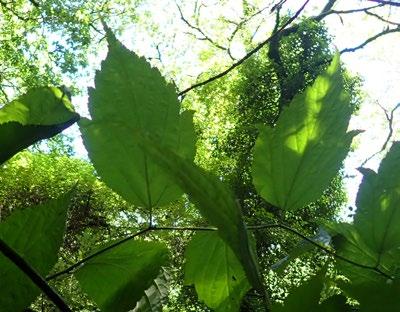
References
Green, P. & Green I.P. & Crouch, G.A. 1997. The Atlas Flora of Somerset. Self-published.
Palmer J.R. (1984). Stranvaesia davidiana – A future member of the British flora. BSBI News 36: 27.
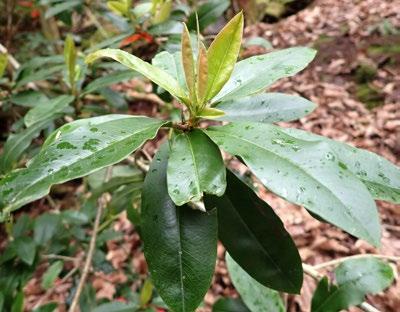
Somerset Rare Plants Group 2024. Rare Plant Register: somersetrareplantsgroup.org.uk/new-rare-plant-register
Graham Lavender
grahamlavender@hotmail.com
A re-appraisal of Wolffia in Britain
RICHARD LANSDOWN
Following the discovery of the non-native Wolffia columbiana in the Gwent, Pevensey and Somerset Levels (Lansdown et al., 2022), other sites from which W. arrhiza populations had been reported were visited to establish which species were present. Specimens in the herbarium of the Natural History Museum, collected as W. arrhiza, were also reviewed. The aim of this project was to establish the extent of colonisation by W. columbiana and the status of W. arrhiza in Britain.
Results and discussion
The first British record of Wolffia (as W. arrhiza) was made around 1816 (as ‘about fifty years ago’) (Gray, 1866) and it was reported from ‘a pond near Staines’ by Trimen (1866). Many of the herbarium specimens could not be identified due to issues to do with collection and curation. However, two of these records have now been shown to be W. columbiana
Subsequent records were all from areas such as West and North London, apart from a record from ‘near Canterbury’ in 1869, Frensham Great Pond in 1882, then other sites in Kent, as well as near the docks in Cardiff, in 1899 (Figure 2).
Wolffia columbiana has now been recorded in Britain from nine vice counties and six main areas: West London, the Arun Valley, Gwent Levels, Pevensey Levels, Romney Marsh and the Somerset Levels (Figure 1, Table 1, Plate 1). These represent all of the areas from which any Wolffia species had previously been recorded in Britain (Stroh et al., 2023). A single population of W. globosa was found mixed with W. columbiana in an isolated farm pond at Haxted, Surrey (v.c. 17) (Lansdown et al., 2022) (Plate 2).
Comparison of Figure 1 with the distribution in Plant Atlas 2020 (Stroh et al., 2023) shows that whilst there still remain many ten kilometre squares from which Wolffia populations have been recorded and
BSBI NEWS 156 | Spring 2024 51
Neillia sp., September 2023. Photinia davidiana (Stranvaesia), April 2023.
ADVENTIVES & ALIENS: A re-appraisal of Wolffia in Britain
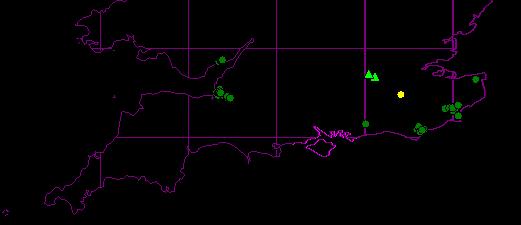
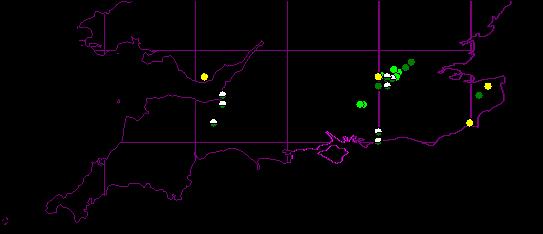
Figure 2. Records of Wolffia in Britain (derived from the BSBI database) made before 1920. 1850–1869: dark green; 1970–1890: light green; 1891–1900: yellow; 1901–1920: split colour.
which have not been shown to support W. columbiana, all areas from which Wolffia populations have been recorded now support W. columbiana. In the site surveys and review of herbarium specimens, no W. arrhiza was confirmed, all identifiable plants being W. columbiana except for the single population of W globosa
As shown by Tim Rich, botanical recording was becoming well established by the middle of the 19th century (Rich, 2006). If any Wolffia species were widespread before this, it is likely that they would have been recorded. The pattern of records before 1920 shows the gradual spread from West London to Kent, South Wales and the Somerset Levels. Confirmation that at least some of these early records were W. columbiana and the failure to confirm the presence of W. arrhiza in the country, combined with the current distribution of W. columbiana and the history of records of any Wolffia species in Britain,
strongly support the idea that W. arrhiza was never native to Britain and may, indeed, never have actually occurred in Britain. If W. arrhiza is present in Britain, then it is likely to be rare and to occur mixed with populations of other Wolffia species.
Acknowledgements
I am very grateful to Sue Buckingham, Geoffrey Kitchener and Richard Moyse for details of populations in Kent, Mags Cousins for access to an image from Pulborough Brooks, to Helena Crouch, Fred Rumsey and Nick Stewart for help with populations in Somerset and to Chris Dixon for access to specimens in the herbarium of the Natural History Museum. I am also grateful to Tim Pankhurst for comments on a previous draft of this article. Fieldwork in 2023 was funded by Natural England under the Species Recovery Programme.
52 BSBI NEWS 156 | Spring 2024
Figure 1. Confirmed records of Wolffia columbiana (dark green circles: field records; pale green triangles: herbarium specimens) and W. globosa (yellow) from Britain.
ADVENTIVES & ALIENS: A re-appraisal of Wolffia in Britain
BSBI NEWS 156 | Spring 2024 53
v.c. Site Grid ref Date Collectors 5 Brock’s Pill Rhyne, Somerset Levels ST3645952160 14.10.2021 RVL 6 Worston Bridge ST32174856 14.9.2023 HJC, FJR, RVL 6 Burnham Moor Lane ST34164785 14.9.2023 HJC, FJR, RVL 6 East Huntspill ST34564562 14.9.2023 HJC, FJR, RVL 6 Mark, Dutch Road ST35204843 14.9.2023 HJC, FJR, RVL 6 Vole ST36634978 14.9.2023 HJC, FJR, RVL 6 Mark, Wellfield House ST37084868 14.9.2023 HJC, FJR, RVL 6 Totney Drove, Tealham ST40934502 14.9.2023 HJC, FJR, RVL 6 Meare, N of ST45144266 14.9.2023 HJC, FJR, RVL 6 Westhay Moor ST45744412 14.9.2023 HJC, FJR, RVL 6 Godney ST48484281 14.9.2023 HJC, FJR, RVL 6 Mark Cricket Ground ST37324823 14.9.2023 HJC, FJR, RVL 13 Amberley Wild Brooks TQ0213 2017 MC, JW 14 Pevensey Levels TQ6079407513 2018 EJ 14 Pevensey Levels TQ6731508374 21.10.2021 RVL, EJ 14 Pevensey Levels TQ6769507649 21.10.2021 RVL, EJ 14 Pevensey Levels TQ6731508375 22.9.2021 RVL, EJ 14 Pevensey Levels TQ6769507649 22.9.2021 RVL, EJ 14 Pevensey Levels TQ6889807102 22.9.2021 RVL, EJ 14 Pevensey Levels TQ6079407513 23.9.2021 RVL, EJ 14 Pevensey Levels TQ6257610580 7.10.2021 RVL, EJ 14 Pevensey Levels TQ6459004199 7.10.2021 RVL, EJ 14 Pevensey Levels TQ6612906062 7.10.2021 RVL, EJ 15 lake beside R. Stour, Pluck’s Gutter TR276631 14.10.2021 AJL 15 Reading Street TQ9211830103 16.10.2021 SB 15 Kenardington TQ9784331262 16.10.2021 SB 15 Kenardington TQ9792431284 16.10.2021 SB 15 Brenzett Corner TR0105928444 16.10.2021 SB 15 Newchurch TR0432831885 16.10.2021 SB 15 Greatstone TR0763822856 16.10.2021 SB 15 Bainbridge Farm TR01873169 2.9.2023 RM 15 Reading Street TQ9211830103 21.9.2023 RVL 15 Kenardington TQ9784331262 21.9.2023 RVL 15 Kenardington TQ9792431284 21.9.2023 RVL 15 Brenzett Corner TR0105928444 21.9.2023 RVL 15 Wills Lane, Newchurch TR0432831885 21.9.2023 RVL 15 Greatstone-on-sea TR0763822856 21.9.2023 RVL 15 Royal Military Canal, Giggers Green Bridge TR071343 6.10.2023 RM 17 1141 Pond on Apse Farm, between Walton and Molesey, Surrey (BM) one plant flowering. 1868 HCW 21 Pond by the railway station at Staines, Middlesex May 1870 WWR 35 Saltmarsh Reen, Gwent Levels ST3522183377 12.10.2021 RVL 35 Parish Reen, Gwent Levels ST3727585348 12.10.2021 RVL 35 Parish Reen, Gwent Levels ST3770585502 12.10.2021 RVL 35 Parish Reen, Gwent Levels ST3824884860 12.10.2021 RVL 35 Elver Pill Reen, Gwent Levels ST3878685127 12.10.2021 RVL 35 Middle Road Reen, Gwent Levels ST3968485694 12.10.2021 RVL Key to collectors: AJL – A.J. Lockton, EJ – E. Jones, FJR – F.J. Rumsey, HCW – H.C. Watson, HJC – H. Crouch, JW –J. Whitman, MC – M. Cousins, RM – R. Moyse, RVL – R.V. Lansdown, SB – S. Buckingham, WWR – W.W. Reeves.
Table 1. Records of Wolffia columbiana in Britain.
in Britain
ADVENTIVES & ALIENS: A re-appraisal of Wolffia
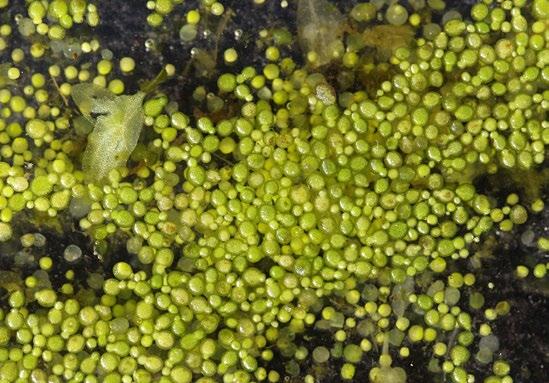
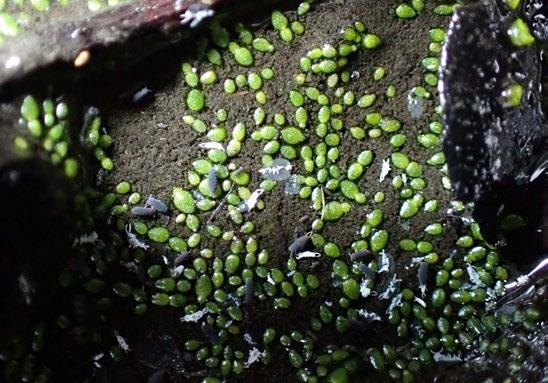
References
Gray, J.E. 1866. A new station of Wolffia arrhiza Journal of Botany, British and foreign 54: 263–264.
Lansdown, R.V., Kitchener, G. & Jones, E. 2022. Wolffia columbiana and W. globosa (Araceae) new to Britain. British & Irish Botany 4(1): 14–26. doi.org/10.33928/bib.2022.04.014
Preston, C.D. 2023. Wolffia arrhiza (L.) Horkel ex Wimm. In: Stroh, P.A., Humphrey, T.A., Burkmar, R.J., Pescott, O.L., Roy, D.B. & Walker, K.J. (eds), BSBI Online Plant Atlas 2020: plantatlas2020.org/atlas/2cd4p9h.5rw [accessed 12/10/2023]
Rich, T.C.G. 2006. Floristic changes in vascular plants in the British Isles: geographical and temporal changes
in botanical activity 1836–1988. Botanical Journal of the Linnaean Society 152: 303–330.
Trimen, H. 1866. Wolffia arrhiza Wimmer, in England. Journal of Botany, British and Foreign 4: 219–223.
Stroh, P.A., Walker, K.J., Humphrey, T.A., Pescott, O.L. & Burkmar, R.J. (eds) 2023. Plant Atlas 2020: Mapping Changes in the Distribution of the British and Irish Flora. Princeton University Press. plantatlas2020.org
Richard V. Lansdown
Referee for aquatic plants rvlansdown@gmail.com
54 BSBI NEWS 156 | Spring 2024
Plate 1 (top). Wolffia columbiana, Pevensey Levels, 2021, showing yellowish-green colour and budding fronds rounded. Plate 2 (bottom): Wolffia globosa, pond near Haxted, 2023, showing deeper green colour and budding fronds elongate.
ADVENTIVES & ALIENS: A re-appraisal of Wolffia in Britain
Herniaria glabra (Smooth Rupturewort) as a pavement weed in Surrey … on the 7th floor!
JONTY DENTON & MOLLY CROOKSHANK
On7 May 2021 whilst carrying out invertebrate surveys on the green roofs on the roof of the Drake Building, a 7-storey tower block in the Trafalgar Place development, Elephant & Castle, Surrey (v.c. 17) (TQ322787) JD noticed a sprawling patch of what he suspected was Herniaria glabra (Smooth Rupturewort). MC used the Picturethis smartphone app which agreed with the identification. It proved to be widespread on the western half of the roof of the Drake building, growing primarily along the paved path network. It was still present on 15 July, having enjoyed a damp cloudy summer with little risk of premature shrivelling!
However, the drought of 2022 had resulted in near complete dieback, so it was with trepidation when we revisited in May 2023. But the regeneration was remarkable, with the Herniaria again present in the same path section, accompanied by Trifolium
arvense (Hare’s-foot Clover), but with none detected in the adjacent artificial substrate.
The origins of this scarce plant are unknown, but it is perhaps telling that it occurs close to an area with abundant Thymus serpyllum (Breckland Thyme) which was also much reduced during the post-2022 drought where it had been locally dominant in 2021. Seed contaminant from a Breckland source?
It is sold as a garden plant as ‘Burstwort’ but NBN lists no inner Greater London records and the only Surrey records appear to be from the RHS gardens, Wisley in 2002.
Jonty Denton
31 Thorn Lane, Four Marks, GU34 5BX
jontydenton@aol.com
Molly Crookshank
20 First Avenue, Hove, BN3 2FE
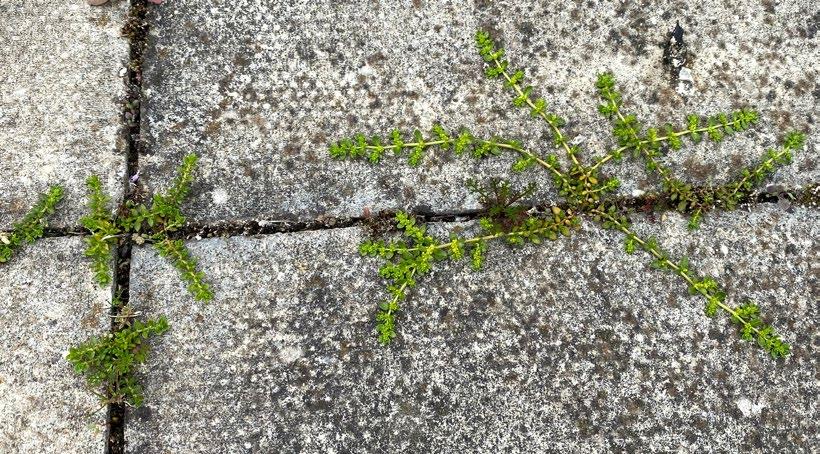
BSBI NEWS 156 | Spring 2024 55 ADVENTIVES & ALIENS: Herniaria
(Smooth Rupturewort) as a pavement weed in Surrey
glabra
Herniaria glabra (Smooth Rupturewort), Elephant & Castle, Surrey (v.c. 17). Jonty Denton
ADVENTIVES
Using Plant Alert as part of a gardener engagement project in North West Wales
TOMOS JONES, LISA TOTH & KATHARINA DEHNENSCHMUTZ
Throughout 2023, Plant Alert was the focus of a project called Garden Escapers, engaging directly with gardeners across North West Wales with the aim to identify and prevent future invasive species. This project was co-led by Coventry University and North Wales Wildlife Trust (NWWT) and funded as part of the Resilient Communities Grant programme by Natural Resources Wales. We focused on three target areas (shown below) across North West Wales (Ynys Môn, Conwy and Gwynedd). The process of choosing the target areas considered the following main criteria:
• Distribution of invasive species, specifically ones listed under long-term management in the Wales Invasive Priority Species for Action list (see below).

• Main areas of population (2011 census data).
• Protected sites such as SSSIs and Eyri National Park nearby. We also looked at NWWT reserves.
Although the criteria were set up to be systematic in choosing the target areas, there was also an element of expert judgment (e.g. gardening interests). To engage with gardeners in these areas we organised workshops and conducted ornamental plant inventories in private gardens.
Gardeners’ workshops
We delivered six interactive workshops engaging with 78 gardeners. The workshops involved: an introduction to invasive species and solutions for gardeners through the Be Plant Wise campaign of the GB Non-Native Species Secretariat and Plant
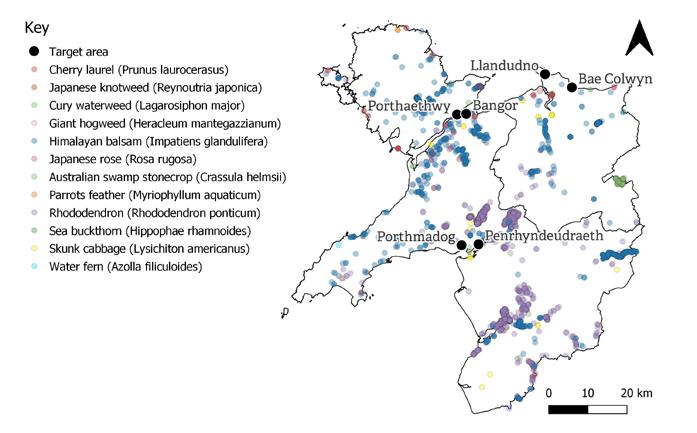
Map of North West Wales showing distribution (2010–2022) of long-term management invasive plants and the three target areas. Contains public sector information licensed under the Open Government Licence v3.0 and National Biodiversity Atlas (NBN) Atlas occurrence data.
56 BSBI NEWS 156 | Spring 2024
& ALIENS: Using Plant Alert as part of a gardener engagement project in North West Wales
Table 1. The ten most commonly recorded taxa via Plant Alert in North West Wales (1/1/24–14/11/2024) and across Britain and Ireland (as of 12/3/2024). n = number of records. Ones in bold are recognised as invasive species in Stace & Crawley (2015) and/or listed on Schedule 9 of the Wildlife and Countryside Act.
North West Wales Britain and Ireland
Anemone × hybrida s.l. (Japanese Anemone) [n = 4]
Centranthus ruber (Red Valerian) [n = 3]
Cotoneaster horizontalis (Wall Cotoneaster) [n = 4]
Verbena bonariensis (Argentinian Vervain) [n = 3]
Leycesteria formosa (Himalayan Honeysuckle) [n = 2]
Buddleja davidii (Butterfly-bush) [n = 2]
Convolvulus arvensis (Field Bindweed) [n = 2]
Crocosmia × crocosmiiflora (Montbretia) [n = 2]
Hyacinthoides hispanica (Spanish Bluebell) [n = 2]
Euphorbia amygdaloides (Wood Spurge) [n = 2]
Alert; interactive tasks such as an ID test; and a tour of nearby protected sites to show examples of invasive species.
Garden visits and Plant Alert
Garden visits were conducted to: (1) measure awareness levels via an online survey; (2) complete a full inventory of ornamental plants growing in the garden; and (3) ask which are spreading too much, via Plant Alert. Inventories were completed for 27 gardens in the target areas, with around 745 different ornamentals (native and non-native) recorded. The preliminary list of the five most commonly found is: Lavandula angustifolia (Garden Lavender)
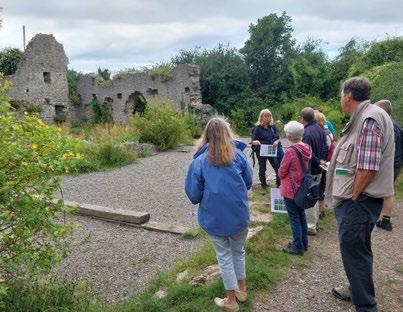
Impatiens glandulifera (Himalayan Balsam) [n = 34]
Reynoutria japonica (Japanese Knotweed) [n = 31]
Pentaglottis sempervirens (Green Alkanet) [n = 25]
Leycesteria formosa (Himalayan Honeysuckle) [n = 23]
Anemone × hybrida s.l. (Japanese Anemone) [n = 17]
Allium triquetrum (Three-cornered Garlic) [n = 16]
Houttuynia cordata (Fish-plant) [n = 15]
Pilosella aurantiaca (Fox-and-cubs) [n = 15]
Lamiastrum galeobdolon subsp. argentatum (Yellowarchangel variegated form) [n = 11]
Symphoricarpos albus (Snowberry) [n = 9]
[ n = 21], Crocosmia × crocosmiiflora (Montbretia) [n = 20], Euonymus fortunei [n = 20], Verbena bonariensis (Argentinian Vervain) [n = 20] and Linaria purpurea (Purple Toadflax) [n = 18]. Note this list only includes species (i.e. records at genus level not included). For Plant Alert, around 112 records were received in North West Wales during the project, including around 55 different plants (excluding genus level records). The ten most commonly recorded taxa –along with long-term results for Britain and Ireland – are shown in Table 1 with the number of records.
This summary of the data shows the effectiveness of engaging with gardeners to identify potentially invasive species; Leycesteria formosa (Himalayan
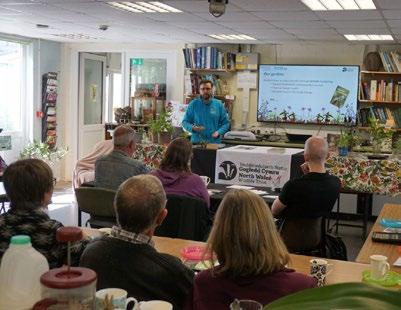
BSBI NEWS 156 | Spring 2024 57 ADVENTIVES & ALIENS: Using Plant Alert as part of a gardener engagement project in North West Wales
Tour of Bryn Euryn as part of a workshop delivered in Rhos on Sea (left) and a talk introducing the issue of invasive species (right) at Treborth Botanic Garden. Lisa Toth
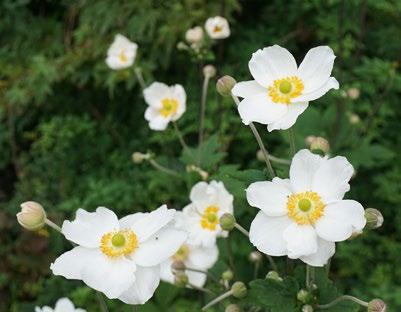
Honeysuckle) and Verbena bonariensis (Argentinian Vervain) were among the taxa prioritised by Jones et al. (2024) as being in need of their invasive potential explored, such as through a formal risk assessment, as well as in an earlier analysis of the Plant Alert data (Dehnen-Schmutz et al., 2022). In our measurement of awareness, gardeners were asked if they knew that selected examples of ornamental plants are considered invasive species: for Buddleia davidii (Butterfly-bush) 52% knew, while 60% knew Cotoneaster horizontalis (Wall Cotoneaster) and Crocosmia × crocosmiiflora (Montbretia) are considered as invasive species. This summary also demonstrates challenges in identification. For example, records of Hyacinthoides hispanica (Spanish Bluebell) are likely to be of H. × massartiana (Hybrid Bluebell) because H. hispanica is uncommon in gardens and rarely found in the wild (Rumsey, 2023). Convolvulus arvensis (Field Bindweed) would be better described as a garden weed than an invasive species because it is native. Records of Euphorbia amygdaloides are likely to be subsp. robbiae, which is a common garden plant and is mainly found in the wild as a garden escape (Lambert & Cox, 2023).
Stakeholders workshop
The project culminated with a stakeholder workshops in Bangor. This was organised to bring relevant stakeholders (e.g. professional gardeners,
botanic gardens and researchers) together to discuss experiences and challenges with the issue of invasive species escaping gardens through talks by guest speakers and facilitated break-out sessions to look at solutions. Feedback from this workshop will inform the next phase of the Garden Escapers project and hopefully the GB Horticulture Pathway Action Plan.
Conclusion
This Garden Escapers project has demonstrated the importance of engaging with gardeners directly to identify potentially invasive species, e.g. Leycesteria formosa and Verbena bonariensis. Further research will continue to assess the potential impacts of climate change on invasive potential and we will explore why if an invasive species such as Cotoneaster horizontalis is growing in gardens why this is not recorded via Plant Alert.
References
Dehnen-Schmutz, K., Kutlvašr, J. & Webb, A. 2022. Plant Alert – results from the first three years. BSBI News 151: 50–53.
Jones, T.S., Culham, A., Pickles, B.J. & David, J. 2024. Can gardeners identify ‘future invaders’? NeoBiota 91: 125–144. Lambert, S. & Cox, J.H.S. 2023. Euphorbia amygdaloides subsp. robbiae. In: Stroh P., Walker K., Humphrey T.A., Pescott O.L., Burkmar R. (eds). Plant Atlas 2020: Mapping Changes in the Distribution of the British and Irish Flora. Princeton University Press.
Rumsey, F.J. 2023. Spanish and hybrid bluebells (Hyacinthoides hispanica agg.). In: Stroh P., Walker K., Humphrey T.A., Pescott O.L., Burkmar R.J. (eds). Plant Atlas 2020: Mapping Changes in the Distribution of the British and Irish Flora. Princeton University Press.
Stace, C.A. & Crawley, M.J. 2015. Alien Plants. Collins, London.
Tomos S. Jones1,2, Lisa Toth2 and Katharina Dehnen-Schmutz1
1Centre for Agroecology, Water and Resilience (CAWR), Coventry University, Wolston Lane, Rytonon-Dunsmore, Coventry, CV8 3LG
2North Wales Wildlife Trust, Llys Garth, Garth Road, Bangor, LL57 2RT
tomos.jones@northwaleswildlifetrust.org.uk
58 BSBI NEWS 156 | Spring 2024 ADVENTIVES & ALIENS: Using Plant Alert as part of a gardener engagement project in North West Wales
Anemone × hybrida s.l. (Japanese Anemone).
Lisa Toth
NOTICES
NEW PROJECTS AND STAFF IN ENGLAND AND WALES
We have some new projects starting and a few changes in staff roles this spring. From April, the Scientific and England Officer role has been separated into two roles: Scientific Officer (Pete Stroh), focusing on leading science projects (such as the Red List for vascular plants in Great Britain) and England Officer (Sam Thomas).
Sam Thomas has joined us as England Officer to deliver a one-year pilot project funded by Natural England, to increase support for vice-county recorders in England and overcome barriers to recording, data flow and mobilisation of data.
We have also received Nature Network funding from the Welsh Government and National Lottery Heritage Fund. This is for a 2-year project focusing on Priority Plants on Sites of Special Scientific Interest in Wales. We are recruiting for a Wales Officer to support this project and the county recorders involved in it.
Sam and the new Wales Officer both join our Countries Support Team, led by James HardingMorris (Countries Manager) and with Bridget Keehan (Ireland Officer), Jen Farrar (Northern Ireland Botanical Skills Officer), Matt Harding (Scotland Officer) and Chantal Helm (Training Coordinator, FISC & Identiplant).
Julia Hanmer
Chief Executive julia.hanmer@bsbi.org
DATES FOR YOUR DIARY
This year’s programme of field meetings and indoor events is our biggest ever. Full details are on the website (bsbi.org/field-meetings-and-indoorevents) which provides details of, and booking links for, all this summer’s field meetings, dates of our autumn conferences and ends with our fourteenth New Year Plant Hunt which runs from 29 December 2024 to 1 January 2025. There’s a handy filter so you can search under categories such as Training, Recording, Specialised or Beginners, to help you find the kinds of events you are looking for.
Here are a few other dates you might want to put in your diaries now, get ready to book and keep an eye on the website for further updates:
• Annual Summer Meeting: 20–24 May
• Wales Annual Meeting: 5–7 July
• Irish Autumn Meeting: 12 October
• Scottish Botanists’ Conference: 2 November
• British & Irish Botanical Conference: 23 November
Louise Marsh
BSBI Communications Officer louise.marsh@bsbi.org
BSBI PHOTOGRAPHIC COMPETITION
Since 2015, BSBI has organised an annual Photographic Competition; you can see some of last year’s entries, including the winners in the categories ‘Plants in the Landscape’ and ‘People and Plants’ on pages 79–80. Entries are now open for this year’s competition and the categories have been chosen to reflect the Society’s values, as set out in our Strategic Plan. This year’s categories are:
• Intrepid: finding plants in wild places;
• Inquisitive: up close with diagnostic characters;
• Inclusive: sharing plants with others.
The link to enter is on the Photographic Competition webpage (bsbi.org/bsbi-photographiccompetition), where you will also find the rules and can see winning entries from previous years. The deadline to submit your entries is 25 October 2024. The winners will receive book tokens from Summerfield Books, who have sponsored the competition since its inception.
Louise Marsh
BSBI TRUSTEE AWARDED CBE
Congratulations to Prof Pete Hollingsworth, Director of Science and Deputy Keeper at Royal Botanic Garden Edinburgh and a BSBI Trustee since November 2023 (see bsbi.org/bsbi-trustees). In the 2024 New Year’s Honours List, Pete was awarded a CBE for services to botanical science.
Louise Marsh
BSBI MEMBER RECEIVES MARSH BOTANY AWARD
We are delighted to report that Dr Sarah Whild’s contribution to botany has been acknowledged: we hear that she has received this year’s Marsh Botany Award, which recognises an individual’s lifetime achievement and outstanding contribution in the field of botanical research and
BSBI NEWS 156 | Spring 2024 59
NOTICES
Louise Marsh
LONG-STANDING MEMBERS
The BSBI thanks every member for your ongoing support – your contribution helps to make the Society the success that it is. And particular thanks go to the following who have reached the brilliant landmark of 60 years of membership.
Joined in 1962: Mrs S. Wells. Joined in 1963: Mr E.J. Clement; Prof. A. Davy, Mr R.E. Groom; Dr A.J. Morton, Mr D.T. Price, Mr R.J. Swindells, Dr G. Wynne.
Sarah Woods
BSBI AWARDS 2023
It is with great pleasure that we can announce the Awards made to members who were nominated in the two Award categories. We express our thanks to those making nominations and our congratulations to those receiving the award.
The Nominations, Awards and Governance Committee considers the nominations and recommends these to the Board at its March meeting. More details and nomination forms can be found on the Awards page of the website at bsbi. org/nominations-awards or from the Chair.
The Board would encourage members to come forward with nominations for 2024 and asks that members especially consider female members who merit consideration given the all-male lists for 2022 and 2023. The deadline for receipt is 31 December 2024.
An Outstanding contribution to Botany in your area (county, region or country)
Malcolm Macneill nominated by Michael Philip Malcolm is nominated for his extensive urban recording work in Glasgow and surrounding areas, resulting in a clearer picture of the urban flora here than ever before. His knowledge of the urban environment, especially in Glasgow, is almost forensic – knowing every street, lane, kerb, car park and patch of waste ground across a huge area. His conservation. BSBI members who have received this accolade, awarded by the Marsh Charitable Trust, in recent years include John Richards and David McCosh (2022), Arthur Chater (2021), Ian Bennallick (2020), Clive Stace (2019) and Libby Houston (2018). See the website for details of past awards (marshcharitabletrust.org/award/marsh-botanyaward).
painstaking work includes not only gathering huge species lists, but also making very accurate grid references and descriptions to enable checking, specimen collecting or photography by others.
Malcolm’s encyclopaedic knowledge of plants has equipped him to notice and identify plants, often vegetatively or out-of-season, which might otherwise have escaped attention. This acute observation has produced a great number of first vice-county records.
Malcolm has generated many thousands of records which contribute data not only to BSBI but also to the Botanical Society of Scotland’s ‘Urban Flora Project’. He has led group urban recording. He participated in trialling BSBI’s urban botany initiative in 2023. Malcolm is fully involved in the field outings held by local botany networks, and it is always an education to be out with him – especially in an urban context. General plant ID skills amongst the participants have been greatly improved as a result.
Ian McNeill nominated by John Faulkner jointly with all VCRs surrounding Tyrone (v.c. 40)
Ian is nominated for the extent of his recording activity in Co. Tyrone and neighbouring counties (‘Greater Tyrone’) over a period of more than 40 years. Ian started recording plants in 1980 and has been the VCR for Tyrone either jointly or solely since 1992. Tyrone, his native county, is the largest vicecounty in Ulster and the second largest in Ireland.
Although engaged full-time in school teaching, he systematically recorded the entire county and has contributed a huge number of records over a large area that would otherwise be under-recorded. In due course Ian was the driving force and lead author for the Flora of Tyrone, published in 2010 as a 374-page full-colour A4 book by National Museums, Northern Ireland.
Ian has always encouraged others to join him on excursions, learn from his expertise, and share in his humour and enjoyment of the outdoors. Perhaps his greatest botanical achievement of all has been to bring up his two sons as botanical recorders: one of them is now a member of the Committee for Ireland and VCR for Co. Antrim.
Richard Pryce nominated by Stephanie Tyler on behalf of the Welsh Committee
Richard is nominated for his long and ongoing support for Welsh botany and botanists. He has been VCR for Carmarthenshire since 1978, latterly jointly with his wife Kath and is an important member of the Committee for Wales. He took over editorship of the Welsh Bulletin in spring 1990 and has continued that role either solely or jointly up until the present.
60 BSBI NEWS 156 | Spring 2024 NOTICES
Richard and Kath arrange the annual Glynhir residential recording week which is very popular with botanists from all over Wales and further afield as they get excellent tuition from Richard.
Richard has provided botanical advice to several nature conservation fora including the Carmarthenshire Biodiversity Action Plan Partnership and local Councils on land management. He was instrumental in the formation of the Carmarthenshire Meadows Group and undertakes surveying of members’ sites and advising on best management to enhance the flora.
Richard has also been a considerable support to other VCRs in Wales and to committee members and is very well respected among botanists and decisionmakers in Wales, always providing sound advice and information. Richard was BSBI President 2002–2005 and was made an Honorary Member of the Society in 2008.
David Welch nominated by David Elston David is nominated for his contribution particularly to botanical activity in North East Scotland. He was VCR for North Aberdeenshire 1977–2023 (jointly since 2018) and Kincardineshire 1994–2023 (jointly since 2018).
He was sole author of Flora of North Aberdeenshire published in 1993 which includes a full account of the critical groups (brambles, hawkweeds, dandelions). He was a regular author of county-level articles in BSBI publications.
David was the long-standing referee for Myosotis and was a prompt responder regarding specimens and enquiries. David was also senior Scottish referee for brambles, taking over after George Ballantyne’s death.
David was botanical member of the panel of experts advising Aberdeenshire Council on the selection of Local Nature Conservation Sites and on the defence of these sites when threatened by planning applications (most memorably presenting evidence at Menie Links inquiry, now the site of a Trump International golf course).
David led over 25 annual botanical excursions in North East Scotland for Scottish Wildlife Trust. The community of botanists he helped foster has given rise to the North East Scotland Botanical Recording Network which had its first group meetings in 2023.
David died in May 2023.
An Outstanding contribution to British and Irish Botany
Tim Rich nominated by Nominations, Awards and Governance Committee
Tim Rich is probably one of the most widely known British and Irish botanists today. He has outstanding field identification skills, a role as referee for four
genera/families, a prolific contribution through scholarly botanical papers and monographs, talks and workshops, social media output, TV appearances and research undertakings over a long period.
Recent regular BSBI blogposts and his own YouTube channel (Tim’s Botanical Riches) have enabled BSBI and botany to reach new audiences. His naming of a Hawkweed after Sir David Attenborough and his appearance with him on BBC TV’s ‘One Show’ is one particular highlight.
His analysis of the 1987–88 BSBI Monitoring Scheme, which he coordinated, and subsequent work on recording bias and standardised recording were groundbreaking. He coordinated publication of the Plant Crib in 1988, still a botanical best-seller. In the BSBI Handbooks series the Crucifers handbook in 1991 was followed by joint authorship of Sorbus in 2010, Hieracium section Alpestria in 2011, Gentians in 2019 and Hieracium section Foliosa and section Prenanthoidea in 2021. Tim has authored 368 publications and research papers dating from the mid-1980s to the present day and many more jointly. He has named 32 new species, subspecies, hybrids and subgenera.
He has supported several others to publish their research either as Handbooks or Floras. As a referee he responds quickly to queries from fellow botanists and his responses are often accompanied by extremely helpful ID notes.
With Sarah Whild he initiated the New Year Plant Hunt which has grown so much in popularity and relevance for BSBI.
Using his identification skills, he has collected seed from many Hieracium, Sorbus and Taraxacum species across Britain for the Millenium Seedbank, a service not only for today’s but tomorrow’s students of the British and Irish flora.
Tim was made an Honorary Member in 2006.
Chris Miles
Chair of the Trustees chris.miles01@btinternet.com
MEMBERS’ ACCESS TO BSBI’S DISTRIBUTION DATABASE
The BSBI is committed to increasing access to the information it holds for the benefit of its members and for the plants that we all care so passionately about. By providing greater access to these data, we hope to encourage more recording amongst members and increase the conservation, research and educational activities carried out by the Society and our partners throughout Britain
BSBI NEWS 156 | Spring 2024 61 NOTICES
and Ireland. We are therefore pleased to announce that from April 2024 BSBI members will be granted access to the BSBI’s central database of plant distribution records known as the Distribution Database (or DDb). This follows consultation with our Vice-county Recorders (VCRs) whom we wish to thank for their positive contributions, responses to our consultations and patience since members’ access was first mooted in 2021. We have attempted to address concerns raised by VCRs during these discussions, not least by allowing VCRs to choose the resolution at which records in their vice-county can be viewed by members and the ‘blurring’ of records for species or sites which are considered sensitive. These restrictions are needed for good reasons in some areas, and they have been agreed with the VCR. We hope that our plans represent an appropriate compromise that accommodates many of the concerns raised by VCRs and others.
How will it work?
From April BSBI members will be able to apply for access. Once this has been granted members will have access to records in the BSBI’s Distribution Database with the following exceptions:
• The records of some species will have their records blurred to protect sensitive sites/ populations. These will include national rarities blurred centrally by the BSBI as well as records of some species/sites flagged by VCRs.
• In some vice-counties members’ access will be limited to monad or tetrad resolution access as selected by the VCR.
• For all countries except Scotland, records will exclude the names of recorders, locations and notes
Important things to note
• Access will be read only; it will be impossible for members to edit or change records.
• Members will sign up to a set of terms and conditions limiting use of data. We will monitor use and intervene where terms and conditions are not followed.
• The existing level of access for VCRs and other registered DDb users will not change in any way.
• Any member actively engaged in recording or research may ask their VCR to support an application for full access to the DDb; VCRs are encouraged to put forward names of any recorder who they feel meets these criteria.
Julia Hanmer Chief Executive julia.hanmer@bsbi.org
BSBI NEWS ASSISTANT EDITOR
Iam looking for volunteers to help with the editing and production of BSBI News. Initially this would be one or more persons to assist with receiving, copy-editing and proof-reading articles and other contributions for publication, but depending on how things progress, I’d like to have an Assistant Editor to work alongside me on producing News and would therefore be able to take over the job if I decide to retire.
Please contact me by email initially if you are interested. Further details are given on the BSBI website: bsbi.org/volunteer-opportunity-bsbi-news Suitable candidates must have excellent writing and editing skills and good computer skills, e.g. in the use of Microsoft Word and photo-editing software. Training will be given in the use of the Adobe InDesign application used for producing News. You do not need to be an expert botanist but a good memory for plant names will be helpful!
John Norton BSBI News Editor john.norton@bsbi.org
YEARBOOK EDITOR
Thank you to Gwynn Ellis and David Pearman, who are stepping down from co-editing the BSBI Yearbook after over twenty years serving members in this much appreciated role. Many thanks are due for the hours of work they have put into compiling and checking the Yearbook, which is such a wonderful source of information for members. If any member is interested in editing or checking future editions of the Yearbook, please do get in touch with me.
Sarah Woods Fundraising and Engagement Manager sarah.woods@bsbi.org
READING THE DIGITAL VERSION OF BSBI NEWS
Anyone using the professional version of Adobe Acrobat to view their digital pdf versions of BSBI News will be aware that there was a major update to the software in December 2023. Unfortunately this now enables a setting by default which causes the grey tinted backgrounds to whole pages not be shown. This does not affect reading of the newsletter (and may improve it for some) but obviously it makes the pages in those sections look different to the printed version. To remedy this go to Menu,
62 BSBI NEWS 156 | Spring 2024 NOTICES
Preferences, Accessibility and unselect ‘Replace Document Colors’ at the top. I’m not sure if this also affects other versions of Acrobat or other pdf readers, but it doesn’t seem to affect web browsers, which I expect most people use to read News However, I may consider changing the design of News in the future to remove the tinted pages. What do readers think about this? I’m always interested to receive feedback on the publication.
It may also be worth pointing out that there are some useful features in the digital version of BSBI News which newer users of pdf viewers may not be aware of. Firstly, all the main articles and sections are bookmarked, which allows quick navigation to any article from the bookmarks panel. Both Google Chrome and Microsoft Edge web browsers show the bookmarks panel on the left (along with the option to view thumbnail images of each page) and in Acrobat the panel can be enabled on the right. In Chrome the panel is visible by default and stays in view, but in Edge it has to be flipped out using an icon on the left of the pdf toolbar and retracts again once a bookmark is clicked.
Another useful feature is that all page number cross-references (including those in the Contents) and hyperlinks to websites are navigable (i.e. click on these to follow a link). Note that email addresses are also navigable – I would prefer them not to be but even though not formatted as links they are automatically recognised as emails by Acrobat and the browsers, so this behaviour cannot easily be disabled.
John Norton
BSBI SCIENCE STRATEGY AND NEW PROJECTS
The BSBI Science Strategy 2024–2029 was completed in December and thanks to input from members, recorders, and partners we have a clear overall direction and wealth of ideas to take forward as part of our scientific work over the next five years. You can download a copy of the Science Strategy here: bsbi.org/download/41635. Obviously, we can’t take forward all these ideas, and so we are prioritising them against a range of criteria such as the strategic issues they address, cost and resources needed, timescale, how likely they are to be funded, who might take part in them and geography. All this information has been included in an ‘Operational Plan’ which we will be using to guide our decisionmaking and planning over the next five years.
To summarise, the key points of the strategy and plan are:
• The core of the strategy will continue to be routine recording of our flora and supporting our recording networks to do this as well as maintaining the systems needed to do this effectively (i.e. our database systems).
• The plan includes several ongoing projects such as the National Plant Monitoring Scheme in the UK, the New Year Plant Hunt, Local Change and Plant Atlas.
• The plan aspires to take forward a range of new projects over the next five years. This ‘pipeline’ of projects, some of which we hope to start in Years 1 or 2, others which will follow later but still within the 5-year period and others that are longer term, but we need to start planning for now.
We plan to start work on a few new projects over the next 12 months. One that we are very keen to develop is a monthly Wild Flower Hunt based on the New Year Plant Hunt method which will enable us to track flowering phenology and floral resources on fixed routes throughout the year. We are also considering projects that focus on montane and aquatic plants to address issues such as climate change and pollution. As in the past, participation in these new projects will be entirely voluntary but hopefully there will be something for everyone to take part in, whether you are a seasoned botanist, improver or complete beginner.
There are lots of possibilities, and the operational plan is helping us to make decisions about which comes first. For each project we are filling in the blanks – who is likely to take part, what support will they need, what is the scale of the resource needed, how could it be funded, which staff might be involved, who should we collaborate with, etc. Alongside this we continue to work on extending the botanical heatmap approach developed in England in partnership with Natural England to more countries (we are looking into this in Scotland with funding from NatureScot and in Ireland with funding from the National Parks and Wildlife Service) and we are launching a new Welsh rare plant project with funding from the Welsh Government and the Heritage Fund. However, there won’t be a new Britain and Ireland project ready for launch in 2024, which I know will be disappointing news for many of you, but we will be trialling some of the project ideas and methods so there will be scope to get involved and help shape the projects that we ultimately launch.
Kevin Walker BSBI Head of Science kevin.walker@bsbi.org
BSBI NEWS 156 | Spring 2024 63 NOTICES
NATIVE PLANT COLLECTORS AND GROWERS FOR FISCS
BSBI is keen to hear from anyone who may be interested in contributing to growing capacity for delivery of FISCs across the UK, by becoming an official plant collector or native plant grower for FISCs.
A major bottleneck in delivery of FISCs is the provision of enough interesting plant specimens from around the country to meet the strict requirements for the FISC lab tests. The lab tests require a selection of plant species from around the whole country and from a variety of different habitats.
Would you be willing to spend one morning a year collecting geographically distinct plants from your region to post to a FISC Assessor for use in a FISC test?
Do you already grow a number of interesting or rare native plants, parts of which you may be willing to share for use in a FISC test?
If you are interested in getting involved, please get in touch with me at the email address below.
Chantal Helm
BSBI Training Coordinator fisc@bsbi.org
PANEL OF REFEREES AND SPECIALISTS
Rosa
Roger Maskew wishes members to note the following amendments to the Yearbook entry (p. 21) when submitting specimens of Rosa. The phrase ‘photographs accompanying specimens’ should say ‘any photographs accompanying specimens can be useful’. The last sentence should read ‘Please send details of each specimen, either by email or in an s.a.e. to include, vice-county, site name, grid reference, date and collector’. Roger can now be contacted at h.maskew@btinternet.com
Rubus
Sadly we learned of the death of Rob Randall in March 2024. Rob was a long-standing Rubus Referee for much of southern and south-western England and one of the leading Rubus specialists in the country. Keith Spurgin and John Norton have taken on some of the vice-counties that Rob was responsible for, and David Earl and Alex Prendergast have extended their range of coverage. Specimens should now be sent to referees as follows:
v.cc. 1–8: Keith Spurgin, 4 Carclew Terrace, Truro, TR1 2EF. keithspurgin1@icloud.com
v.cc. 9–13, 17, 22: John Norton, 215 Forton Road, Gosport, PO12 3HB. john@jnecology.uk
v.cc. 14–16, 18–21, 23–32, 53–56: Alex Prendergast, Bramble Cottage, Low Road, Lower Tasburgh, Norwich, NR15 1AR. Alex.Prendergast@ naturalengland.org.uk
v.cc. 35, 36, 41–46: Mike C. Porter, Aberhoywy Farm, Cyffredyn Lane, Llangynidr, Crickhowell, Powys, NP8 1LR mikechris1@btinternet.com
v.cc. 37–40, 47–52, 57–71: David Earl, 25 Outram House, St Mary’s Avenue, Walton-le-Date, Preston, PR5 4UR. david.earl@lancashire.gov.uk
Scotland (v.cc. 72–112): Angus Hannah, 21 Ferfadd Court, Rothesay, Isle of Bute, PA20 0HE. butesedge@ yahoo.co.uk
Referees request that members send a set of c. 7 good photographs via email in the first instance, to include: detail of flower (face-on and side-on) with anthers in focus, whole inflorescence, leaves, whole plant, focused close up of 10 cm primocane section and a typical primocane leaf from both sides. Press a specimen (comprising a section of mid-primocane with two leaves and an inflorescence) as well, in case it may be required (referee may request fresh specimens after email correspondence). Brambles should only be collected for identification when in flower (June–August). Notes on local geology/soil type and habitat details would be useful.
Jo Parmenter
Panel of Referees and Specialists
jo.parmenter@tlp.uk.com
PANEL OF VCRS
England
In South Hampshire (v.c. 11), Martin Rand has retired as VCR after twenty years of exemplary service. Martin officially retired from the role last December, after assisting his successor, Tristan Norton, throughout 2023 as he learnt the ropes, but I completely forgot to mention this in my January News note – perhaps I was in denial. In his capacity as VCR, Martin’s contribution to botany and to the BSBI has been immense. Martin was instrumental in ensuring that South Hampshire was one of the best recorded counties for the recent Atlas, and also served on the steering group committee of the Hampshire Biodiversity Information Centre (HBIC),
64 BSBI NEWS 156 | Spring 2024 NOTICES
ensuring an excellent relationship between HBIC and the BSBI, leading to many thousands of quality records being passed on to us. The Hampshire Rare Plant Register (Rand & Mundell, 2011) was one of the first of its kind, and in my opinion still one of the best; it remains a ‘living document’, and updates since 2011 can be found on the excellent Hants Plants website (hantsplants.uk/index.php). The site, designed and hosted by Martin (he is as skilled with IT as he is with plants), is a valuable source of information and reference for those who live in the area, and includes lists of axiophytes and threatened plants, ways to get involved with current recording projects, identification guides (many written by Martin) and digital copies of all the Hampshire Flora Group newsletters (1991–present). As well as being a first-rate field botanist and valued member of the Hampshire Flora Group for many years, Martin is also a patient, popular and inspirational tutor, and is considered by his peers to represent the VCR gold-standard. We wish Martin well in his ‘retirement’, thank him for all that he has done (and continues to do) for the BSBI, and thank Tristan also for so ably taking on the role.
In Sussex (v.cc. 13 & 14), Ruth Eastwood joins Nevil Hutchinson as joint-VCR. Ruth is not only an excellent field botanist, but also loves databases, which sounds like the perfect combination to me! In Westmorland (v.c. 69) & Cumberland (v.c. 70), Mike Porter and Jeremy Roberts are now joined by Peter Bullard, following the retirement of Phill Brown. Phill performed a herculean role during the atlas project years, and we thank him very much for all his time and heroic efforts. Peter has recently retired from his role as the Cumbria Wildlife Trust’s Director, and is a fantastic addition to the v.cc. 69/70 team.
Following the death of Brian Bonnard (reported in January News), Lindsay Pyne has very generously taken on the role of VCR for Alderney (v.c. 113a), and in Guernsey (v.c. 113g), Helen Litchfield is joined by three new VCRs, Pam Turner, William Harford-Fox and Gareth Coleman. Thanks to all for volunteering for the roles, and just in time to meet BSBI members as they arrive for the ASM in May.
There are two standout VCR candidates that are awaiting approval by the Science & Data Committee when they next meet in May, but which I would like to mention here, slightly pre-empting their formal appointment. In Cheshire (v.c. 58), Graeme Kay has whole-heartedly recommended Lorna Bointon as his successor. Lorna is an experienced botanist and ecologist, has been a regular member of the Cheshire recording team for the past decade, and is already helping to organise field meetings for 2024. And in South Northumberland (v.c. 68), I’m very pleased to
say that John O’Reilly has offered to volunteer as a joint-VCR alongside Megs Rogers and John Richards.
Finally, a correction to the Yearbook. The marvellous Sharon Pilkington, who was VCR for Wiltshire (v.cc. 7 & 8) from 2004 to 2022, has been afforded Emeritus Recorder status for her outstanding contribution when in post. Our apologies to Sharon for not sharing this news in either the 2023 or 2024 Yearbooks!
There are no changes to report for Wales, Ireland or Scotland.
Vacancies
In England, Roger Smith has been sole VCR for South Devon (v.c. 3) since 2001, and wishes to find a successor so that he can step down at the end of this year. As the best vice-county in the land (yes, I was brought up there), this is a fantastic opportunity for someone based in the area, and as an added bonus, the hard work of a county Flora has been completed thanks to the efforts of Roger, Bob Hodgson and Jeremy Ison. In South Hampshire (v.c. 11), as already reported above, Martin Rand has retired, and Tristan Norton is now looking for a joint VCR. There remain vacancies for Surrey (v.c. 17), Essex (v.cc. 18 & 19) and Buckinghamshire (v.c. 24). In Scotland, joint Recorders are being sought for Midlothian (v.c. 83) to work alongside Sue Jury, and for Main Argyll (v.c. 98) to assist Gordon Rothero, and in Kintyre (v.c. 101), successor/s are required so that Dave and Pat Batty can enjoy a well-deserved retirement after 31 years in post. If you are interested in the role of VCR, please either contact me or the relevant Country Officer.
Pete Stroh
BSBI Scientific Officer peter.stroh@bsbi.org
PARROT’S-FEATHER REQUEST
A recent paper by Van Valkenburg et al. (2022) has described a new species of Parrot’s-feather as Myriophyllum rubricaule (accepted by some), which has distinctly red emergent stems. Please look out for Parrot’s-feather or check known colonies and let me know if you if think you have seen this. Images would be most welcome in the first instance.
Reference
Van Valkenburg, J.L.C.H., Duistermaat, L.H., Boer, E. & Raaymakers, T.M. 2022 Myriophyllum rubricaule sp. nov., a M. aquaticum look-alike only known in cultivation. European Journal of Taxonomy 828: 1–15. doi.org/10.5852/ejt.2022.828.1847
Michael Wilcox
michaelpw22@hotmail.com
BSBI NEWS 156 | Spring 2024 65 NOTICES
OBITUARIES
OBITUARIES
Compiled by Chris D. Preston, Obituaries Editor 19 Green’s Road, Cambridge, CB4 3EF cdpr@ceh.ac.uk
ALISTAIR COLIN GODFREY (1954–2022)
Alistair Godfrey, in his quiet and unassuming way, will be remembered as one of the leading figures in botany in Perthshire and Scotland over the last 25 years. He was joint BSBI Vice-county Recorder for Mid Perthshire and chair of the Botanical Section of the Perthshire Society of Natural Science (PSNS). A walk with Alistair was always a joy, he was always happy to talk about his love of nature and plants with his family, friends and fellow botanists. His early death on 7 December 2022 from cancer, very bravely endured, leaves a huge gap in Perthshire botany. His concern for the natural world guided him throughout his life.
Alistair was born in Stirling on 22 October 1954 and brought up in Stenhousemuir by Gordon and Margaret with his sister Janice, with whom he had a close bond all his life. An avid reader, he showed an interest in natural history from an early age. He went to Falkirk High School and then to Stirling University where he began a degree in biology but found he did not like dissecting animals and changed to a degree in English and Philosophy.
While working in Edinburgh in a solicitor’s office he joined the Lothian Conservation Volunteers (LCV), closely linked to the Lothian branch of the Scottish Wildlife Trust. Experience gained with LCV influenced his future career. His friend Tim Walsh remembers him as an enthusiastic and highly valued member of the team, taking over from him as LCV Co-ordinator in April 1986. With LCV he visited many wildlife sites in the Lothians and farther afield, carrying out habitat management activities such as tree planting, path building and controlling invasive species.
Through LCV he met Rhona, on a very cold New Year ‘rhodie bashing’ trip to Arran in 1986 and
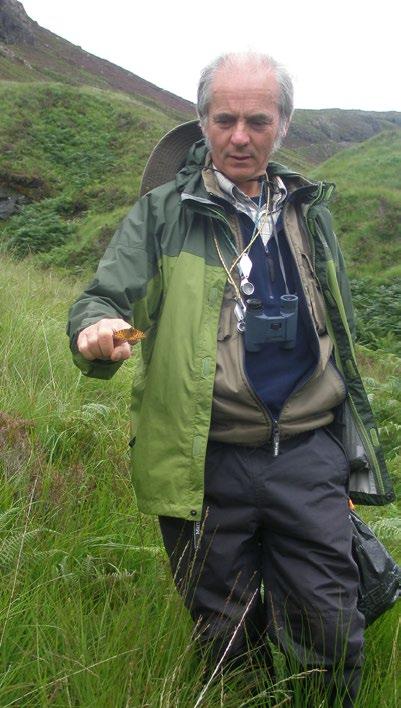
they married in December of that year. They moved to Gifford in East Lothian in 1986 when Alistair took a job as assistant Countryside Ranger at John Muir Country Park, and then in 1989 to Luncarty, near Perth, when Alistair became a Countryside Ranger with Perth and Kinross Council (PKC).
66 BSBI NEWS 156 | Spring 2024
Alistair Godfrey, with a Dark Green Fritillary, near Tobermory, Mull, August 2013. Lynne Farrell
Their daughter Margaret was born in 1994. Alistair and Rhona parted in 2003 but remained friends.
Alistair was a Countryside Ranger with Perth and Kinross Council for 13 years, followed by 10 years managing PKC’s Countryside Ranger Service, its countryside sites and infrastructure. He spent the final two years with PKC working on environmental projects, retiring in 2014. During his time with PKC he wrote woodland management plans for several popular sites, including Kinnoull Hill, the Den of Alyth and the Birks of Aberfeldy, all SSSIs, and he was involved with the Council’s Forest Plan 2015–2035. He wrote the first management plan for the Inner Tay Estuary Local Nature Reserve and the draft for Perth Lade Management Plan 2011–2031, which became part of the Council’s Local Development Plan. He managed and reported on a volunteer project between 1994 to 1996 setting up transects in Perth and Kinross to examine interrelationships between Red and Grey Squirrels. As would be expected, during his time with PKC he was on many committees, including The Tayside Biodiversity working group.
A major achievement, working with Scottish Natural Heritage, the Rural Access Committee for Kinross-shire and others, was planning and establishing a long-distance trail around Loch Leven National Nature Reserve. The 21 km Loch Leven Heritage Trail now attracts over 200,000 visitors annually to the area without disturbing the outstanding wildlife around the loch.
Conservation and protection of important habitats had always been important to Alistair and much of his personal research and writing was concerned with this. He wrote an outstanding report on Glenquey Moss. This scenically beautiful area was threatened by a planning application to quarry aggregates from under the moss. His detailed species survey, mapping the complex NVC communities covering the site, proved that Glenquey Moss is a growing phase raised bog, recovering after grazing levels had been reduced. The Environmental Assessment produced by the developer described the area as degraded, heavily grazed acid grassland. His survey was instrumental in obtaining the ultimate
refusal of the quarry application by Scottish Government. He also become involved in another controversial planning issue when he wrote a very well-informed objection to the application for a golf course at Coul Links in East Sutherland, a Ramsar, Special Protection Area and SSSI. The application threatened an extensive natural sand dune system, one of the few remaining in Scotland. It was rejected by Scottish Government. Sadly the application for a golf course was resubmitted in 2023 in a slightly different guise and the fight to save Coul Links continues today.
Alistair worked closely with the Friends of the Ochils. Both were very concerned about the number of applications for forestry planting, without any assessment of their combined impact, on the Ochil Hills. He wrote detailed reports, provided lists of records from the BSBI database and carried out botanical surveys where data was missing. Single handedly, he carried out a comprehensive survey of the extent of peat on hill tops in the Ochil Hills, a daunting task when there is no easy access by roads. He showed the extent of deep peat in the centre of the Ochils is far greater than originally thought. His concern was that disturbance by ploughing areas of peat will release carbon into the atmosphere and contribute to climate change, nullifying any benefits from planting trees.
Alistair deserves special recognition for his investigations of the historical ecology of local woodlands near his home, carried out in response to house and road building proposals. In particular, his 2018 study of the woods and wetlands at Bertha Park, Redgorton, 176 pages long, is better informed and more interesting than the brief and superficial report produced by the consultants paid by the developers. Around the same time, he also produced a shorter study of one of the woodlands on the outskirts of Scone. Reports of his studies of two woodlands near Methven and Den of Methven were the last of numerous articles he wrote for the PSNS Bulletins, which are all available to download from the PSNS Publications page www.psns.org.uk/ psns-history
BSBI NEWS 156 | Spring 2024 67 OBITUARIES
OBITUARIES
Alistair’s botanical knowledge was exceptional. He was never off-duty in the sense that he invariably found all aspects of nature of endless interest. His work and his play were the same thing. His daughter Margaret remembers that every weekend as a child she was taken up a hill, or along a riverbank, on the pretext of getting fresh air, really so that he could look at plants. Material possessions were not important to him, but over the years he built up a magnificent library of natural history books and classical music CDs. He had a TV licence, but never had a TV, watching films on his laptop from his vast collection of old films on DVD. He left his extensive collection of natural history books to the PSNS Library.
Alistair was joint BSBI Vice-county Recorder for Mid Perthshire (v.c. 88) from 2003, with Jim McIntosh, and during this time he also served on the BSBI Committee for Scotland. To maximise coverage, as v.c. 88 is the fourth largest vice-county in Scotland, Alistair and Jim usually recorded separately, Jim in the west and north of the county and Alistair in the south and east, although they did go out together on many BSBI and PSNS outings. One memorable recording week, spent with Tim Rich and Dan Watson in July 2018, was based in a cottage at the very west end of Glen Lyon, recording for Atlas 2020 in some of the most remote areas in the north of the county. They collected records from 21 tetrads in 5 hectads and made 34 new hectad records, all above 1000 feet, over rough terrain, exploring summit ridges and high corries. Jim recalls that Alistair was always generous with his time and expertise and became very good at getting to grips with tricky groups such as roses and eyebrights.
Neale Taylor, who has succeeded Alistair as joint recorder for v.c. 88 with Jim, is cataloguing Alistair’s herbarium. He says that Alistair developed an interest in a number of more difficult plant groups during his vice-recordership and had productive relationships with several specialists in critical species. Perhaps the most notable was that with the Euphrasia expert Chris Metherell, with whom he spent a recording week on Shetland in 2016 looking at some of its more noteworthy Euphrasia species. He built up his own herbarium for the vice-county of around 700 specimens, including an extensive Taraxacum collection which he had not yet completed, as well as species and hybrids of roses, willows and of course eyebrights. With his meticulous nature it is no surprise that his interests led to an extensive but as yet uncatalogued moss collection. Once the collections have been fully curated it is hoped they can reside in a suitable institution such as the herbarium in Perth Museum.
Alistair is best remembered in Perthshire for his close connection with PSNS. He was chair of the Botanical Section of PSNS from 2000. Accounts of all the excursions led by him can be found in PSNS Botanical Bulletins, and are available on the PSNS Publications page. These are a tribute to his expertise, dedication, love of nature and writing ability.
My grateful thanks to all his family and friends who have helped me write this account of his life and achievements. He is much missed. His industry has left a magnificent legacy to Perthshire botany and hopefully, one day, his records will form part of a second Flora of Perthshire.
Liz Lavery
68 BSBI NEWS 156 | Spring 2024
ELIZABETH JANE (LIZ) McDONNELL (1946–2022)
The Somerset botanist Elizabeth Jane McDonnell (née Rose), universally known as Liz, died on 30 October 2022 at the age of 76. It is impossible to convey the deep sense of sadness and loss that so many of us have felt, and we know that the grief still lingers for those who were closest to her. Liz was such a good friend to so many people, and probably each of us, in one way or another, has had to learn how to keep going while carrying a Liz-shaped hole inside us.
Liz was Somerset through and through. For much of her life she lived in or close to Wedmore, on the edge of the Somerset Levels. She was born on 20 May 1946 at Moor End Farm, Cocklake, the third of four children. Her father, Cuthbert, dabbled in farming but during and after the Second World War he cycled from Cocklake to Cheddar each week to catch the train to London and Chelmsford where he worked as an aeronautical engineer. Cuthbert had been born in Wookey Hole, and he and the family would make annual spring-time pilgrimages by pony and trap to Ebbor Gorge, to marvel at the primroses and bluebells. Another favourite family destination was Nyland Hill, between Wedmore and Cheddar – a place where, more than half a century
later, Liz would be thrilled to discover a tiny colony of Gastridium ventricosum (Nit-grass).
At Moor End, the Rose family had a large garden where they grew fruit and vegetables and kept chickens, ducks and geese. As a small child Liz learnt from her mother, Margaret, the names of many garden plants as well as a varied assortment of common hedgerow and wayside ‘weeds’. She attended primary school in Wedmore, then in 1957, Hugh Sexey’s Grammar School in nearby Blackford. Her strong artistic leanings were already apparent as a child, probably encouraged by her mother who was herself an enthusiastic artist and craftswoman. In 1963 Liz enrolled at the Somerset College of Art, Taunton, for a pre-Diploma year, before heading off to London to Hornsey College of Arts and Crafts (1964–67) where she studied for a Diploma in Art and Design. Here, her interest in spinning, weaving and dyeing was encouraged by the textile artist and inspirational teacher Marianne Straub.

Liz married Richard McDonnell in 1967, and they had two children, Shap and Katy. For two years from 1970 Liz had a part-time post at Basford College, Nottingham, where she taught weaving and dyeing, but she soon moved back to Somerset, living briefly in Butleigh before returning to her roots, first at ‘Dungeon Cottage’, Cocklake, then much later at ‘The Old Gas Works’ in Wedmore. Richard would become an archaeologist of considerable renown, while Liz –busy raising a family – began to explore her own growing interest in gardening and botany. Her sister wonders whether Liz’s enthusiasm for botany developed, in part, as a result of her interest in plant dyes; as does Richard, who notes that her early fondness for lichens, in particular, could have been spurred on by their usefulness in dyeing.
BSBI NEWS 156 | Spring 2024 69
OBITUARIES
Liz McDonnell, in her van on the Somerset Levels, 2016. Ro FitzGerald
Liz joined the BSBI in 1978. As her interest in plants grew, so did her concern for their conservation. At some point in the late 1980s she became involved with the Somerset Environmental Records Centre, working either as a volunteer or on short-term and/or part-time contracts when it was based at Hestercombe, near Taunton. Liz joined Plantlife soon after it was formed in 1989 and it was the launch of its ‘Back from the Brink’ programme in 1991 that really opened up further employment opportunities for her. Between 1994 and 2000 she carried out detailed surveys of Rumex rupestris (Shore Dock) in Devon and Cornwall. She authored or co-authored a series of reports and papers on this species (e.g. Daniels et al., 1998; McDonnell & King, 2006) as well as the Red Data Book accounts for R. rupestris and Hypericum linariifolium (Toadflax-leaved St John’s-wort) (Wigginton, 1999). She helped, too, with work on the Axbridge population of Carex depauperata (Starved Wood-sedge) at around this time.
In the early 1990s Liz also began to be employed on summer fieldwork contracts monitoring mainly grasslands within Environmentally Sensitive Areas (ESAs), e.g. on Exmoor, the Blackdown Hills and the Somerset Levels. This work surely helped her in finally securing permanent employment in the early 2000s as an ecological adviser with the newlyestablished Rural Development Service, including a period ‘on loan’ to English Nature, and then latterly with Natural England until her retirement in 2010.
From the early 1980s onwards Liz became a familiar and friendly face at BSBI Annual Exhibition Meetings and field meetings. And she went on to lead a number of well-attended and very successful BSBI field meetings in Somerset. Her concerns about plant conservation led her to serve on the BSBI Conservation Committee from 1990 to 1996, and later, between 2000 and 2007, on Records Committee. In 1997 she was appointed by BSBI to coordinate the Society’s contribution to the Millennium Seed Bank Project.
Also in 1997, Liz was instrumental in the establishment of the Somerset Rare Plants Group (SRPG). By then she had already contributed many plant records to The Atlas Flora of Somerset (1997),
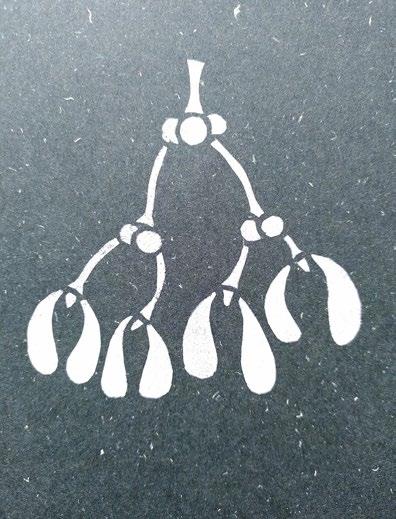
but she felt there was a need for repeat surveys and monitoring of rare plants in the county, as well as square-bashing in under-recorded areas for the BSBI’s ‘Atlas 2000’ project. She was the first to advocate the production of a Somerset ‘Red Data Book’ or Rare Plants Register, and this new group, she imagined, would provide exactly the sort of information that such a publication would require. Over the years the SRPG has gone from strength to strength, with Liz very much at its helm. With Steve Parker as chair, she acted as the group’s ‘coordinator’ for many years and edited its annual newsletter between 2013 and 2017.
Perhaps surprisingly, it wasn’t until 2015 that Liz became a Vice-county Recorder, assisting Helena Crouch in North Somerset (v.c. 6). Yet across a span of more than 30 years her contribution to botanical recording in Somerset was immense. Delve into the Somerset MapMate database, and you’ll discover her name attached to more than 125,000 records. She must have led or co-led at least a hundred SRPG field meetings, as well as arranging numerous
70 BSBI NEWS 156 | Spring 2024
One of Liz McDonnell’s homemade Christmas cards (2020). Simon Leach
OBITUARIES
training days and workshops on difficult groups. Liz was a skilled teacher: perhaps the fact that her botany was largely self-taught gave her an instinctive ability to explain things in simple terms. She was a very ‘visual’ person, and when identifying plants in the field she’d often see useful characters that others might miss. Sometimes, when explaining floral or fruiting structures, like a magician she would produce handmade props constructed from felt and cardboard – just one of many instances where her botany and her passion for arts and crafts worked hand in glove. Beginners would tend to gravitate towards her as they knew that she would be happy to spend time going over the reasons why a plant might be ‘x’ rather than ‘y’. Nothing seemed to be too much trouble, and her enthusiasm was infectious.
Liz supported other local groups, too, such as the Somerset Botany Group and Mendip Flora Group, she led wild flower walks for Mendip AONB, and for SRPG she organised targeted surveys of scarce or under-recorded species such as Ophioglossum vulgatum (Adder’s-tongue Fern), Spiranthes spiralis (Autumn Lady’s-tresses) and Lathraea squamaria (Toothwort). All this, plus a whole host of other interests and activities – the ‘Green Wedmore’ group, repair cafes, her allotment, Wedmore Arts Festival, drawing and painting and making things, producing her own greetings cards – as well as precious time spent with family and friends and trips abroad, to places like Sweden, Poland and Iceland.
Liz was always keen on pressed plants, and this was clearly another point of convergence between her twin passions, since a carefully pressed herbarium specimen was, for Liz, both a scientific document and a work of art. The herbarium in the Somerset County Museum in Taunton (TTN) was of particular interest to her, containing, as it did, thousands of specimens collected within the county – many of them, as she soon realised, of considerable scientific and historical value. Yet the collection was uncurated and in a poor state of repair, many of the sheets stored ‘loose’ in cardboard boxes or in bundles tied together with string. So, with the development of the Castle Museum and the removal of the natural history collections – herbarium
included – to a new out-of-town facility, Liz seized the opportunity, pulling together a small team of herbarium volunteers and hatching a plan with the then natural history curator, Dennis Parsons. Work began in the spring of 2015 to check on condition of the specimens, to photograph the sheets for eventual uploading to the Herbaria@Home website and then to arrange the collection in ‘Stace 3’ order before rehousing them in purpose-built cupboards inherited from the National Museum of Wales, Cardiff.
The herbarium project, as originally envisaged, was completed by spring 2017 (McDonnell & Salmon, 2017). But there was now the question of finding a home for the hundred or more Taraxacum (Dandelion) specimens collected during a BSBI training weekend. This opened the gates to a steady stream of new material: not just dandelions, for which TTN now holds over 700 specimens of more than 170 species, but also many other difficult groups such as hawkweeds, willows, rock sea-lavenders, knotgrasses, whitebeams and eyebrights. Thanks in large part to Liz’s persistence and energy – and zeal – the herbarium that had been lying dormant a decade earlier was now very much alive and kicking.
And then the pandemic struck. In the months before the first lockdown in March 2020, Liz boxed up and put the finishing touches to a collection of her own specimens that she then donated to the herbarium. There were a few odds and ends still to be worked on, which she would tackle later, at home, during lockdown. For two years the natural history collections were closed due to the pandemic. By the time they reopened, in the spring of 2022, Liz was already unwell, and would soon be diagnosed with lung cancer. With treatment underway, though, she remained hopeful that once she felt better she’d be able to pick up where she’d left off two years earlier. Very sadly, that wasn’t to be. And it was almost a year after Liz’s death that those last sheets of specimens – the ones she’d been working on during lockdown – finally joined the rest of the collection that she had given to the herbarium in 2019.
What, we wonder, would Liz most like to be remembered for? Would it be her discovery of Carex filiformis (Downy-fruited Sedge) on Cheddar Moor
BSBI NEWS 156 | Spring 2024 71
OBITUARIES
OBITUARIES
in 2003, very much on her home patch, and the only modern record in Somerset of this rare and threatened species? Or maybe the Agrostis curtisii (Bristle Bent) that she spotted on Black Down, Mendip, in 2008 – a first record and sole locality for this species in v.c. 6? Or the Fallopia dumetorum (Copse Bindweed), found with her good friend Clive Lovatt near Nailsea in 2016, the second record for Somerset, the only previous one having been in 1836? Or what about the first record in Britain of the North American Juncus polycephalus (Manyhead Rush), found at Steart Marshes in 2014?
Or maybe it wouldn’t be the records at all, but instead just the sense of companionship, and memories of long days spent happily in the field in the warm embrace of friends. And a flask of coffee, and a slice of homemade cake, and a joke or two.
Acknowledgements
Many thanks to Shap and Katy for sharing their memories and for kindly reading and commenting on a draft of this account. We are also grateful
to Richard McDonnell and Liz’s sister Margaret Tinney for biographical notes, and to her many botanical friends, too numerous to list here, who were happy to share with us their recollections of a life well lived.
References
Daniels, R.E., McDonnell, E.J. & Raybould, A.F. 1998. The current status of Rumex rupestris Le Gall (Polygonaceae) in England and Wales, and threats to its survival and genetic diversity. Watsonia 22: 33–39.
McDonnell, E.J. & King, M.P. 2006. Rumex rupestris Le Gall (Shore Dock) in S.W. England: review of recent surveys and assessment of current status. In: Leach, S.J., Page, C.N., Peytoureau, Y. & Sanford, M.N. (eds), Botanical Links in the Atlantic Arc, pp. 211–215. BSBI.
McDonnell, Liz & Salmon, I.[T.] 2017. Recent work on the SANHS Herbarium, held at the Somerset Heritage Centre, Taunton. Somerset Archaeology & Natural History 160: 214– 216.
Wigginton, M.J. ed. 1999. British Red Data Books. 1. Vascular Plants, edn 3. Joint Nature Conservation Committee, Peterborough.
Simon Leach and Ro FitzGerald
CHRISTOPHER DONALD PIGOTT (1928–2022)
Our long-standing member Donald Pigott died on 11 September 2022. He joined the BSBI’s precursor, the Botanical Society and Exchange Club, in 1945. He was an outstanding botanist, particularly as a plant ecologist but with strong research skills in taxonomy, cytology, vegetation history, soil science and plant geography. He was also active in conservation. His first publication in 1951 was in Watsonia about the discovery of Scutellaria hastifolia (Norfolk Skullcap) in Britain. He published occasionally in Watsonia and BSBI News. He was very involved (1955–59) in the BSBI Committee responsible for the preparation of the 1962 Atlas of the British Flora, and he undertook the onerous task of editing all the maps. He

72 BSBI NEWS 156 | Spring 2024
Donald Pigott, The Valais, Switzerland, 1946.
also served as the BSBI referee for Thymus (thyme) and Tilia (lime).
Donald was born in Sutton, Surrey on 7 April 1928, the son of Helen (née Lee) and John Pigott, a mechanical engineer and subsequently a tea importer. Helen was not only a gifted pianist but also very interested in plants. She taught Donald from an early age how to identify plants. He attended Mill Hill School in north London but in World War II the school was evacuated to Cumbria. He became fluent in German whilst recovering from tuberculosis in a Swiss sanatorium in the early days of antibiotics. In 1946 he won an Open Exhibition in Natural Sciences at Emmanuel College, Cambridge where he read Botany, Chemistry, and Geology in Part I of the Natural Sciences Tripos (1946–48). He was awarded a Major College Scholarship in 1947, and the Shell Scholarship in Geology and the Frank Smart Prize in Botany in 1948. He read Botany in Part II of the Tripos (1948–49), gaining a First and being awarded the Frank Smart Studentship in 1949. For his PhD, Donald studied the taxonomy, ecology, cytology and biogeography of the three native species of Thymus in Britain and Ireland under the supervision of Sir Harry Godwin. Donald was part of the outstanding group of young Cambridge botanists in the early 1950s including Max Walters, Michael Proctor, David Coombe, Franklyn Perring and Peter Sell. At the suggestion of Max, Donald visited Uppsala and Helsinki in the summer of 1949 where he became acquainted with work on mapping vascular plant occurrences in Europe. In his 1955 Biological Flora of Thymus, Donald published the first distribution ‘dot’ maps using 10 × 10 km grid squares that became a ubiquitous mapping standard for British and Irish biota. He found that it was impossible to produce an adequate map of the common Thymus drucei (Wild Thyme) using herbarium material alone, and this was a fundamental consideration when the methodology of the BSBI Maps Scheme was developed.
One of Donald’s teachers in Cambridge was Max Walters who was immediately impressed not only by Donald’s enthusiasm for plants and his ability to name them but also by his excellent botanical
drawings. They became friends, made many joint excursions, and published together. As research students, Donald and David Coombe were asked to assist in the design of the Cambridge University Botanic Garden’s ecological ‘limestone mound’, in the choice of native plants to be planted, and, together with Max and others, in collecting material from the wild.
In 1951 Donald moved to Roy Clapham’s Department of Botany at the University of Sheffield to be an Assistant Lecturer and then in 1954 to be a Lecturer. Whilst in Sheffield, Donald studied various aspects of the ecology of Peak District woodlands and grasslands, including the detailed ecology of Polemonium caeruleum (Jacob’s-ladder) and Cirsium acaule (Dwarf Thistle). He also published two ‘classic’ papers – one with Max Walters on plants with discontinuous distributions in Britain and Ireland (e.g. Helianthemum oelandicum, Hoary Rockrose) and one on the vegetation of Upper Teesdale. He also started detailed studies on soil formation and development on the Carboniferous limestone of Derbyshire.
Donald returned to Cambridge in 1960 to be a University Lecturer in Botany and in 1962 a Fellow and College Lecturer at Emmanuel College. Besides his outstanding teaching, Donald’s research was mainly on plant-soil interactions with doctoral students P.S. Lloyd, M.H. Martin and S.J.P. Waters. Michael Martin and Donald worked in Hayley Wood, 12 miles (19 km) west of Cambridge. As a result of this work in the wood, Donald became aware that the owner was thinking of selling it to a Bedfordshire timber merchant to have it cleared. Donald persuaded an initially reluctant Cambridgeshire Wildlife Trust to launch an appeal to buy the wood for £5000, and it became its first reserve. In 1962 Oliver Rackham, who at that stage was working for his PhD on the energy balance of leaves using his training in mathematics, physics and botany, visited Hayley Wood with Donald. Oliver became totally fascinated by the wood and its history and went on to publish a book about Hayley Wood in 1975.
BSBI NEWS 156 | Spring 2024 73
OBITUARIES
OBITUARIES
In 1964 Donald was invited to be Professor of Biology within the newly created University of Lancaster. He served as Head of Department until 1978 and continued as Professor until 1984. He instigated one of the first undergraduate degrees in Ecology which involved both the Biology and Environmental Sciences departments. Developing the Biological Sciences Department from scratch was a very demanding challenge and it involved a considerable amount of administrative and committee work. Donald also became increasingly involved in many national and international committees. He led the National Vegetation Classification (NVC) project supported by the Nature Conservancy Council (1974–81) along with Derek Ratcliffe, Michael Proctor, Andrew Malloch, and others including myself. He served on the Council of the National Trust (1980–86), providing the Trust with ecological advice. Despite all these commitments, Donald maintained his research on a range of ecological topics, particularly the ecology, history and reproductive biology of Tilia cordata (Smallleaved Lime), growing near its north-western range limit in Britain.
Donald returned to Cambridge in 1984 to be Director of the Cambridge University Botanic Garden and Professorial Fellow at Emmanuel College. This was at the time the Garden was seriously threatened by financial cuts. Shortly after he became Director, a gale and the Great Storm of 1987 blew down many trees including some of the foundation trees that had been planted in 1846. Donald and his garden staff almost welcomed the challenge of planting new trees, including some limes. Another challenge was to renovate the ecological ‘limestone mound’ that he had helped design and stock over 30 years earlier. In 1990 the University conducted a five-year review of the Garden to assess ‘future funding, management and constitutional position of the Botanic Garden’. The review proposed that after Donald’s retirement in 1995, the Garden would become a City Park, thus losing much of its scientific and research status. Donald vigorously defended the Garden’s status as a local, national, and international resource and convinced the Review Board that the
Botanic Garden should remain as part of the Botany School (renamed Department of Plant Sciences in 1991). Donald was delighted when his successor John Parker was appointed as John was also an academic botanist and would continue to grow plants in the Garden for research purposes.
Donald retired in 1995 and settled in Greenbank near Cartmel. He developed a fine garden there with an arboretum of 20 Tilia species, including one described by Donald, T. concinna Pigott, from China. He and his wife Sheila travelled widely in Europe, Asia, North America, and Mexico to observe different Tilia species in the field. In 2012 he published his major monograph, Lime-trees and Basswoods – A Biological Monograph of the Genus Tilia, illustrated with his elegant and accurate drawings. It presents a revised taxonomy of 23 species and 14 subspecies world-wide, along with details of their cytology, distribution, variation, ecology and history. In 2020 Donald published his last scientific paper, appropriately the Biological Flora account of T. platyphyllos (Large-leaved Lime) to accompany his 1991 account of T. cordata
In addition to all his university work and research, Donald was deeply involved in conservation matters, in particular the controversial proposal from ICI in 1964 to construct the Cow Green reservoir in Upper Teesdale. He appeared as an expert witness to the
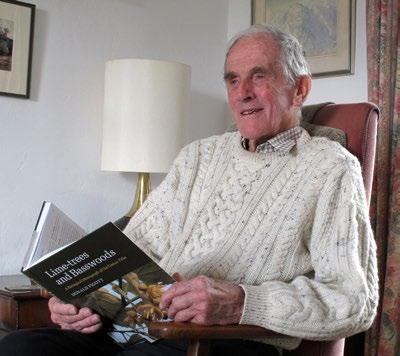
74 BSBI NEWS 156 | Spring 2024
The author with the newly published Lime-trees and Basswoods, 2012. Joan Futty
Parliamentary Inquiry that reviewed the proposal. Although its construction was not prevented, the controversy possibly served as a turning point in conservation by highlighting the real need to give more weight to environmental issues in the planning of major construction projects. ICI never, in fact, used a single litre of water from the reservoir!
Donald was also involved in a campaign to save the wonderful limestone pavement at Gait Barrows in north Lancashire. This led to the area being designated a National Nature Reserve in 1977. In 1981 the area received additional protection with the creation of Limestone Pavement Orders which made it a criminal offence to remove any part of the limestone.
Donald published one major book (2012) and a small book on Lime trees (2005), over 100 scientific articles and book chapters (1951–2020), and many book reviews as well as being a co-editor of the five NVC volumes (1991–2000). He was an editor of the Journal of Ecology’s Biological Flora series for over 25 years (1958–84) and published accounts of seven species over a period of 65 years from 1955 to 2020. He was an editor of the New Phytologist for over ten years (1964–75). His early plant specimens are in the Cambridge University herbarium and his meticulous later collections and detailed field notes are being deposited at the Royal Botanic Garden Edinburgh. He was the last ecologist to have demonstrated his
OBITUARY NOTES
Since we compiled the last Obituary Notes, news has reached us of the death of the following members or former members. We send our sympathy to their families and friends.
Dr R.G. Chaytor of Hexham, Northumberland, a member for 43 years.
Mr P. Cox of Yarm-upon-Tees, Yorkshire, a member for 12 years.
Mr C. Higginbottom of Derby, a member for 28 years.
research in the field (exclusion of sheep in Padley Wood, Derbyshire) to Sir Arthur Tansley, the father of British plant ecology.
Donald possessed an extremely powerful intellect and a prodigious memory, and he was always very kind and generous in sharing his encyclopaedic knowledge and insights about plants and their ecology, taxonomy, and history. He was a superb lecturer and teacher and excelled at encouraging students and research associates. He had a remarkable eye in the field, and this led to several of his unique field experimental studies. He made many major contributions to our understanding of the British and Irish flora, including the climatic control on species distributions, plant-soil relationships, mapping distributions, vegetation of Upper Teesdale and the Peak District, soil development, plant geography, vegetation history and woodland dynamics. He was a truly great botanist, plant ecologist and taxonomist, colleague, teacher, mentor and friend.
Donald was devoted to his first wife Margaret (née Beatson, died 1981), their daughter Julia, and his second wife Sheila (née Megaw).
I am grateful to Julia Pigott, Sheila Pigott, Lynne Farrell, Hilary Birks and Chris Preston for valuable information, images and/or memories, and to Cathy Jenks for her invaluable help.
H. John B. Birks
Mr R.D. Randall of Bath, Somerset, a member for 46 years, Rubus referee and former VCR for North Somerset.
Dr A.J. Silverside of Paisley, Renfrewshire, a member for 61 years and formerly VCR for Wigtownshire and referee for Euphrasia.
Chris D. Preston, Obituaries Editor
cdpr@ceh.ac.uk
assisted by the Membership Secretary, Gwynn Ellis
Date of compilation 5 March 2024.
BSBI NEWS 156 | Spring 2024 75
OBITUARIES
REVIEWS
Compiled by Clive Stace, Book Reviews Editor
Appletree House, Larters Lane, Middlewood Green, Stowmarket, IP14 5HB
cstace@btinternet.com
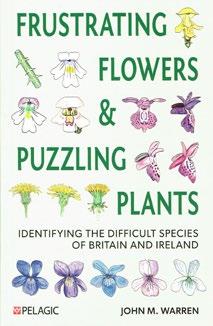
Frustrating Flowers and Puzzling Plants
John M. Warren
Pelagic Publishing, London, 2024 [2023].
Pp. xiii + 290, with numerous drawings & charts; pbk £35. ISBN 9781784273316
Most botanists know that the ease with which plants can be identified varies from simple to difficult in different groups. Frustrating Flowers and Puzzling Plants sets out to ‘explain why some groups of plants are complex and genuinely perplexing’, to provide ‘bespoke sets of tips to help identify plants’ and to be a ‘guide to splitting for lumpers’. The book is aimed at novice botanists, and aims to help those with a bit more experience to tackle unfamiliar groups.
There are five main sections grouping taxa with broadly similar identification problems – apomicts, hybrids, inbreeders, polyploids and successful families with lots of species. Each of the
23 chapters attempts to explain why a particular group is difficult; this is then broken down into smaller groups with tabular keys and sometimes thumbnail line drawings of selected plant parts and short descriptions. Some historic context and cultural information is given, followed by recommendations of how far to split each group. There is a very short glossary and an index. There is no bibliography but some references are cited in full in the text. It does not claim to cover all difficult groups and some, such as grasses and sedges, are not included at all.
To a novice, the book certainly looks tempting and accessible, is nicely presented and the tabular keys seem simple. Dig a bit deeper and try to use it, and the problems will soon become apparent.
The first frustration is with the introductory reviews explaining why some groups are difficult, which are often either oversimplified or simply wrong. For example, in Sorbus, Warren suggests that ‘there are around 16 species that only occur in the British Isles. In fact, the genus Sorbus contains more endemics than any other’. In actual fact there are 37 endemic species of Sorbus and at present 332 endemics are recognised in Hieracium alone. In Fumaria the suggestion that black tips to the flowers are ‘unhelpful’ I suspect arises from confusion of the black tips of lateral petals (present in all species) with those of the upper petals. The difference between
the northern European treatment of apomictic Hieracium and that of central Europe is that the latter attempts to explain the origins of taxa whereas the former does not; Hieracium taxonomy has never been a particular compulsion in Britain alone, and has nothing to do with Brexit (or was that supposed to be a joke?).
The second frustration arises from the over-simplification of botanical terminology, presumably to make characters more accessible to novices, and Warren often makes up his own terminology. This results in undefined terms such as ‘droplet-shaped’ fruits (globose or ovoid?) or ‘parallel’ sepals (linear or appressed?). The tables are rife with relative terms for which one needs to know both character states (which he rarely defines). For example, in Viola, the petiole hairs may be ‘long’ or ‘short’ – how long is long? There is also lack of precision in use of words. In Myosotis, the first heading in the tabular key ‘Ratio of flower stem to flower length’ I think actually means ratio of pedicel to fruiting calyx length. Botanical terminology has been developed for a reason – to convey information clearly and concisely, which is why it is used with detailed glossaries and explanations of terms – why reinvent the wheel and make it square?
The third frustration arises from the numerous errors throughout, too many to document. For example, in the tall yellow crucifer tabular key, 11 out of 19 species
76 BSBI NEWS 156 | Spring 2024 REVIEWS
are wrongly scored for the hairy leaf character. A bespoke tip for docks is that they are ‘separated on the morphology of their seed capsules’; docks don’t have capsules, but achenes surrounded by tepals. In the glossary, ‘entire’ is defined as ‘a leaf that is not divided into lobes’. Some of the thumbnail drawings are quite good (for example Brassica and Barbarea), whilst others such as Sorbus are useless (some wrong shapes and veins drawn as opposite pairs).
The fourth frustration is how far he recommends splitting groups. For groups such as umbellifers and Viola this is to species just like other Floras, but in others it varies. For brambles he gives only a few selected Sections which he mixes and muddles with Series (a lower infrageneric rank), then he gives one or two typical species which presumably we can split off but only if it actually is that typical species; the claim that using his guide we can identify 60% of brambles to species-level is ludicrous. It is as bad in Hieracium, which he splits into three meaningless groups of his own construct, putting back the taxonomy 350 years to pre-Culpepper who apparently included eight taxa in his 1658 herbal.
The book has clearly arisen out of Warren’s personal frustration with existing Floras, but it does not solve the need to understand botanical terminology. There is also a wider disconnect in understanding taxonomy throughout the book, as illustrated by Warren’s statement ‘dichotomous keys implicitly assume that species evolve like the branches of a tree’; they do not – virtually all modern keys are artificial just to get a name, natural keys reflecting relationships have not been used in Britain for
decades. This book is not a place to learn anything about plant taxonomy.
Overall I am left frustrated and puzzled by the numerous idiosyncrasies, misconceptions and errors. Believe me, it is much easier to identify plants by learning to use the appropriate terminology in standard texts with their full plant line drawings, colour photographs, detailed precise botanical descriptions, keys and glossaries – just like those the BSBI and others have been publishing for years – than to use this book.
Tim Rich
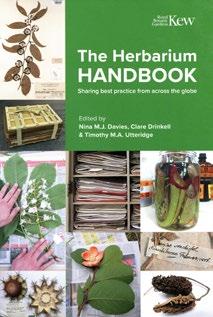
The Herbarium Handbook [Edition 4]
Nina M.J. Davies, Clare Drinkell & Timothy M.A. Utteridge (eds). Kew Publishing, Royal Botanic Gardens, Kew, 2023. Pp. x + 290, with numerous drawings & coloured photos; pbk £24.99.
ISBN 9781842467695
The first edition of this valuable book appeared in 1989 (authored by Diane Bridson and Leonard Forman) and was an immediate success. It gave incredible detail of the best practice used at Kew, though readers joked about the critique of the different sorts of paperclips
available and preferred. For me, at that time curating Reading Universities’ herbarium, I found it was somewhat out-of-date ignoring computer uses, as other herbaria were already well ahead of Kew in the digitisation of herbarium specimens and their data. Kew originally decided that it would not go down that route with so many specimens; it feared this was an impossible job and one for which it did not have resources.
Although it is advertised as the fourth edition, no mention of this is actually made in the book. It does have a whole section on digitisation with helpful workflows and recommendations (pp. 156–167). Having worked with the Taxonomic Database Working Group, now Biodiversity Information Standards, I had expected the importance of the work by Dr Dick Brummitt of Kew on creating and developing the standards currently accepted for country and geographical spellings (in conjunction with The Times Atlas) and abbreviations of botanical authors of plant names to have been more fully dealt with. Querying and exchange of herbarium and plant data relies on a single agreed spelling.
I read this book with great interest and was delighted to find that the editors had taken a very different approach, having invited a very large number of authors from around the world to write chapters, or just a page, so that the book covers the many different scenarios that herbaria find themselves in. The huge number of useful colour illustrations and ‘boxes’ of data and tips is a welcome and valuable addition that gives the book a thoroughly modern feel and an international relevance. The book does not outline how to make an effective plant press
BSBI NEWS 156 | Spring 2024 77 REVIEWS
and makes no mention of wire Polish presses which are efficient in hot dry climates and save changing drying paper and time. (‘How to make a plant press’ is concerned with the actual process of pressing.)
Preventing specimen damage due to pests of various sorts is a major problem in herbaria, which formerly used a range of severe measures such as the use of arsenic and mercuric chloride, now banned. Historically, Paris had used arsenic trichloride and had stamped their sheets with a skull and crossbones symbol. These methods can seriously affect later destructive tissue use, for instance in phytochemistry and DNA analysis, and, if such practices are used now, sheets should be annotated to record treatments. I would like to have seen rather more warning to specimen users than to simply wash their hands after using specimens.
I was pleased to see that the book deals with the subject of loans and indeed the whole business of moving specimens across international borders. Hopefully, the up-to-date information in the handbook will help stop illegal acts.
I was surprised that so little mention was made of bryophyte, lichen and fungal collections. I was also once responsible for these. Reading’s extensive bryophyte collections were filed in packets in metal drawers designed for 6 × 4 inch index cards (following the tradition at the Manchester Museum) rather than mounting six or more packets on a standard herbarium sheet (and perhaps having the need to cut the sheet up later following a redetermination).
It is necessary to use the good index to find your way around this handbook; although there
are sections, more or less each double-page spread is a separate topic, making the Contents three full, double-column pages. However, it is an essential reference for anybody working in herbaria (staff and students), visitors planning to use herbarium collections or simply needing a loan. This edition is so different and so updated that even if you bought the previous ones, you need to get this as well. I wish I had this available for students back in the day!
Stephen Jury
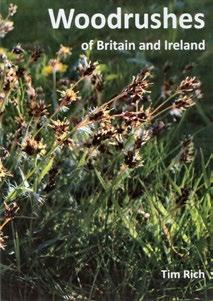
Woodrushes of Britain and Ireland
Tim C.G. Rich
Self-published, 2024. Obtainable from the author, tim_rich@sky.com. Pp. iv + 74, with many drawings, maps and coloured photos; pbk £10, Kindle edition £7. No ISBN
Woodrushes (Luzula DC.) are an easily recognised genus and contain few difficulties in the identification of our nine native and two alien species, one extra subspecies and two hybrids. Nevertheless, mistakes are often made by beginners, and also by those more experienced botanists who fail to examine their material with sufficient care, so this slim volume is a welcome addition to our literature.
In Woodrushes of Britain and Ireland, which closely resembles many of the twenty-four familiar BSBI identification handbooks, the author has presented us with detailed sets of data that should remove all excuses for misidentification of these plants. The first ten pages contain essential introductory material, including an explanation of characters, neatly summarised in a useful table of diagnostic features and two dichotomous keys to fertile and vegetative plants. Most of the rest of the book treats each of the taxa in turn by providing a detailed list of the characters (including plenty of precise measurements), followed by paragraphs on identification hints, taxonomic notes, and distribution and habitats (with dot maps of the British Isles). The text is illustrated by clear line-drawings and by many coloured photographs depicting everything from habit/ habitat to close-ups of seeds, etc. The photographs are well chosen, but their reproduction in several cases is poor, being too dark or with inadequate contrast. It is not clear whether this is due to substandard originals or printing. The only taxonomically contentious taxa are what Rich calls the L. multiflora group, which he interprets as L. multiflora, containing two subspecies, and L. congesta, which is often treated as another subspecies of the last. The fact that in Britain the distributions of L. multiflora subsp. multiflora and L. congesta coincide very closely suggests that more work would be welcome on their genetic relationship. This view is reinforced by the widespread presence of L. congesta in Ireland, where L. multiflora is represented only by subsp. hibernica. At present the relationships of these three taxa (and the other four foreign
78 BSBI NEWS 156 | Spring 2024 REVIEWS
subspecies of L. multiflora) is largely unknown. Luzula campestris is often confused with L. multiflora by inexperienced or casual observers, but the two are not closely related and there are many differences (not least the rhizomes of L. campestris). Hence the page distinguishing these two species is a valuable feature.
Woodrushes is an identification manual, not a taxonomic treatise, but this pedantic taxonomist regrets the absence of a listing of synonyms: L. pallidula can be attributed via the index, but L. albida, which is the name used in one of the references, is not mentioned elsewhere. Also, the two authorities of L. sylvatica are
not given in their correct standard forms.
The book ends with a glossary, a list of references and an index. It is a pleasure to read such a well-designed and detailed publication, which would enhance the library and assist the work of any field botanist.
Clive Stace
BSBI PHOTOGRAPHIC COMPETITION 2023
The winning entries and a few of the shortlisted submissions for the BSBI 2023 Photographic Competition are shown below. Details of the 2024 competition are on p. 59 and are given on the
webpage: bsbi.org/bsbi-photographic-competition, including the rules and links to see winning entries from previous years. See also David Steere’s shortlisted entry on the front cover of this issue.
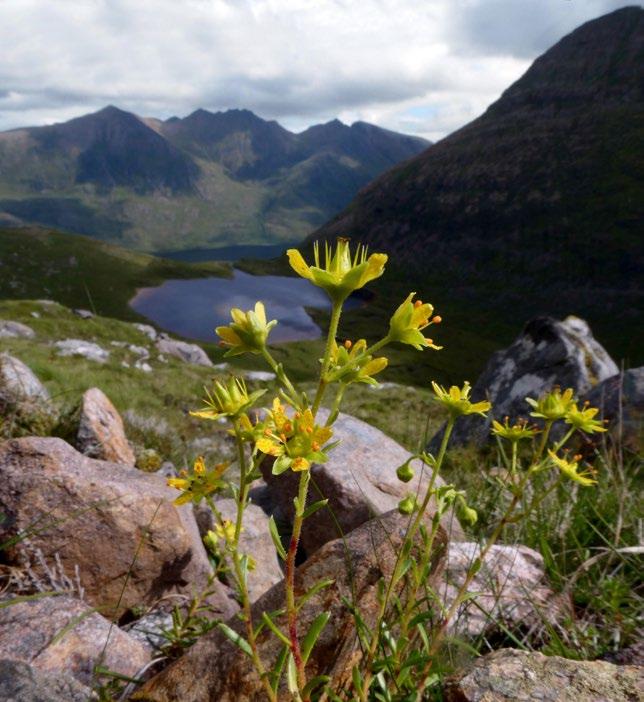
Winner
BSBI NEWS 156 | Spring 2024 79 REVIEWS / BSBI PHOTOGRAPHIC COMPETITION 2023
– Plants in the Landscape: Saxifraga aizoides (Yellow Saxifrage), Fisherfield. Bert Barnett
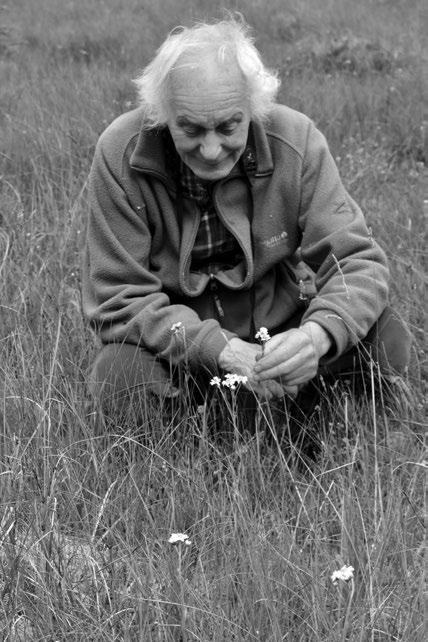
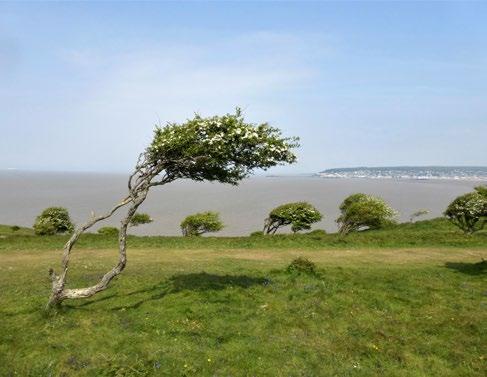
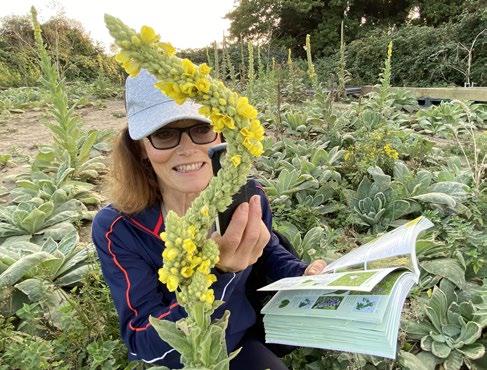
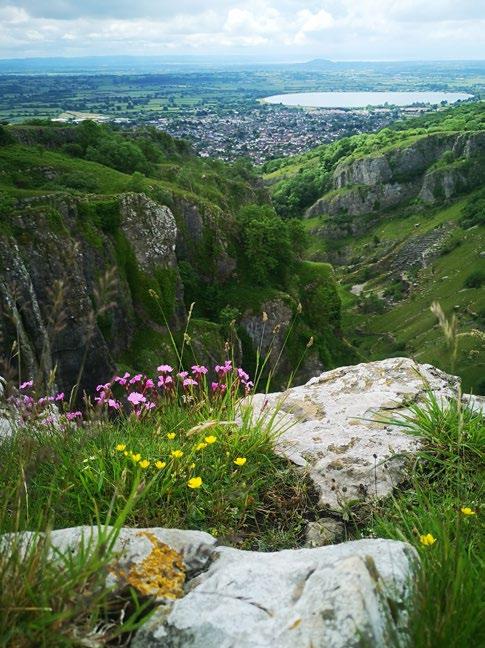
80 BSBI NEWS 156 | Spring 2024 BSBI PHOTOGRAPHIC COMPETITION 2023
Winner – Plants and People: Achillea ptarmica (Sneezewort), Perthshire. Philippa Swann
Shortlisted – Plants in the Landscape: Dianthus gratianopolitanus (Cheddar Pink). Patricia Gilroy
Shortlisted – Plants in the Landscape: Crataegus monogyna (Hawthorn). Margaret Webster
Shortlisted – Plants and People: Verbascum thapsus (Great Mullein), Braunton Burrows. Mary Breeds

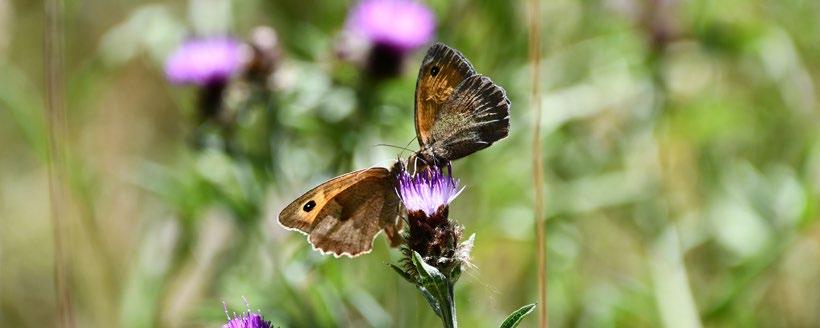
20% off courses
Use code ‘BSBI’ at checkout

Natural History Courses
Identification, ecology, and surveying courses written and delivered by experts. There are over 100 courses to choose from, covering botany, birds, butterflies, and more! Find a course at your local centre or join us online.

Visit our website to book www.field-studies-council.org/biodiversity-courses
Offer valid until 30th June 2024 . Excludes MMU courses.
Field Studies Council is a registered charity (no.313364 in England & Wales, SC039870 in Scotland)
